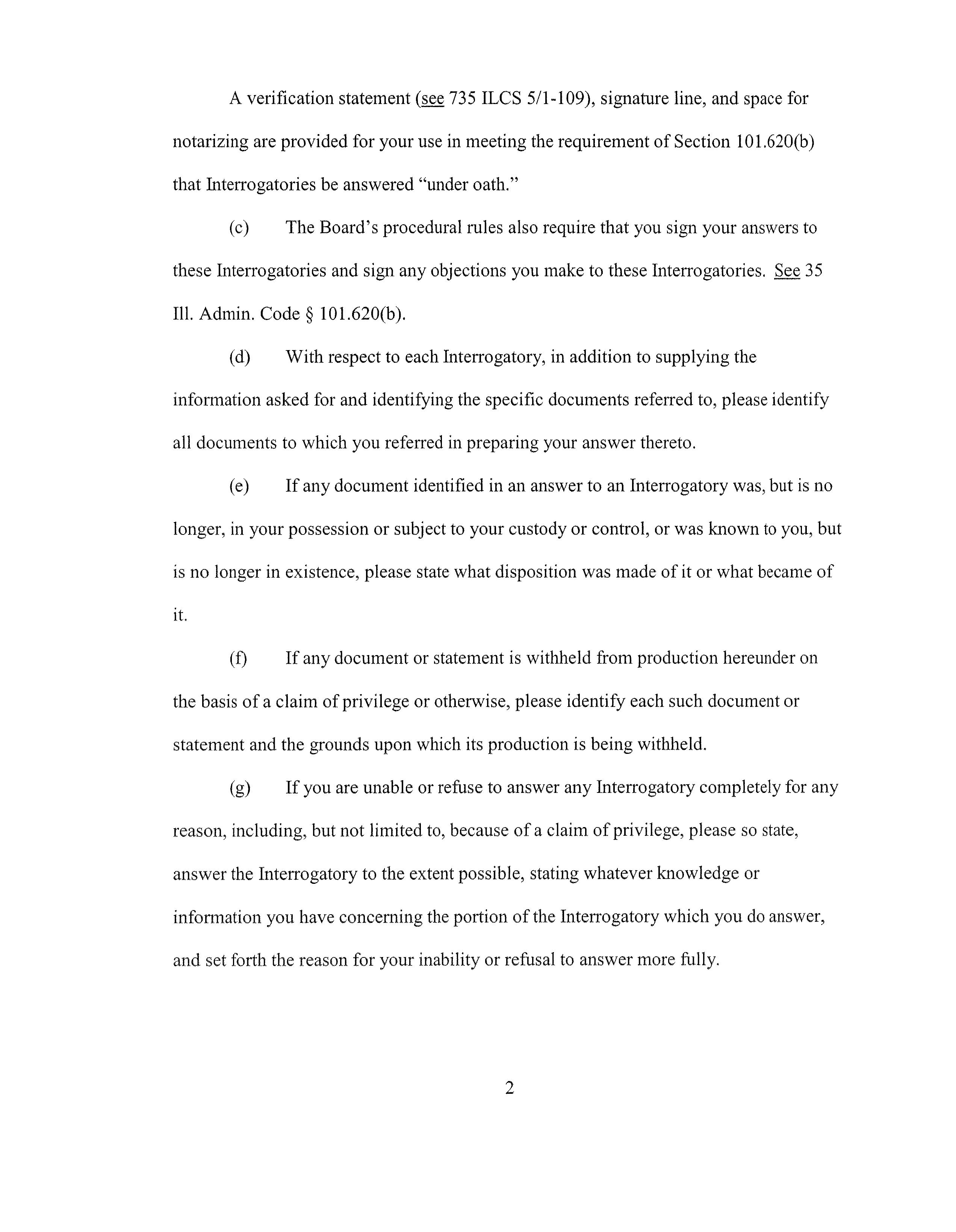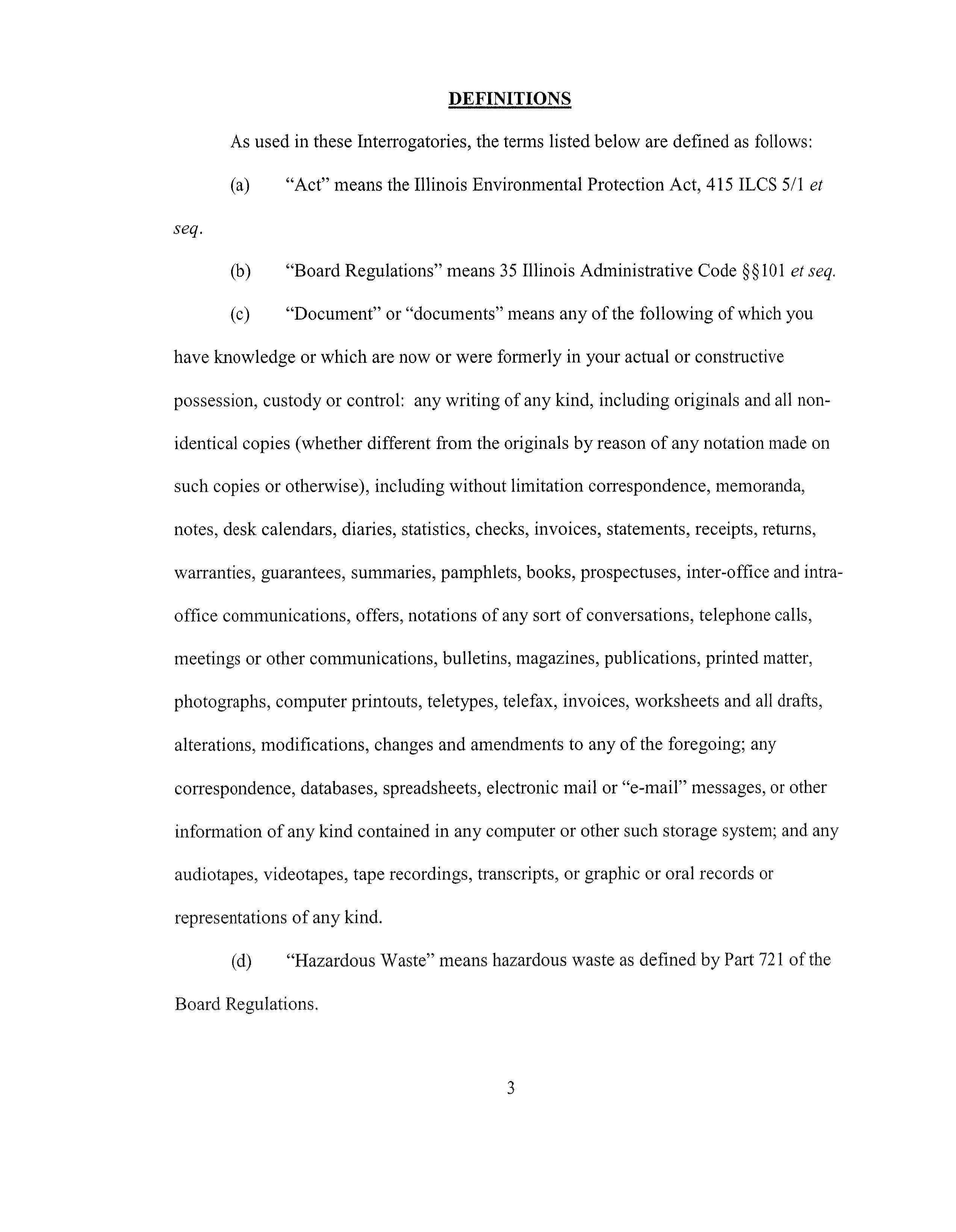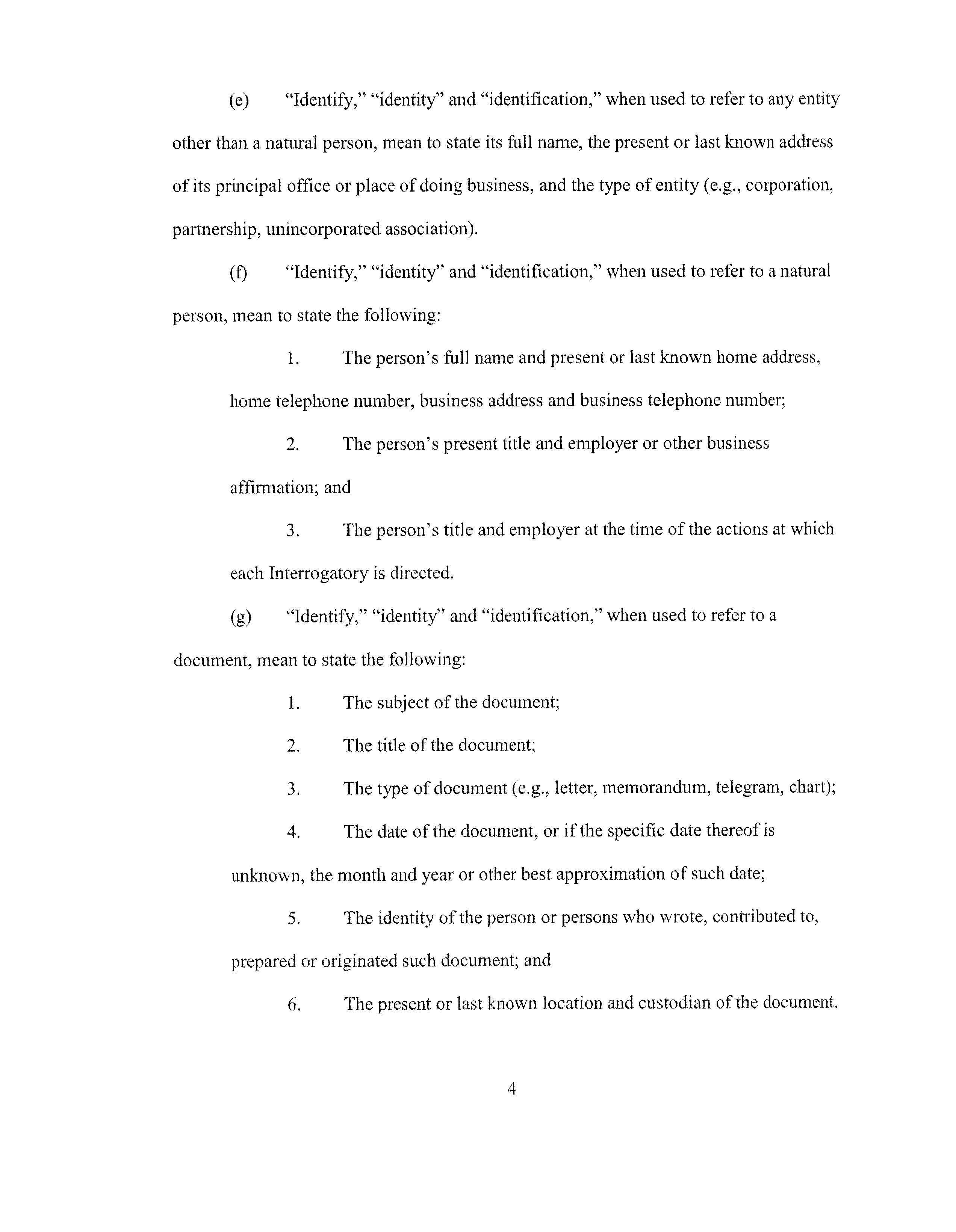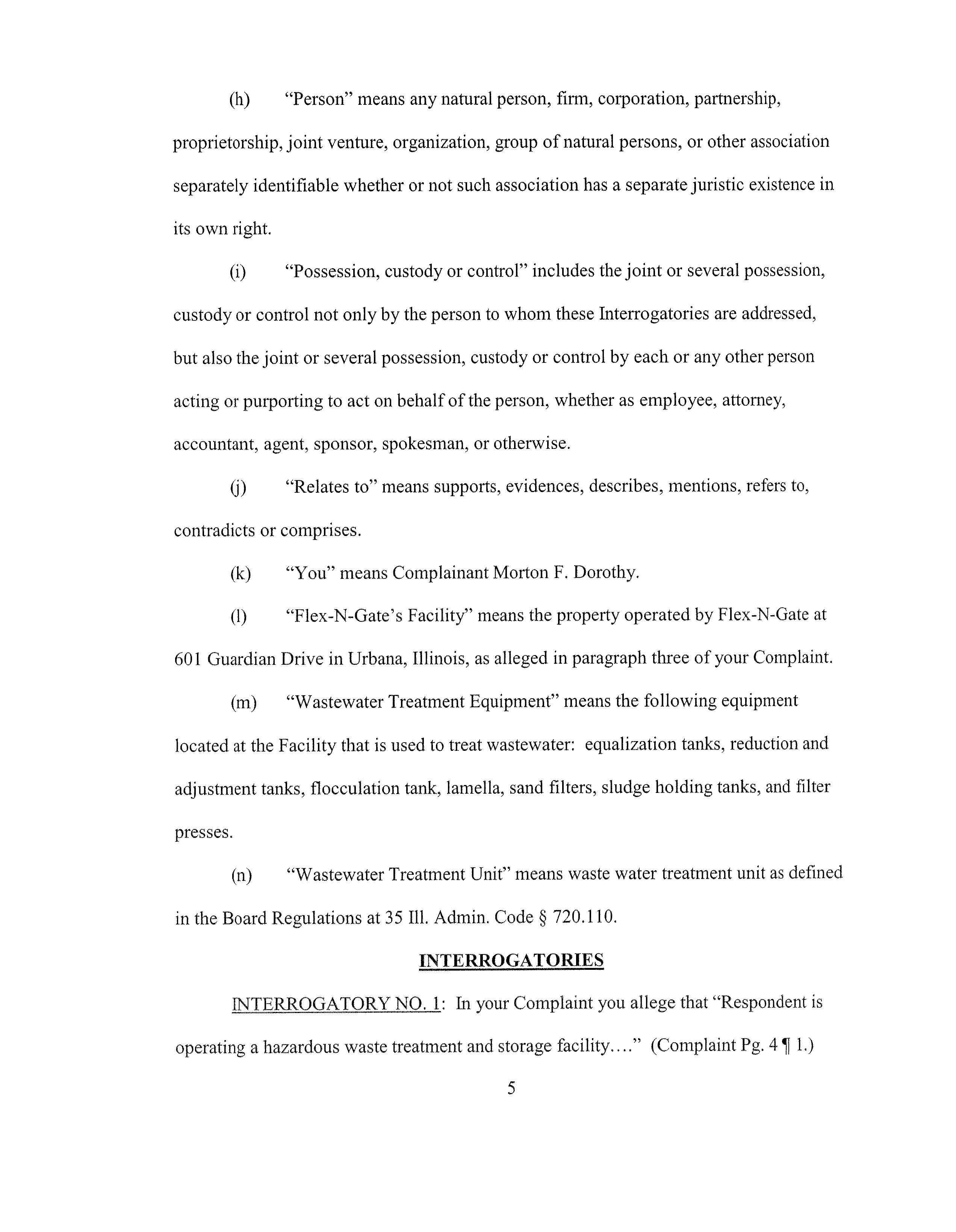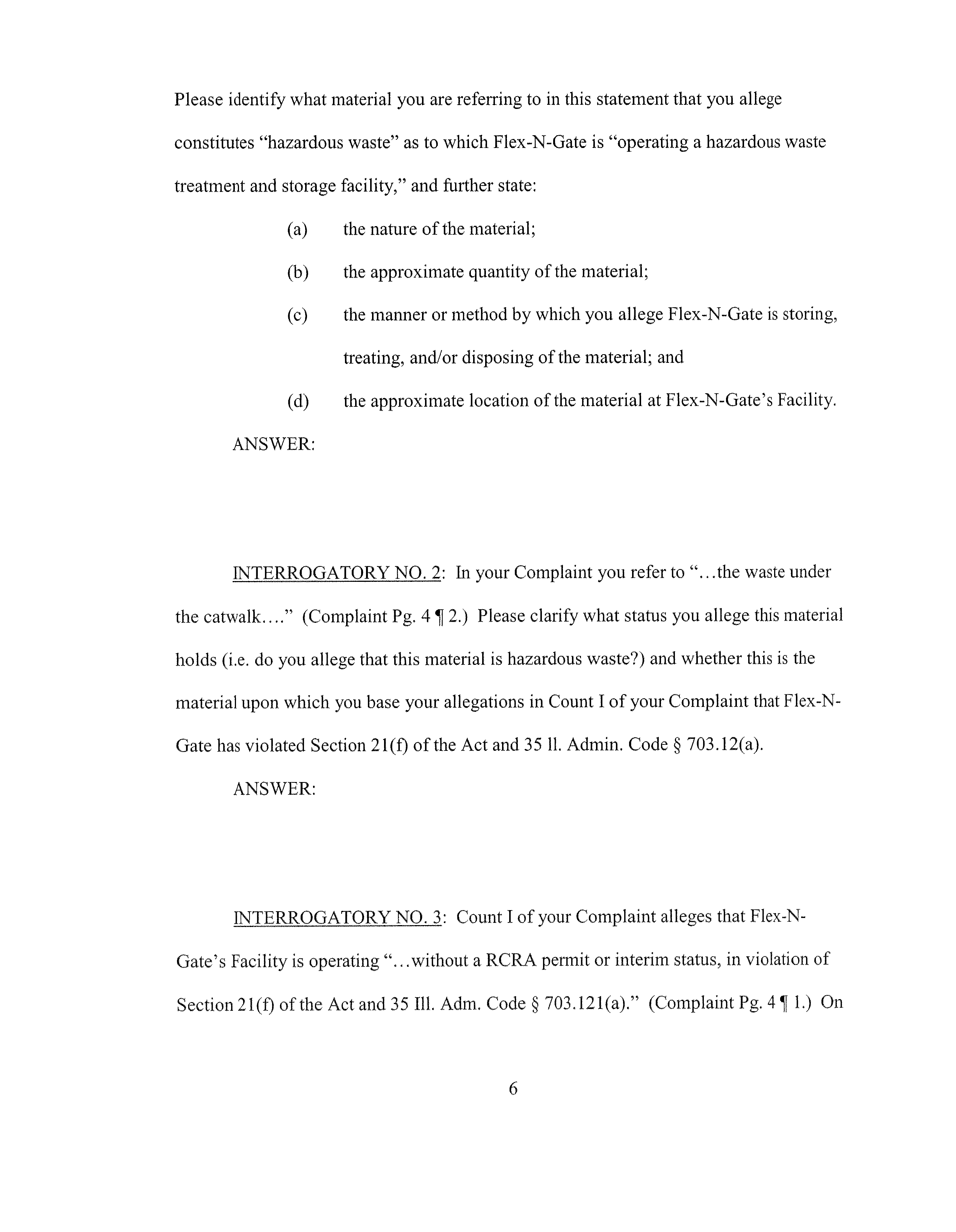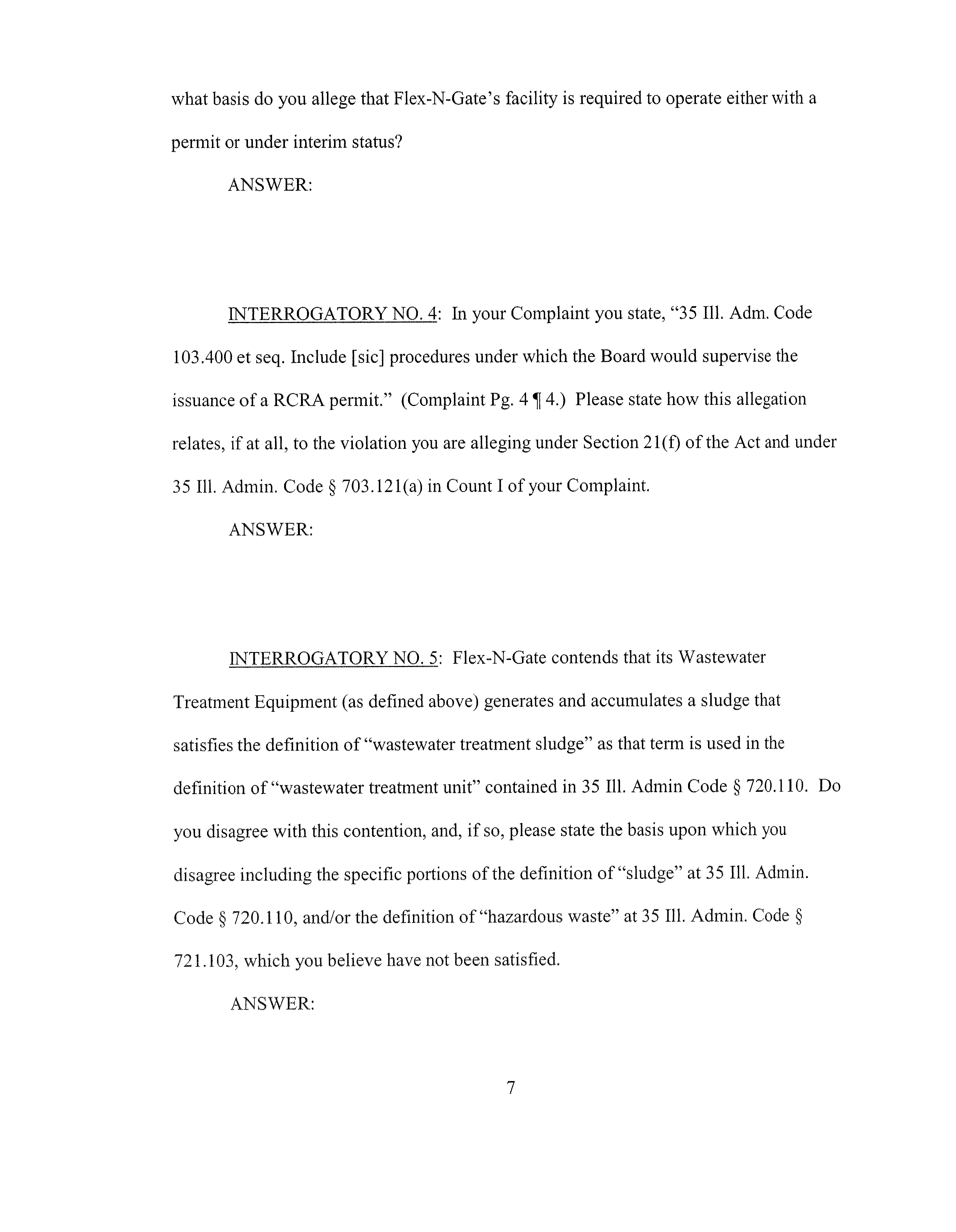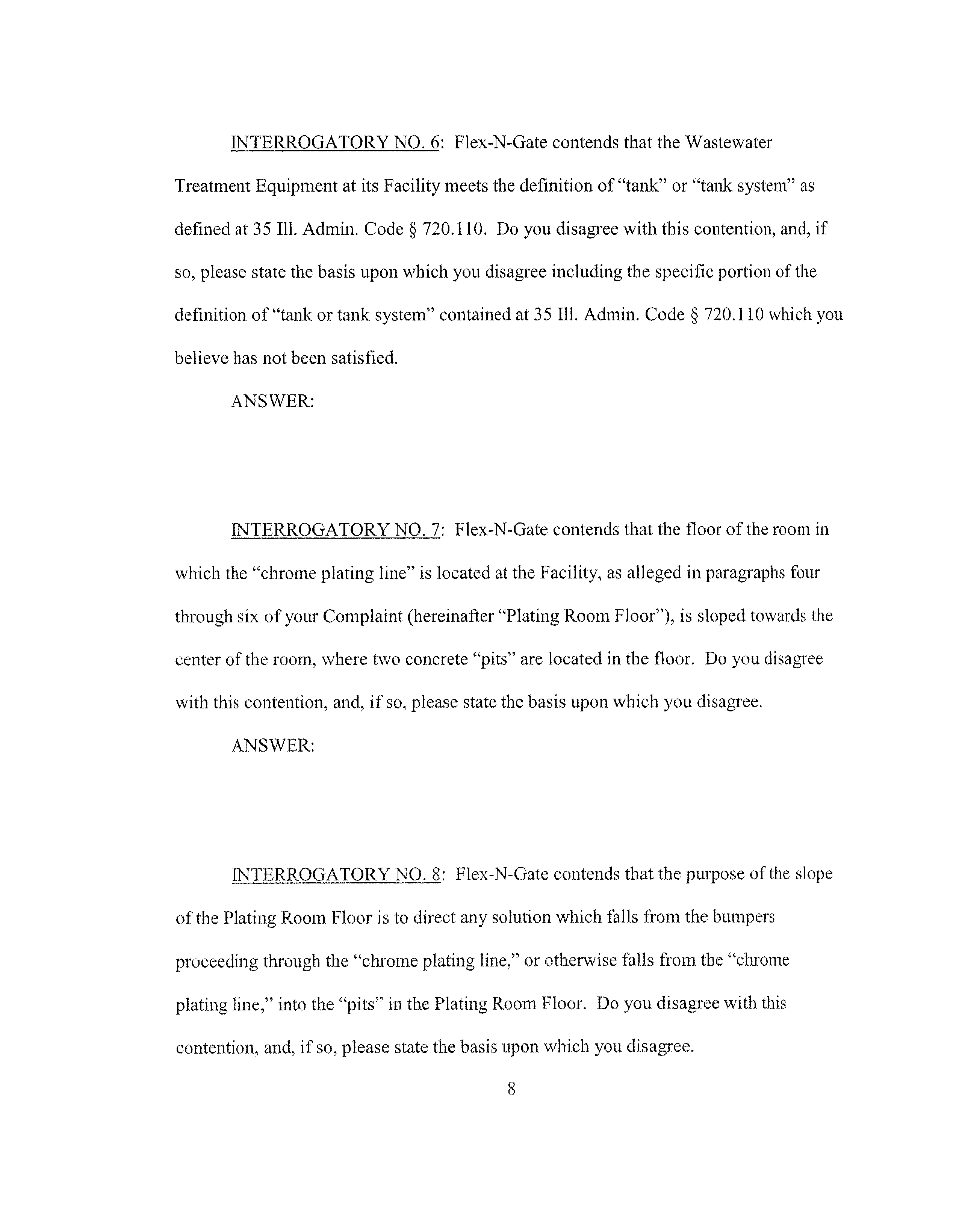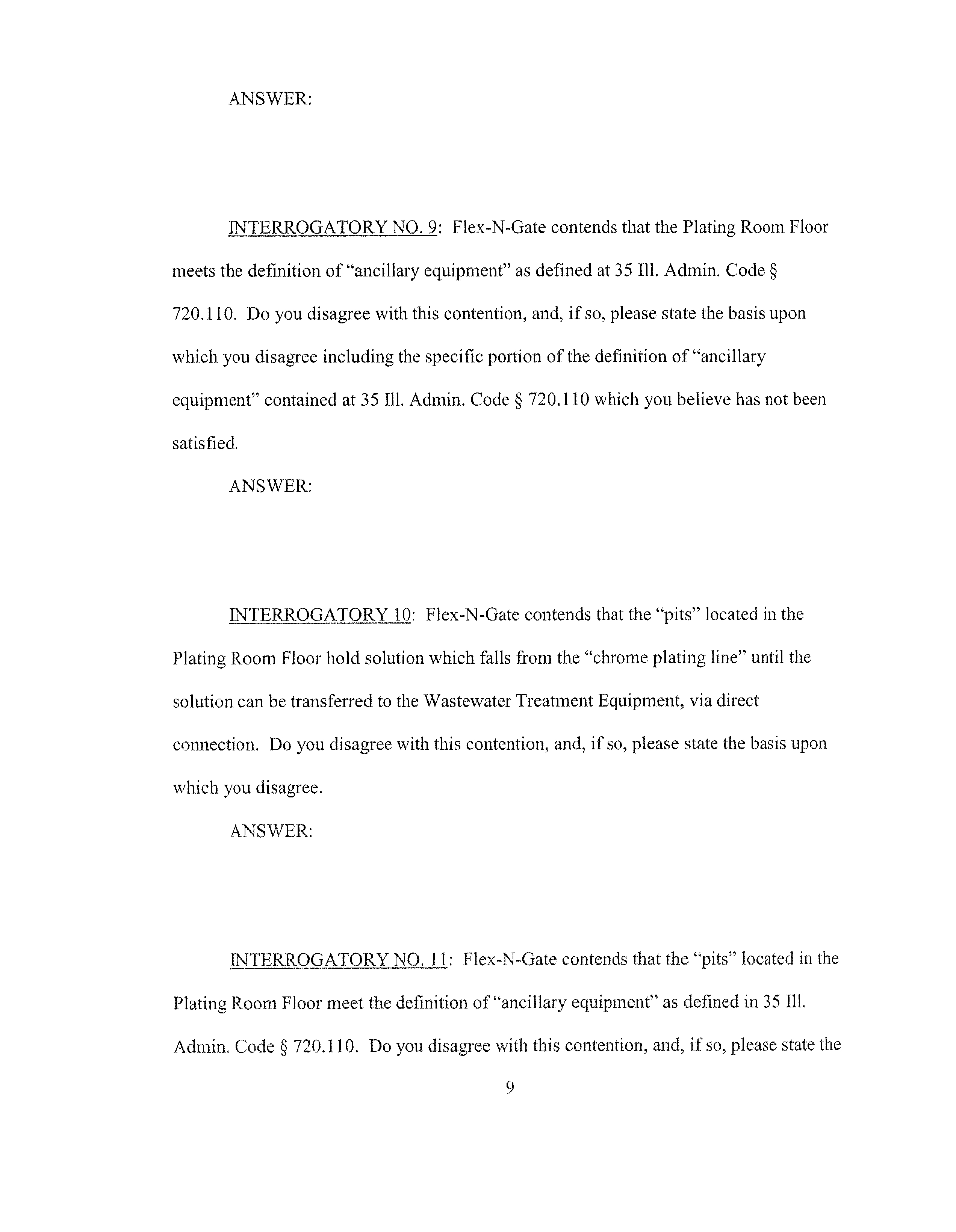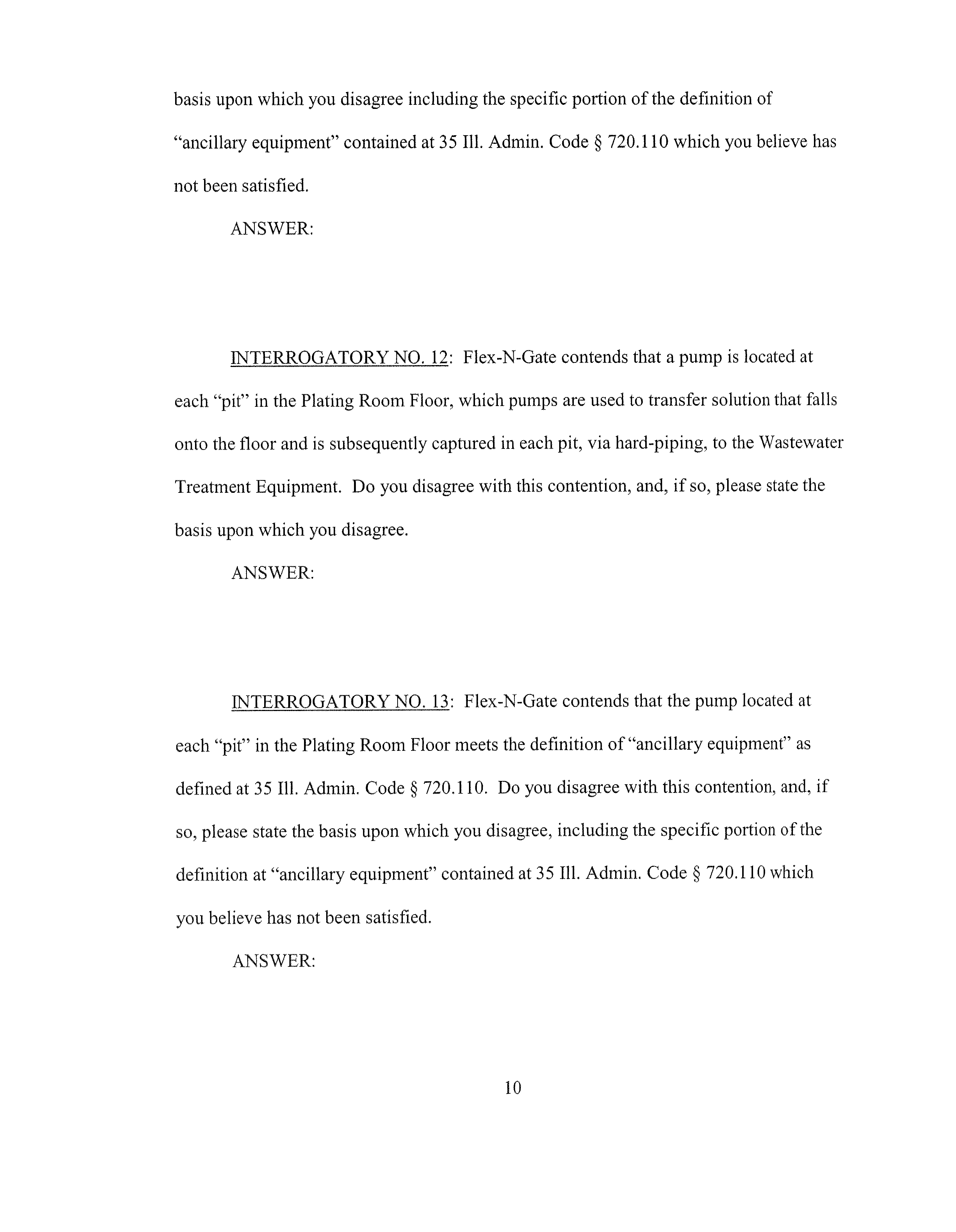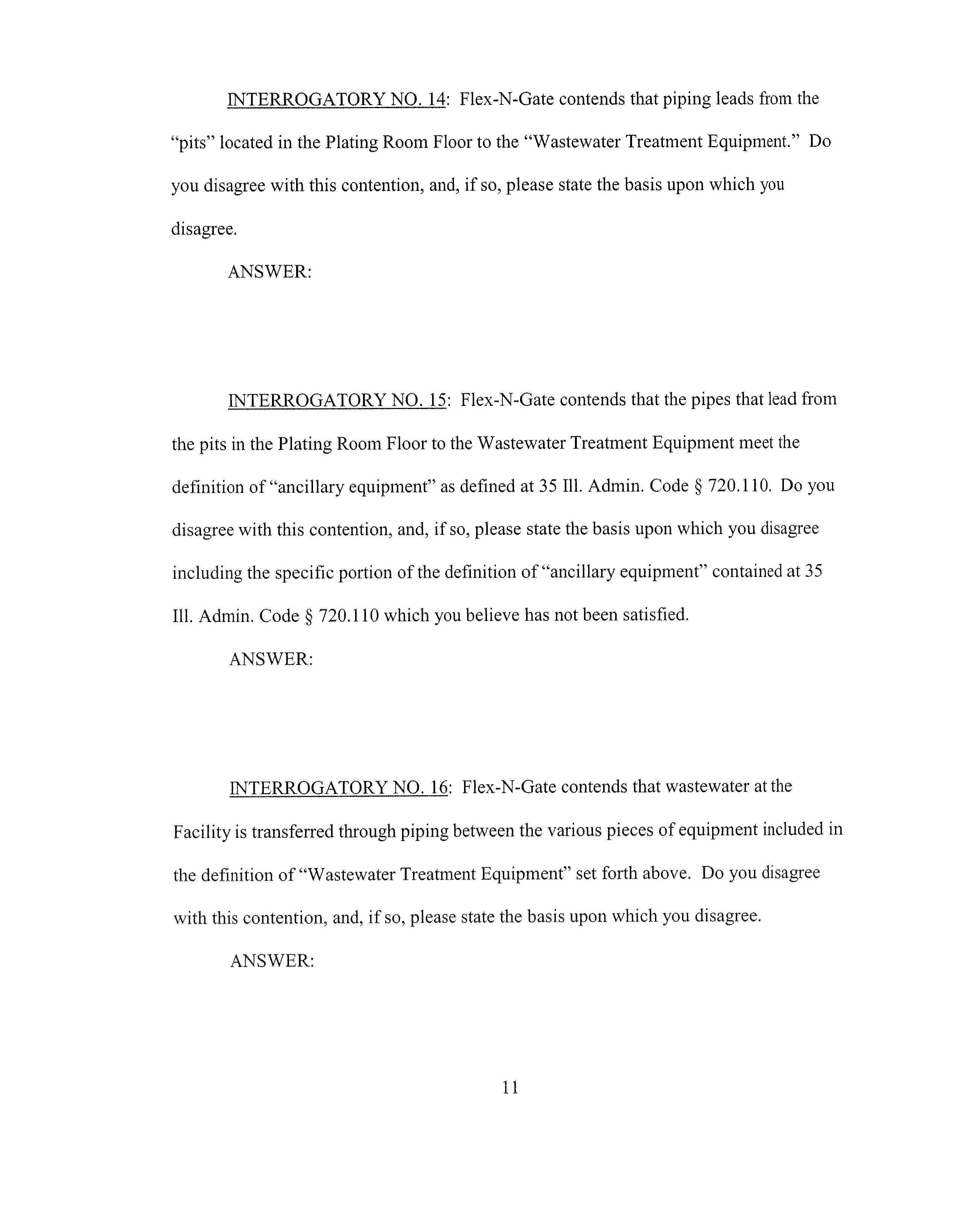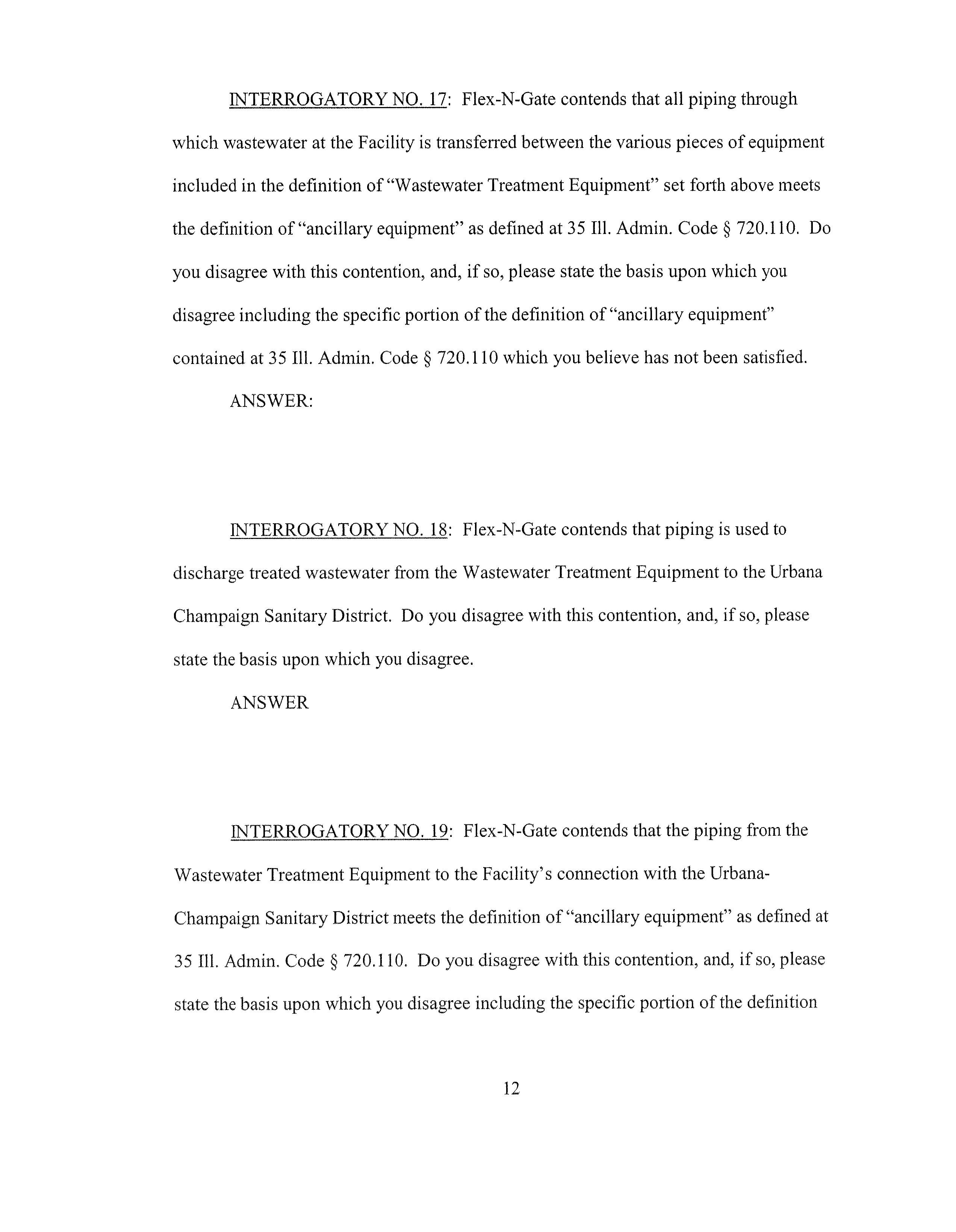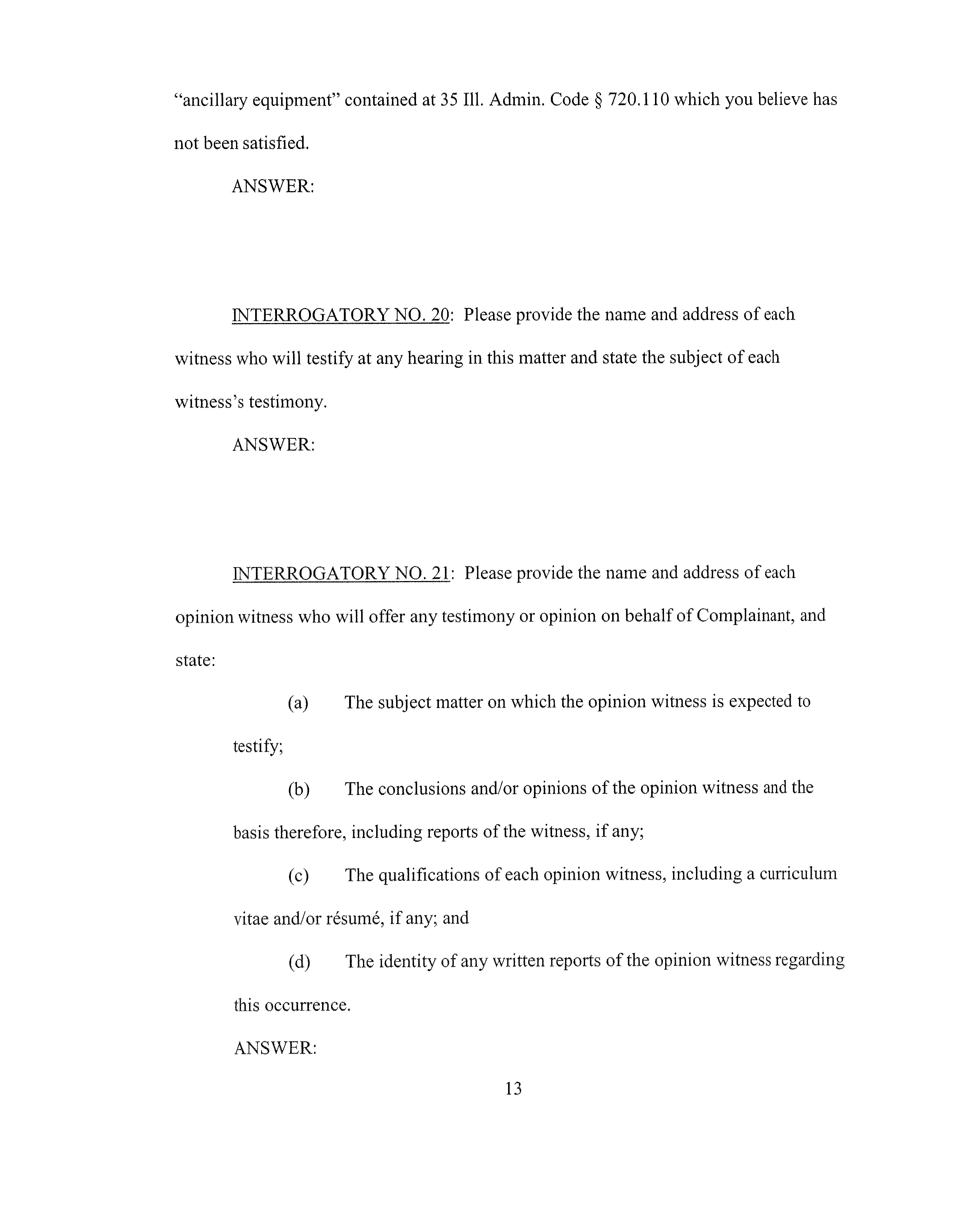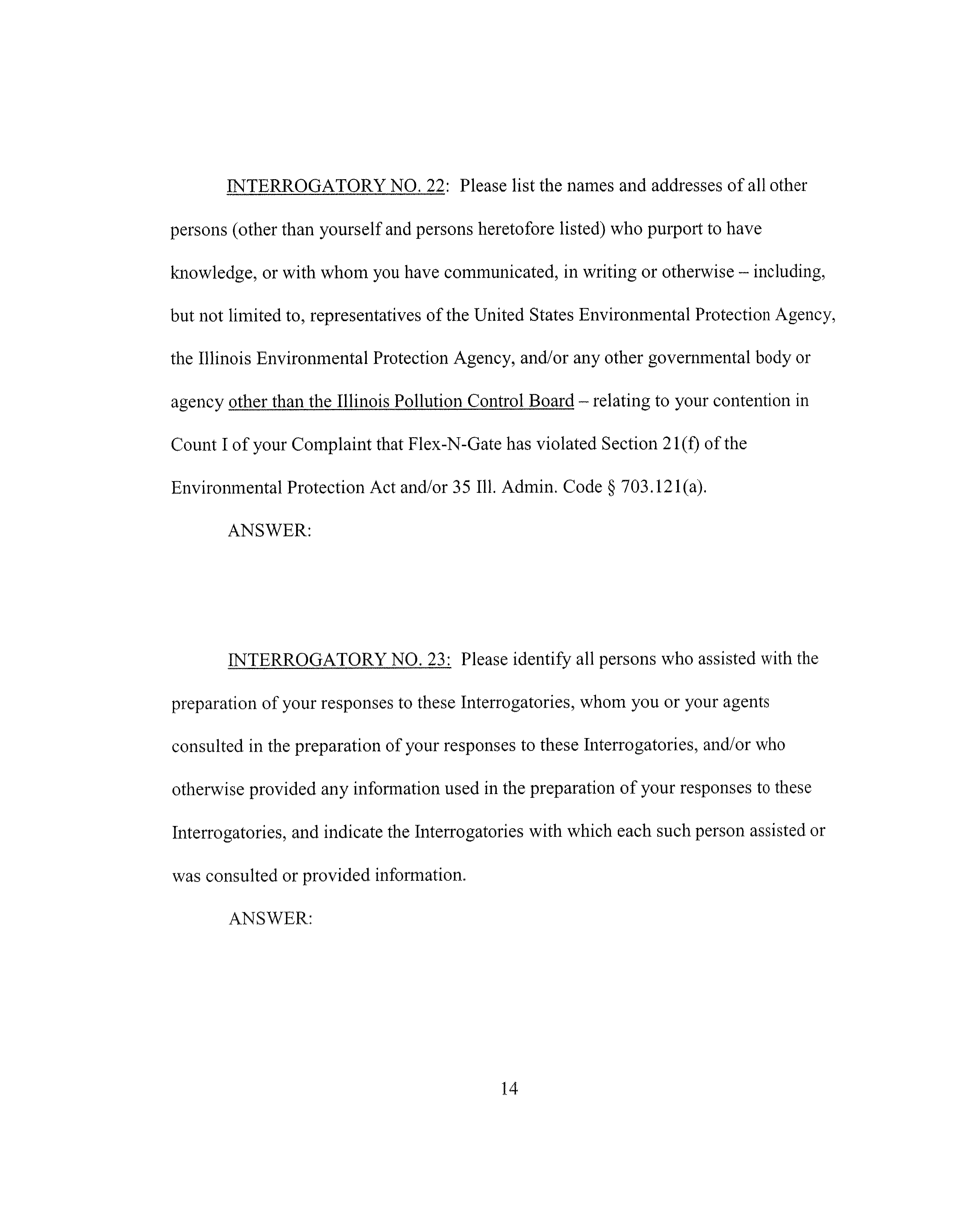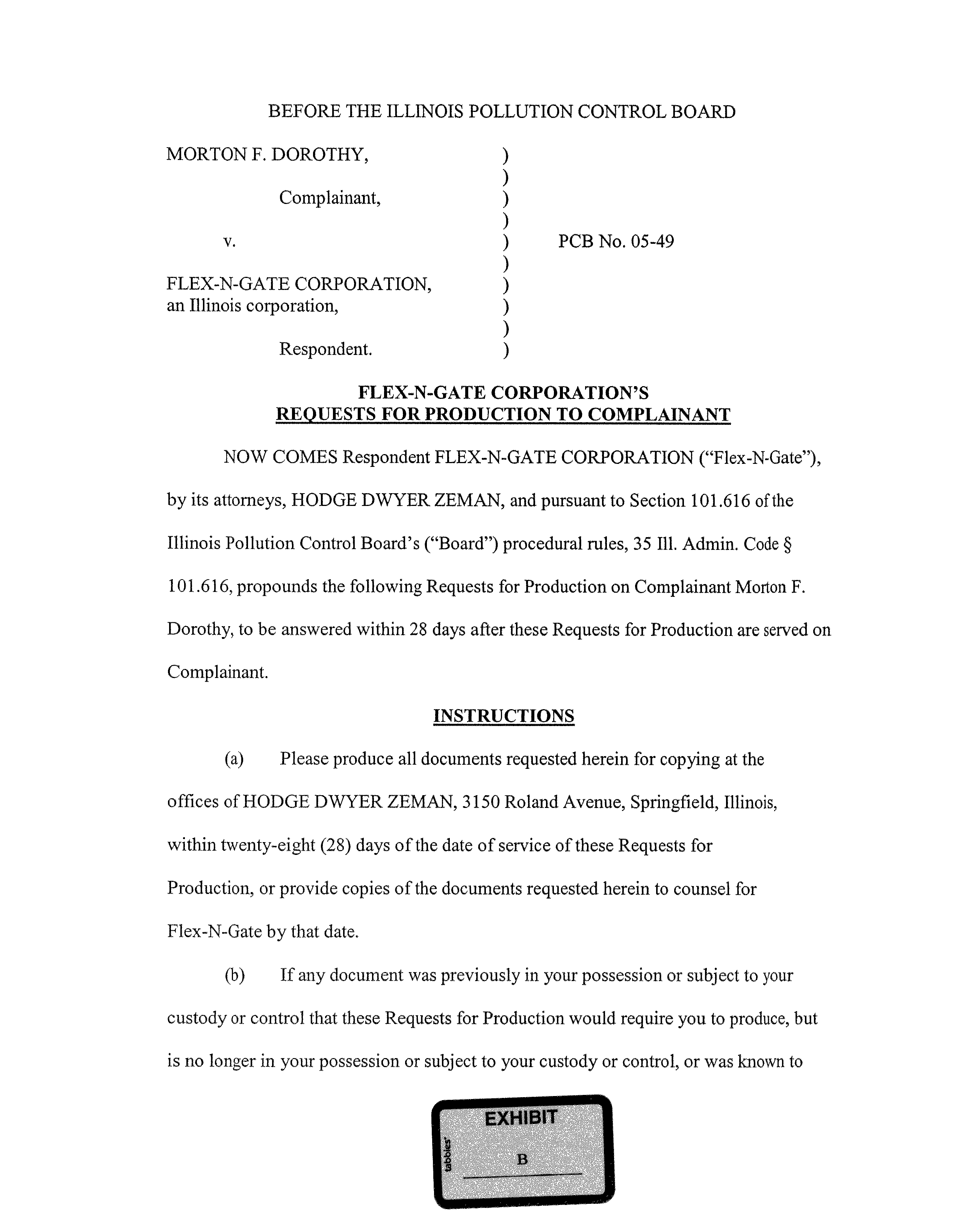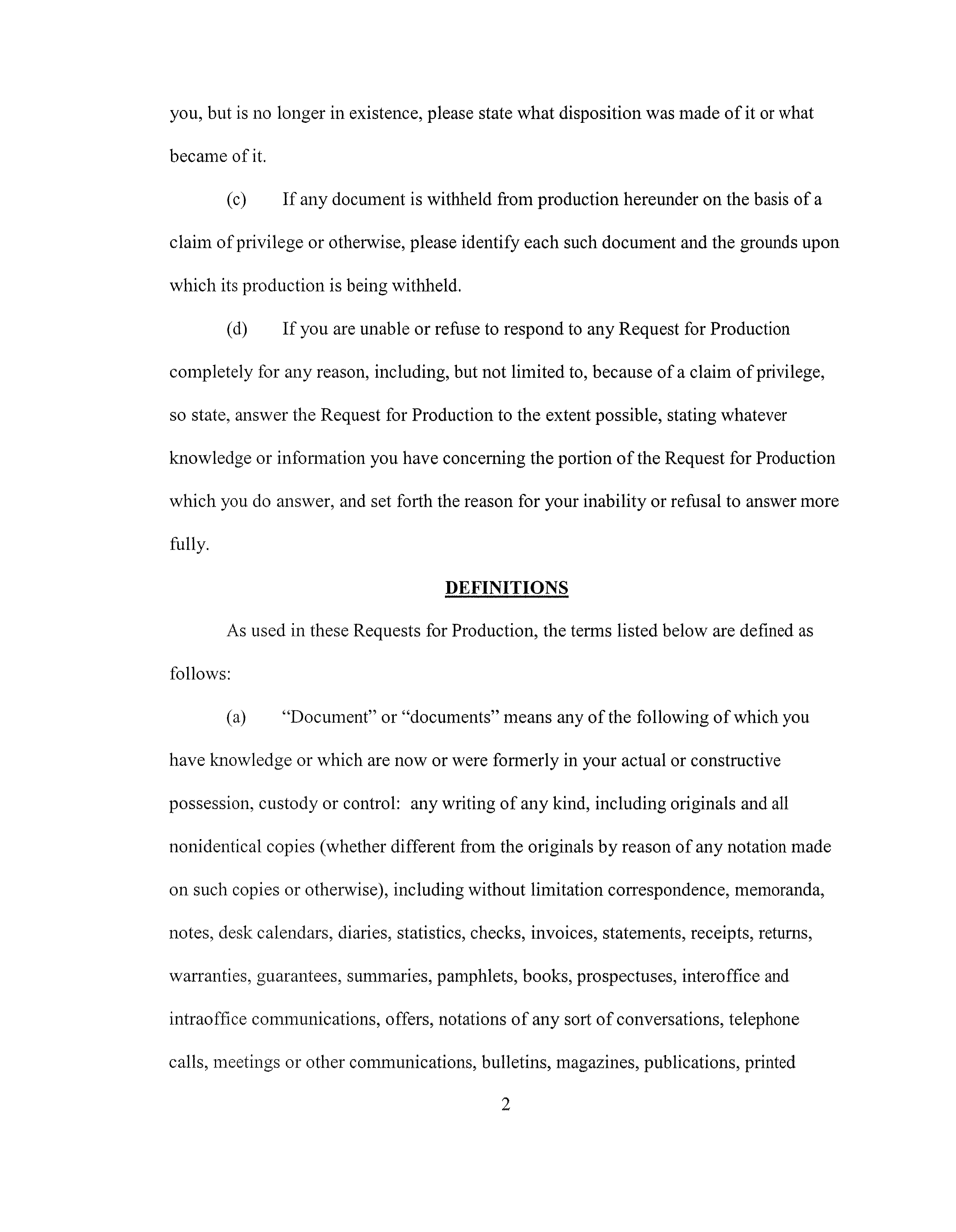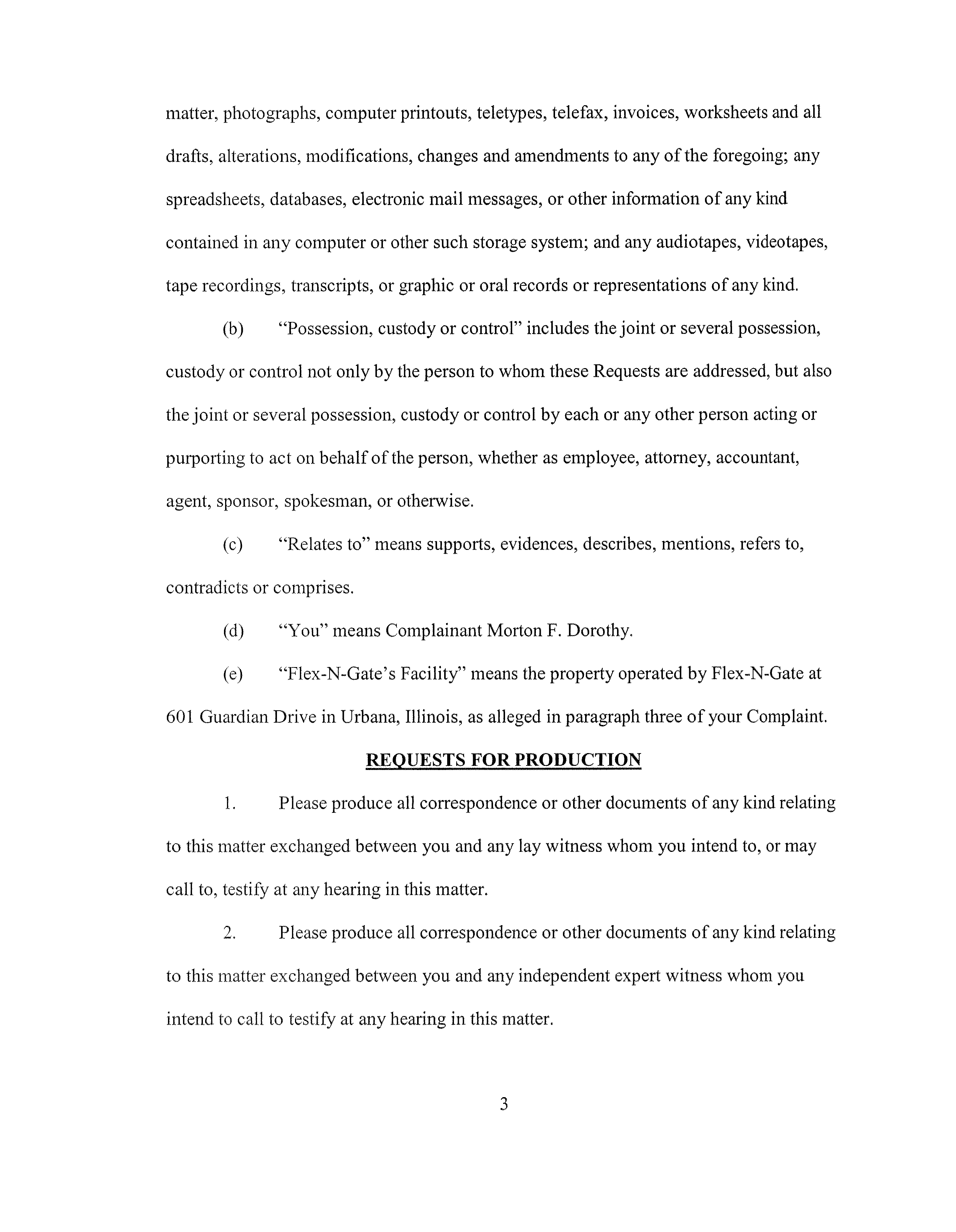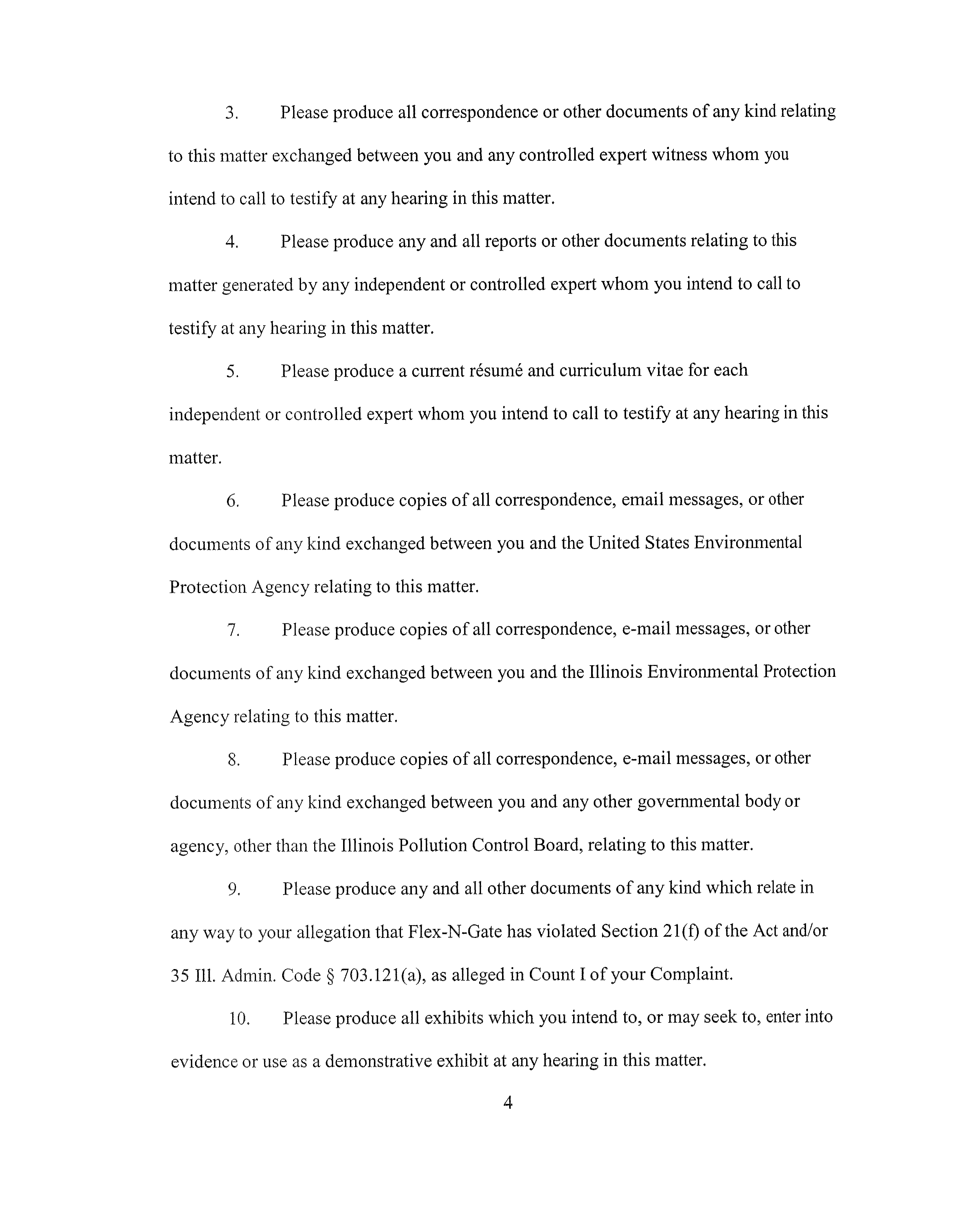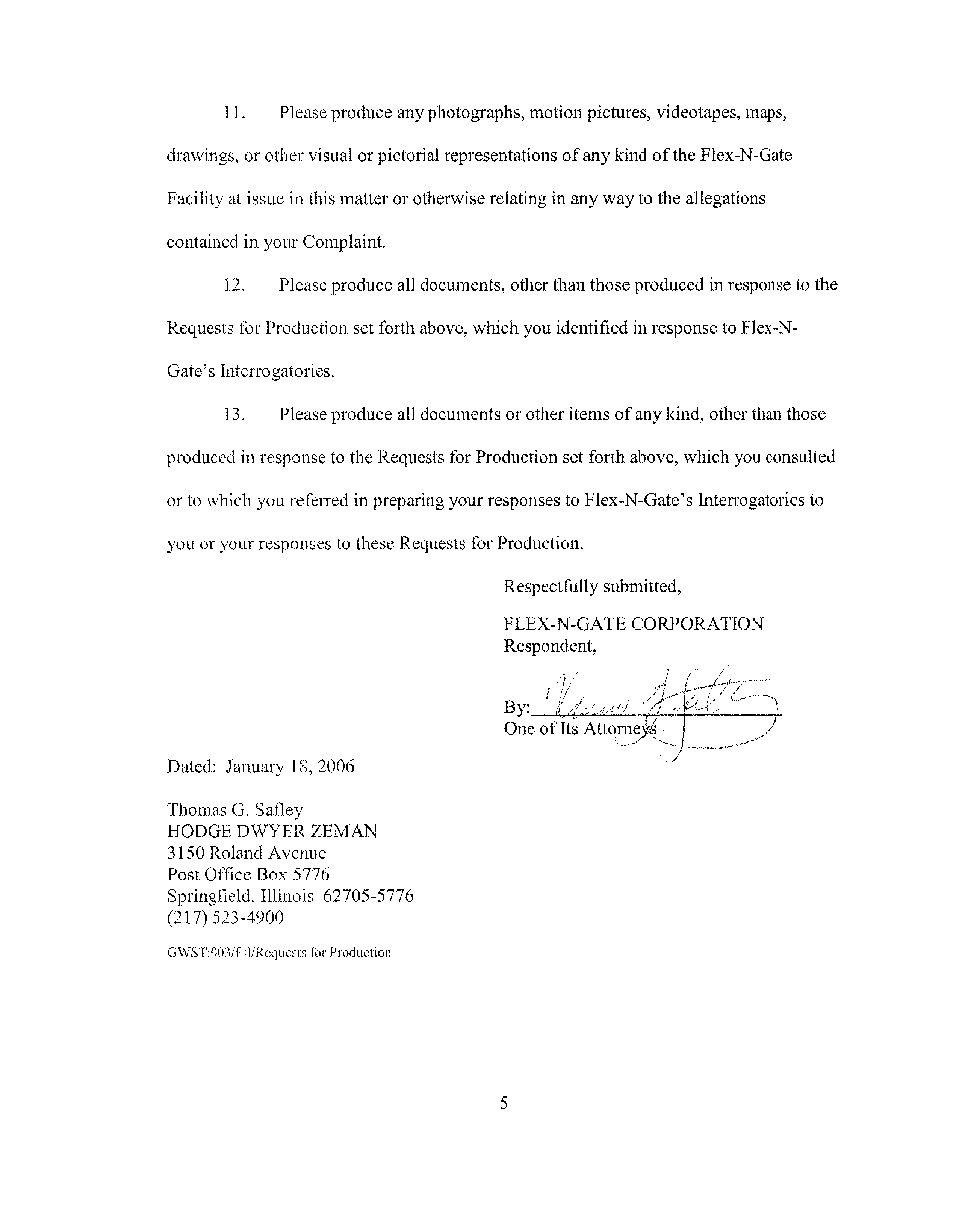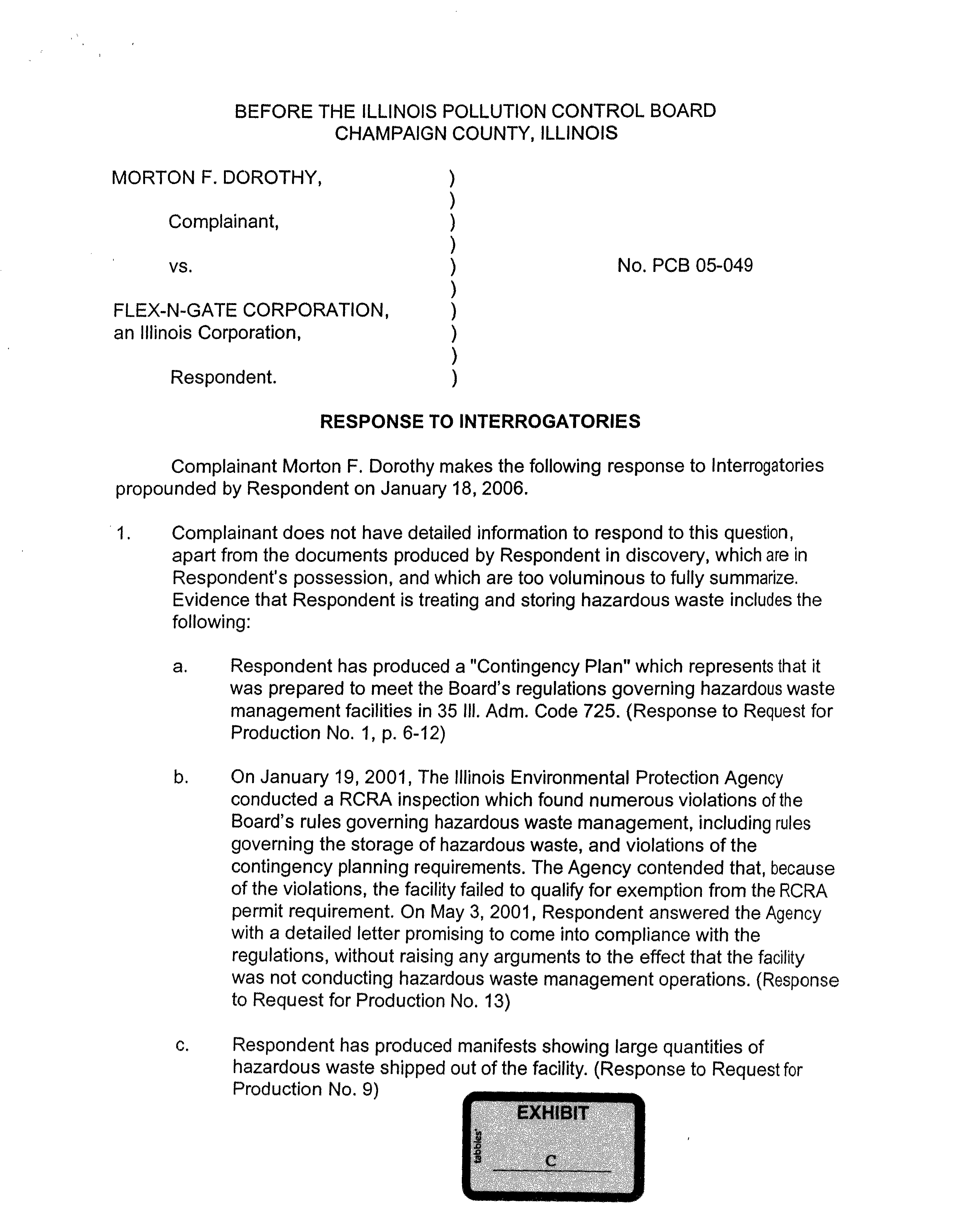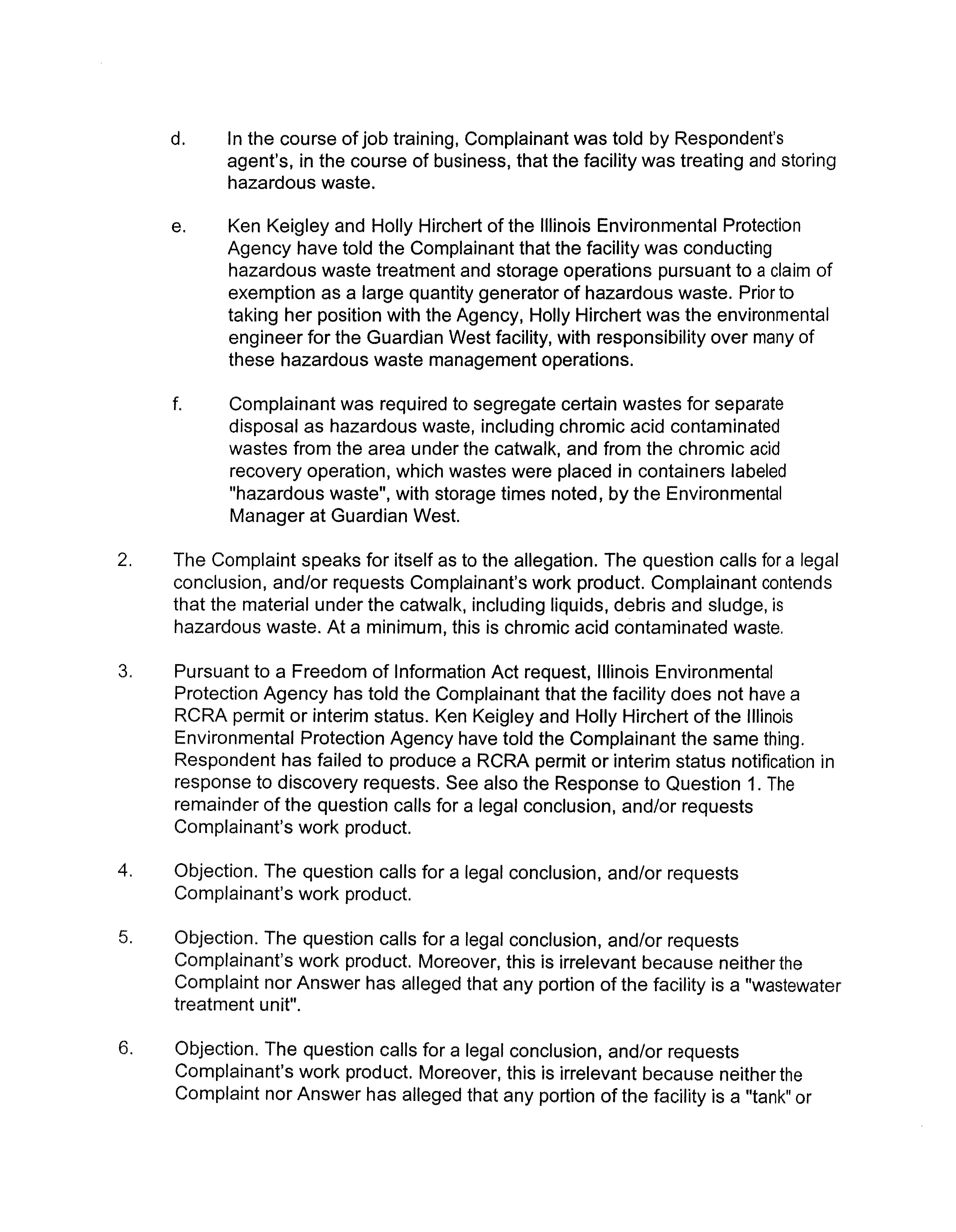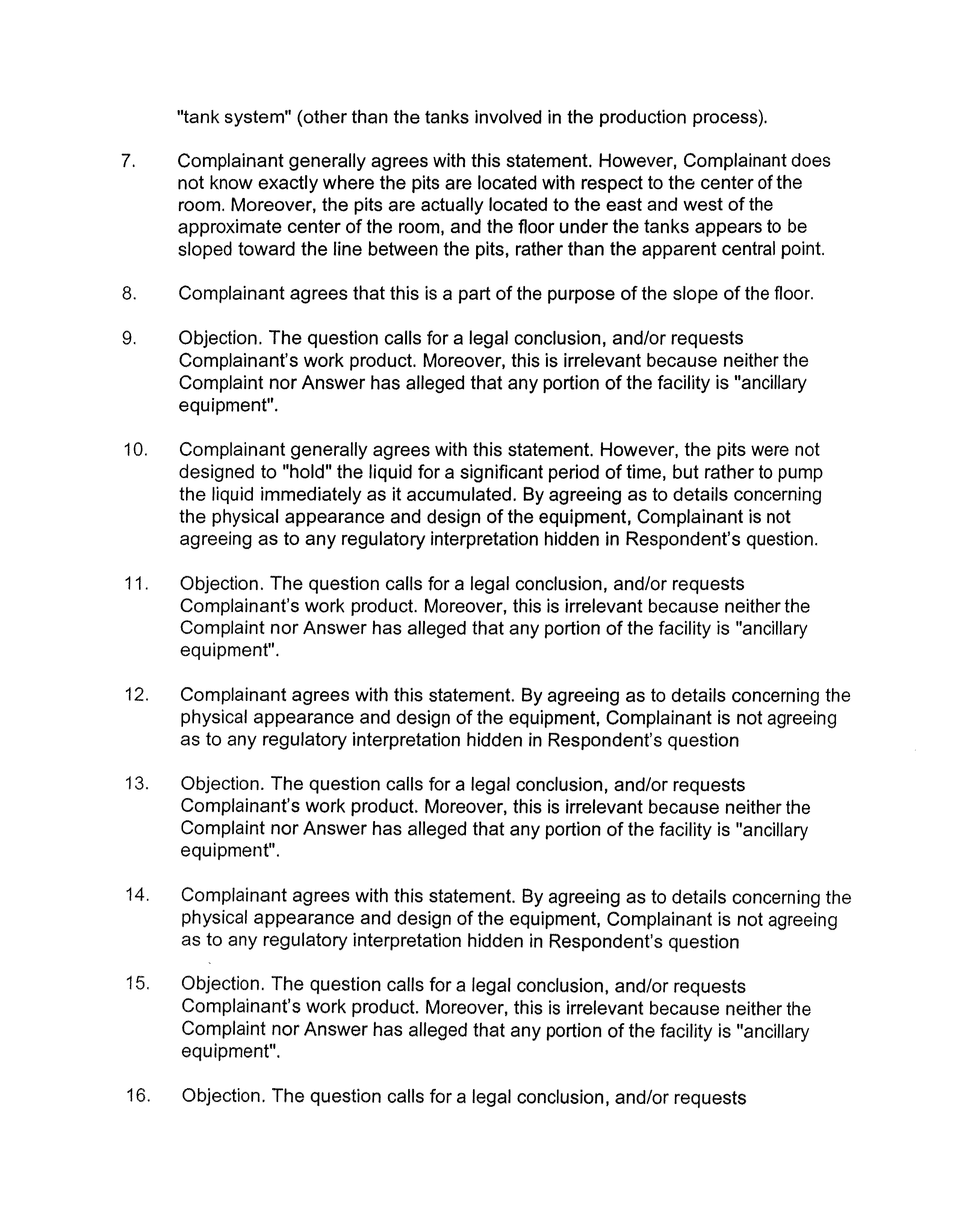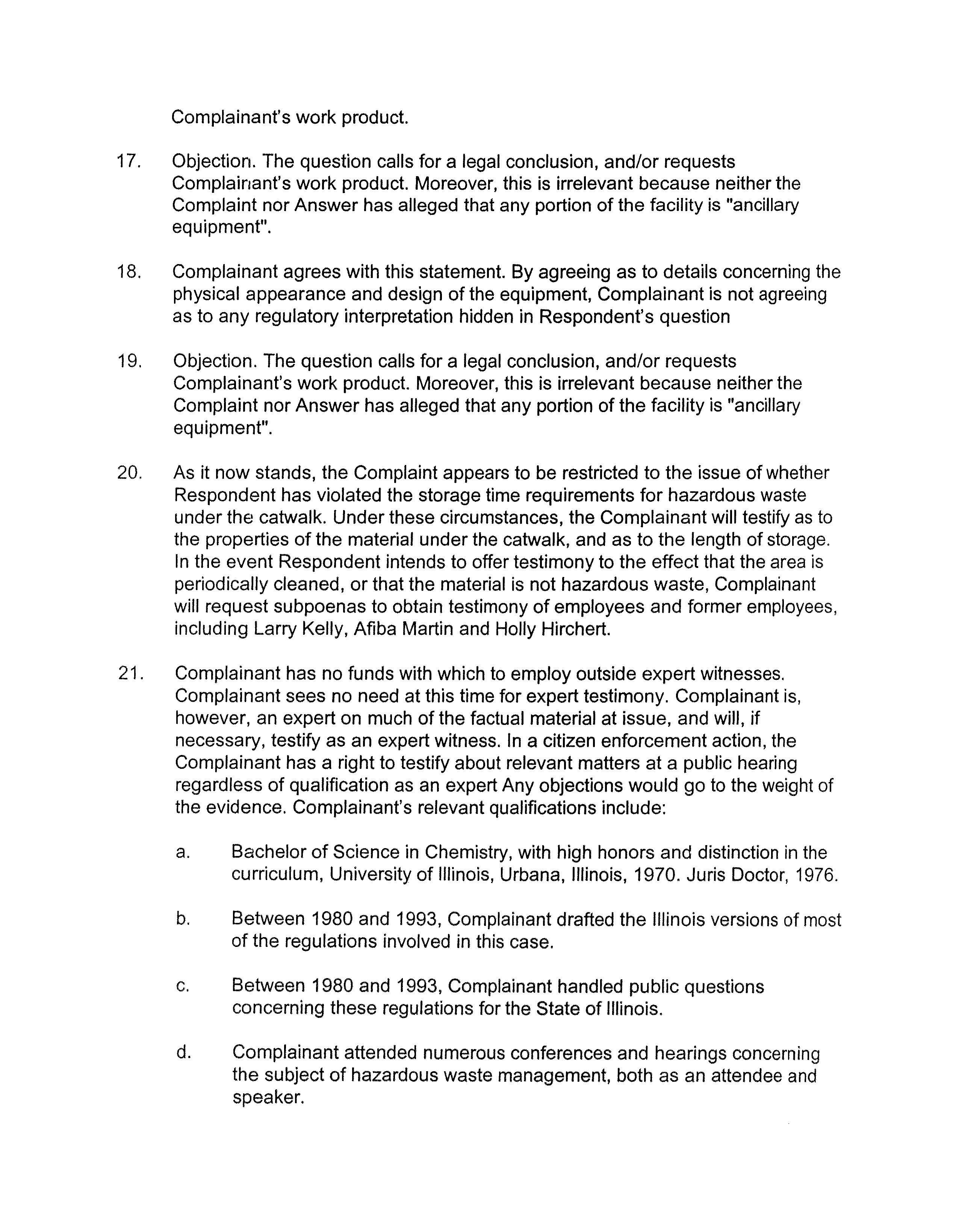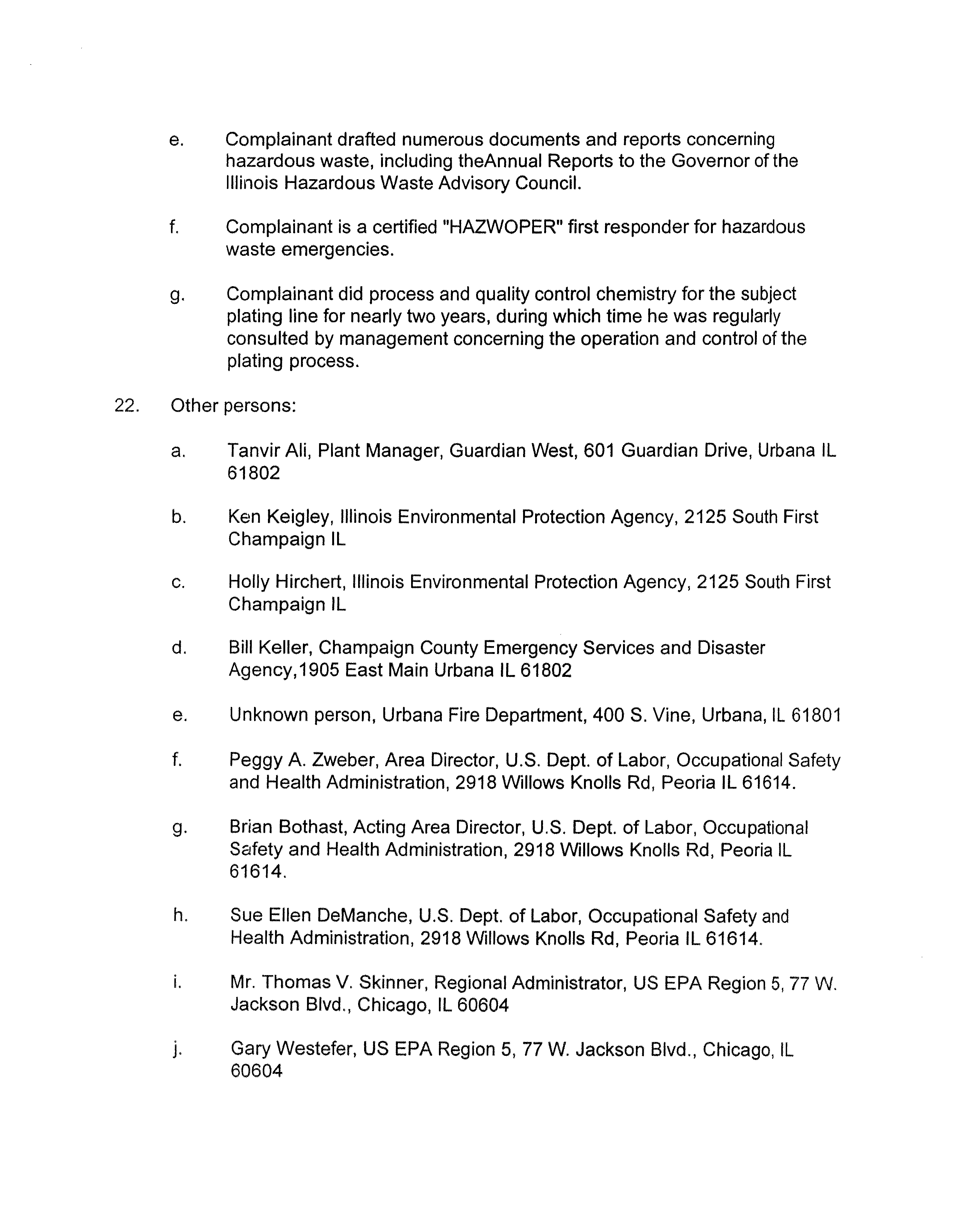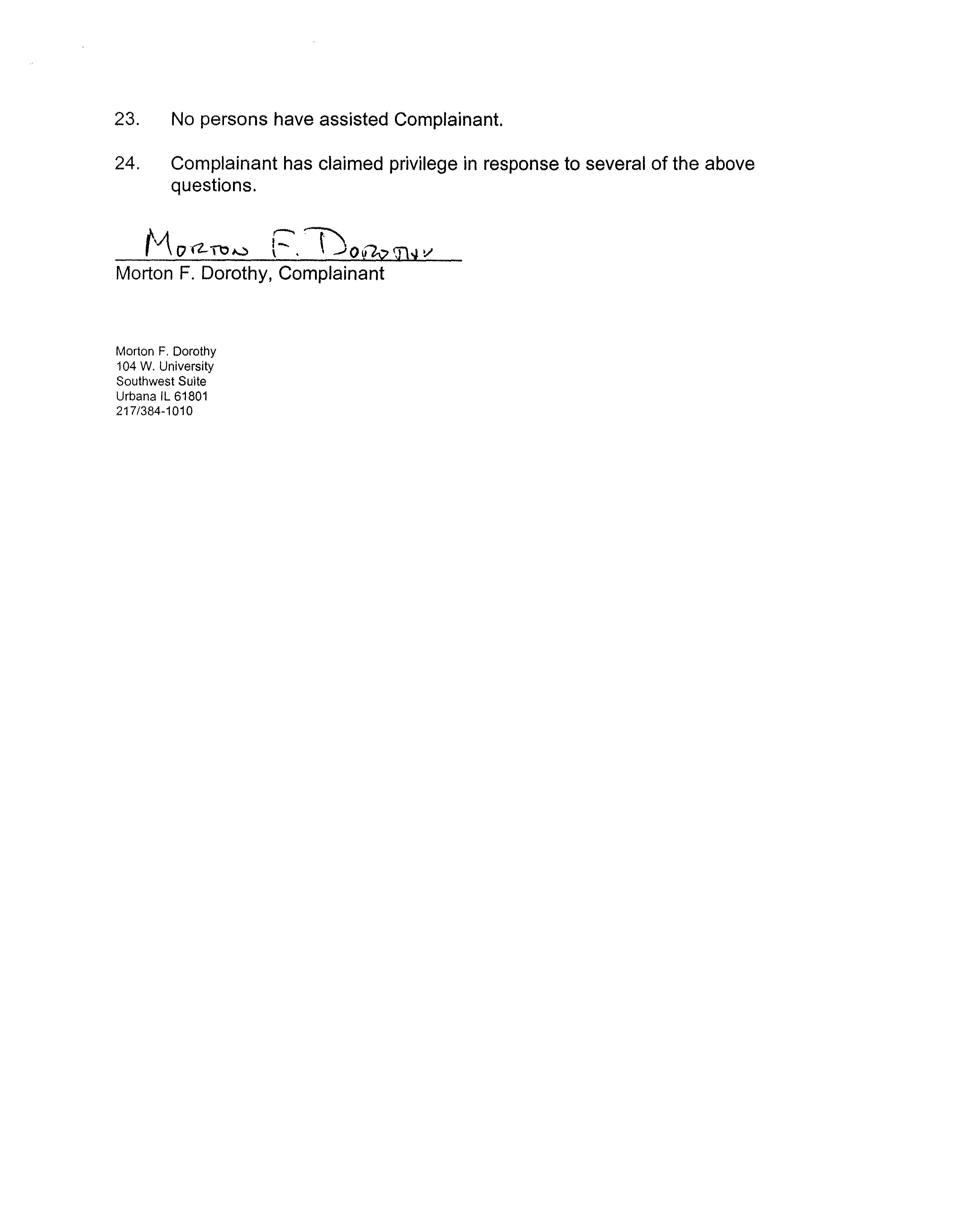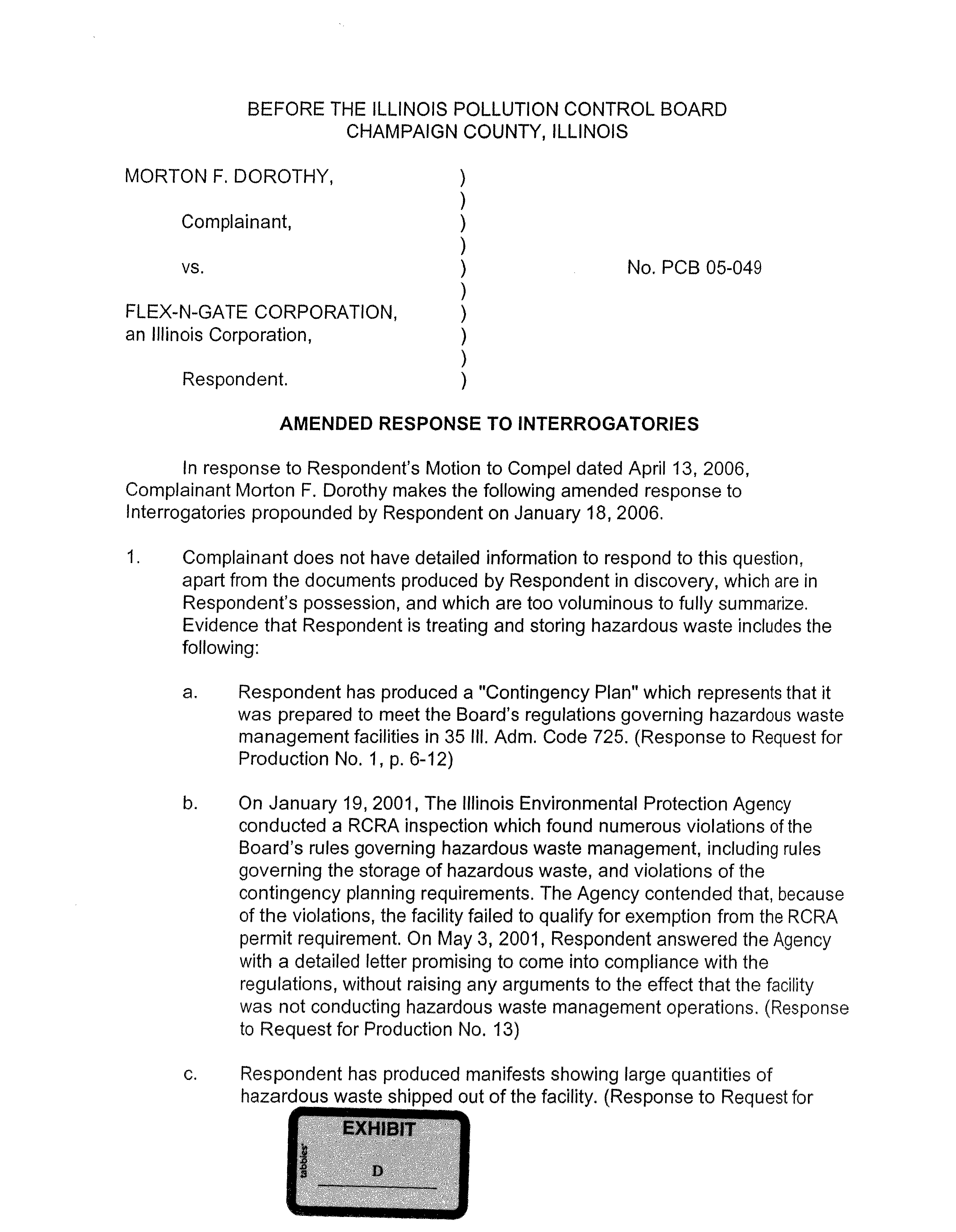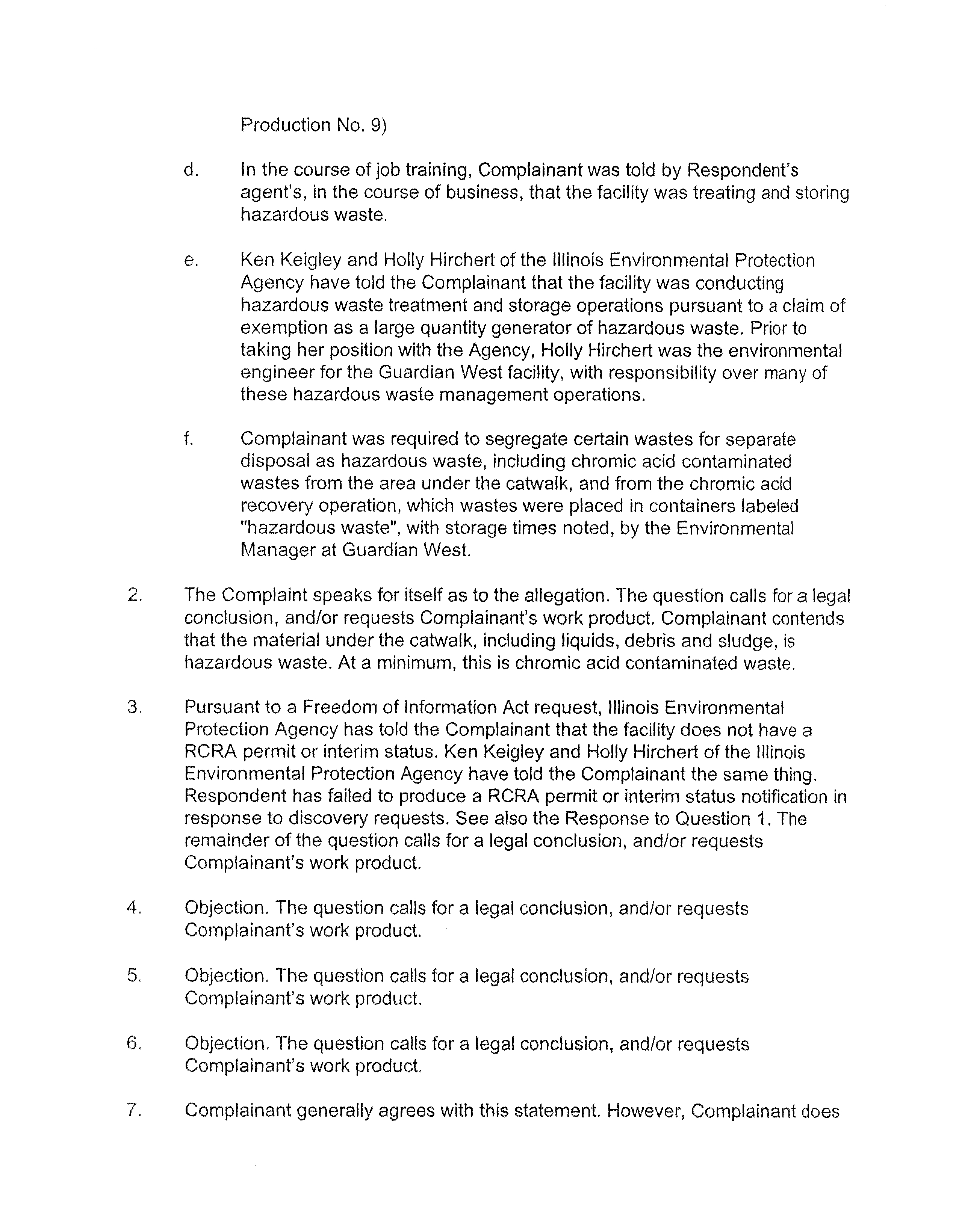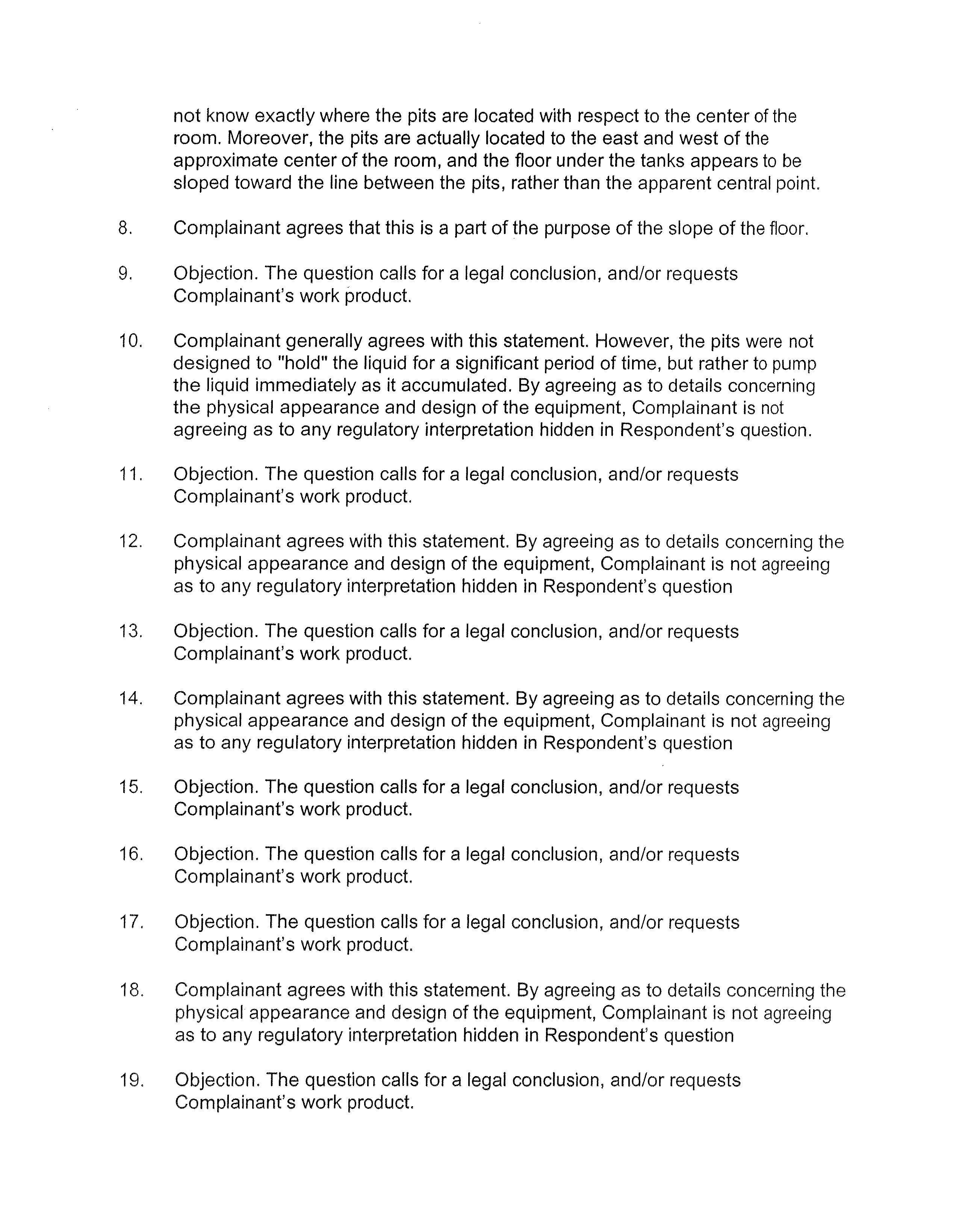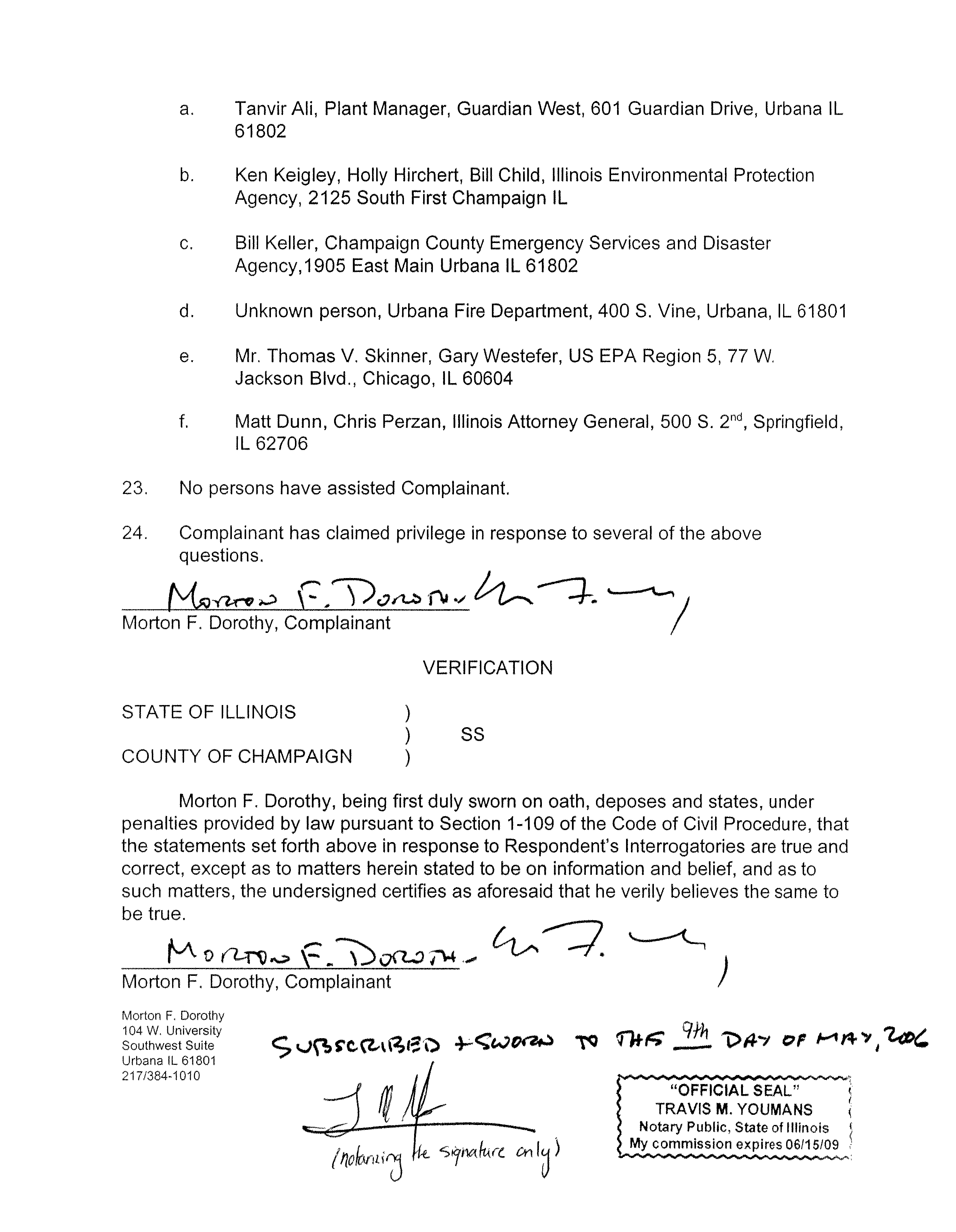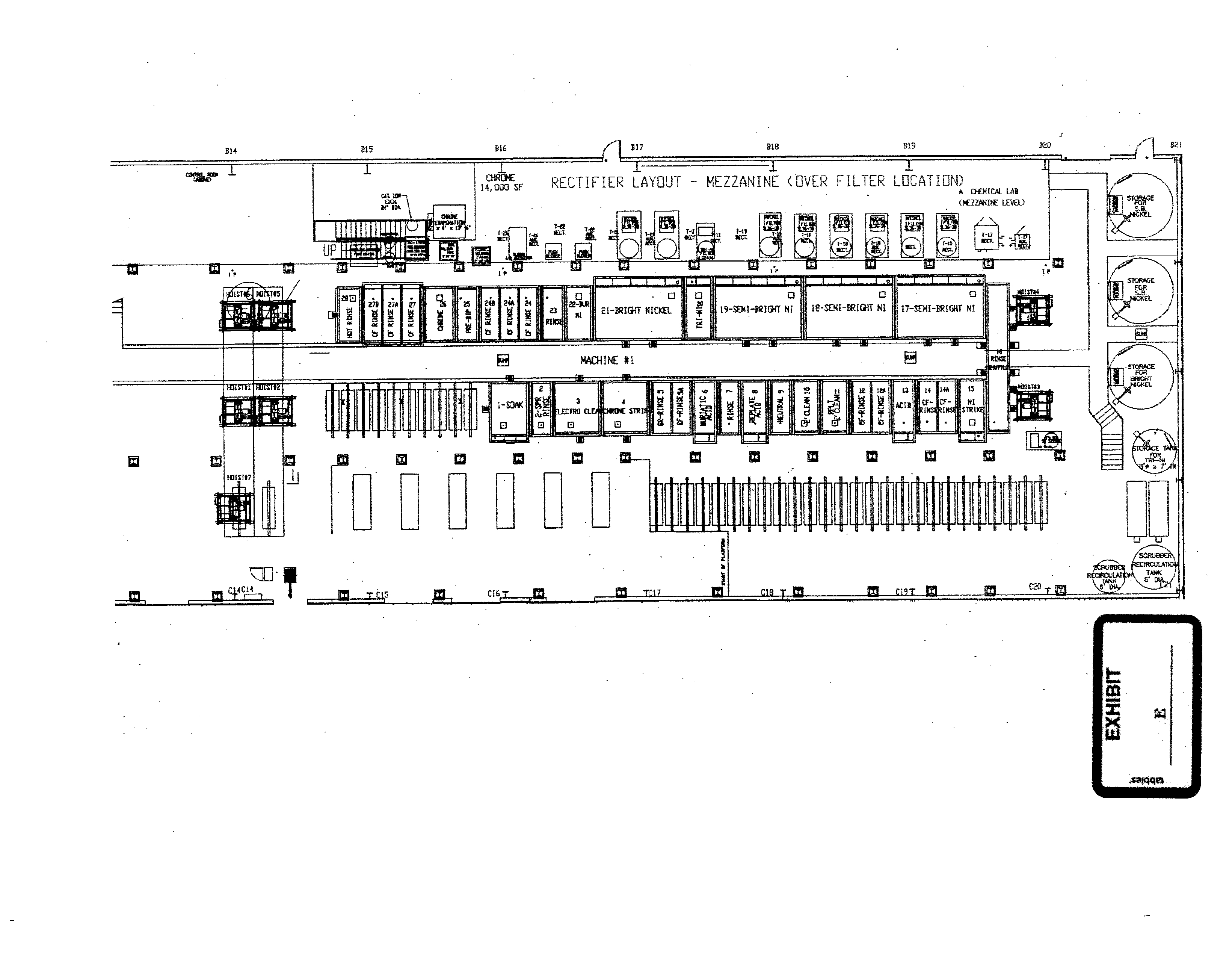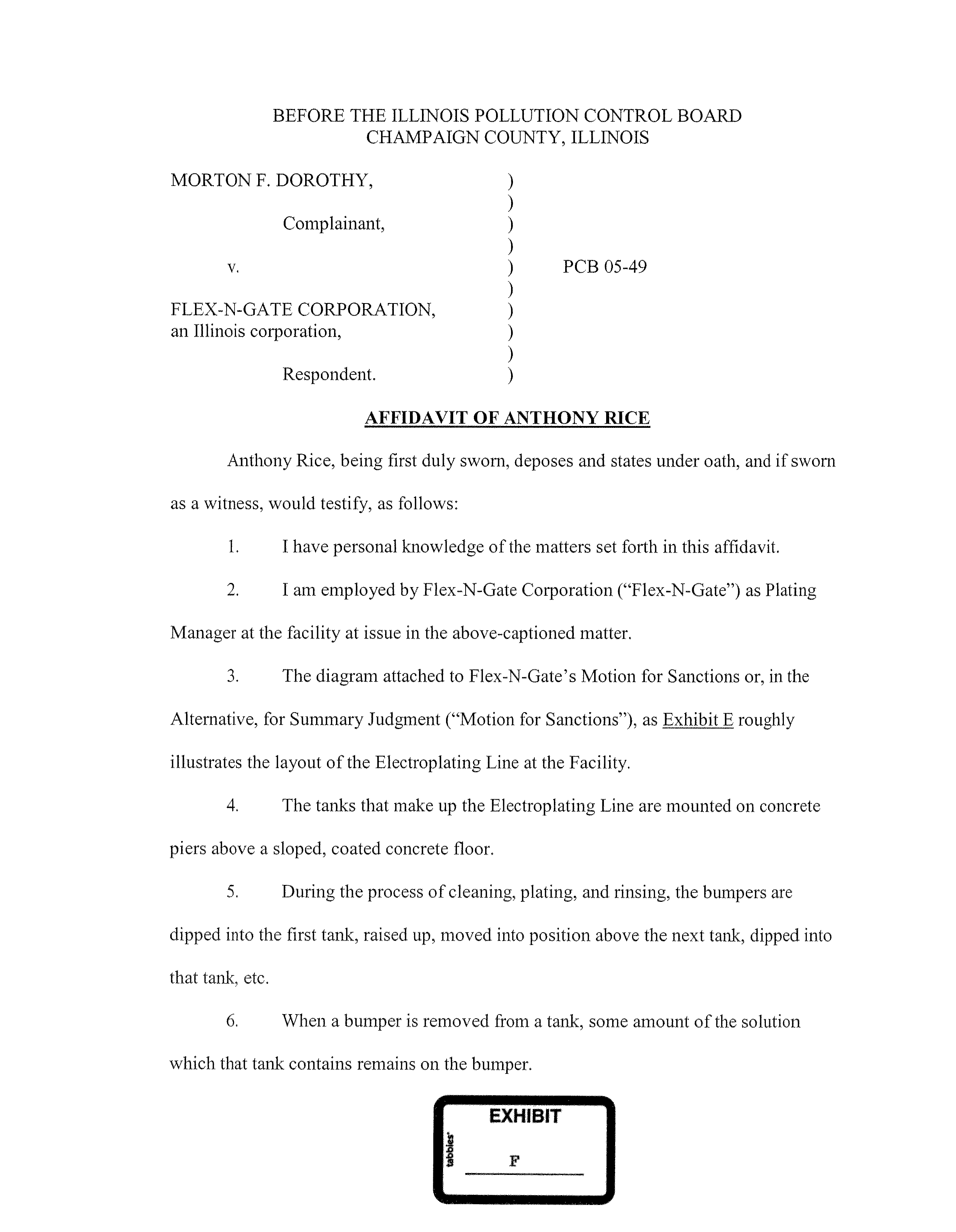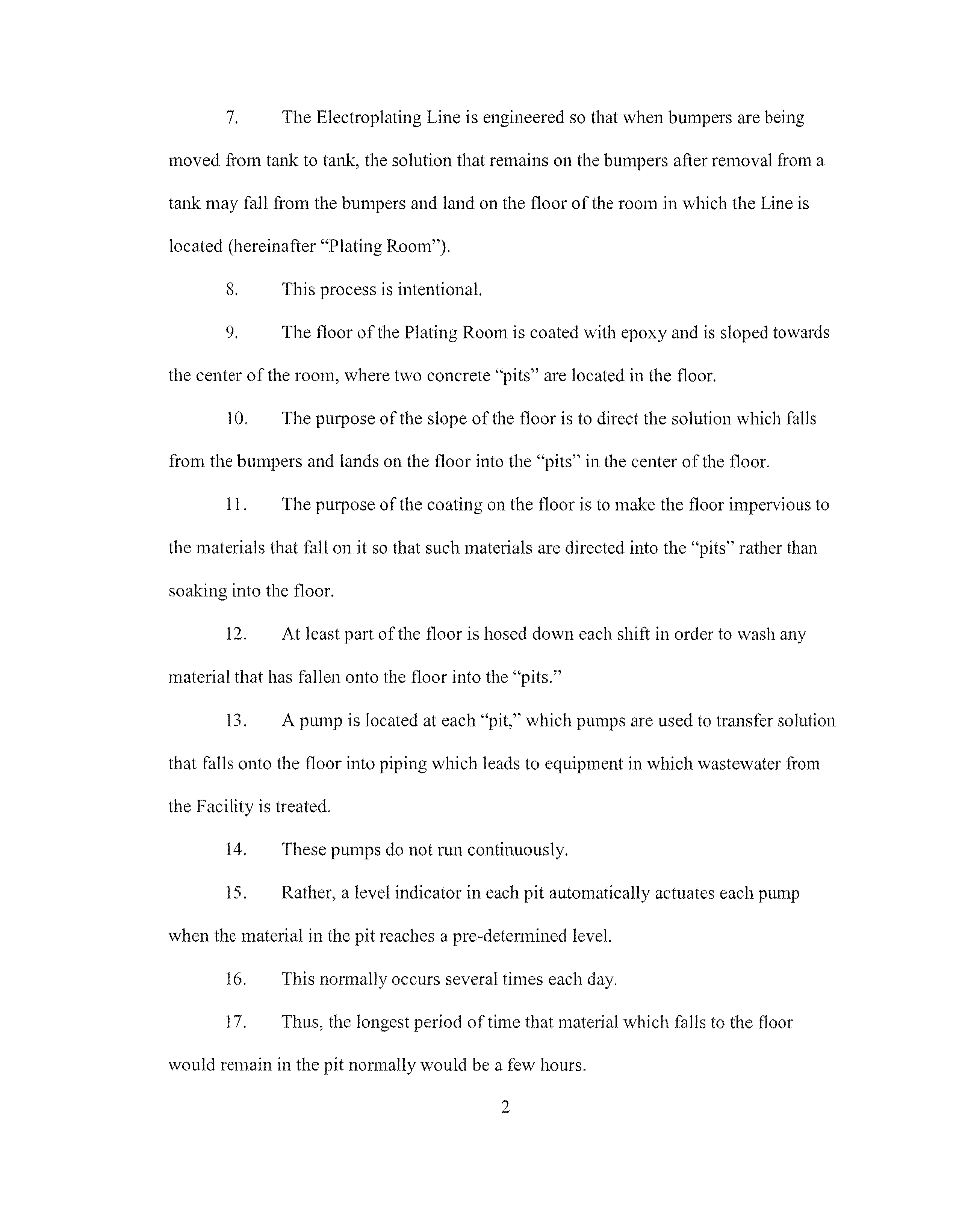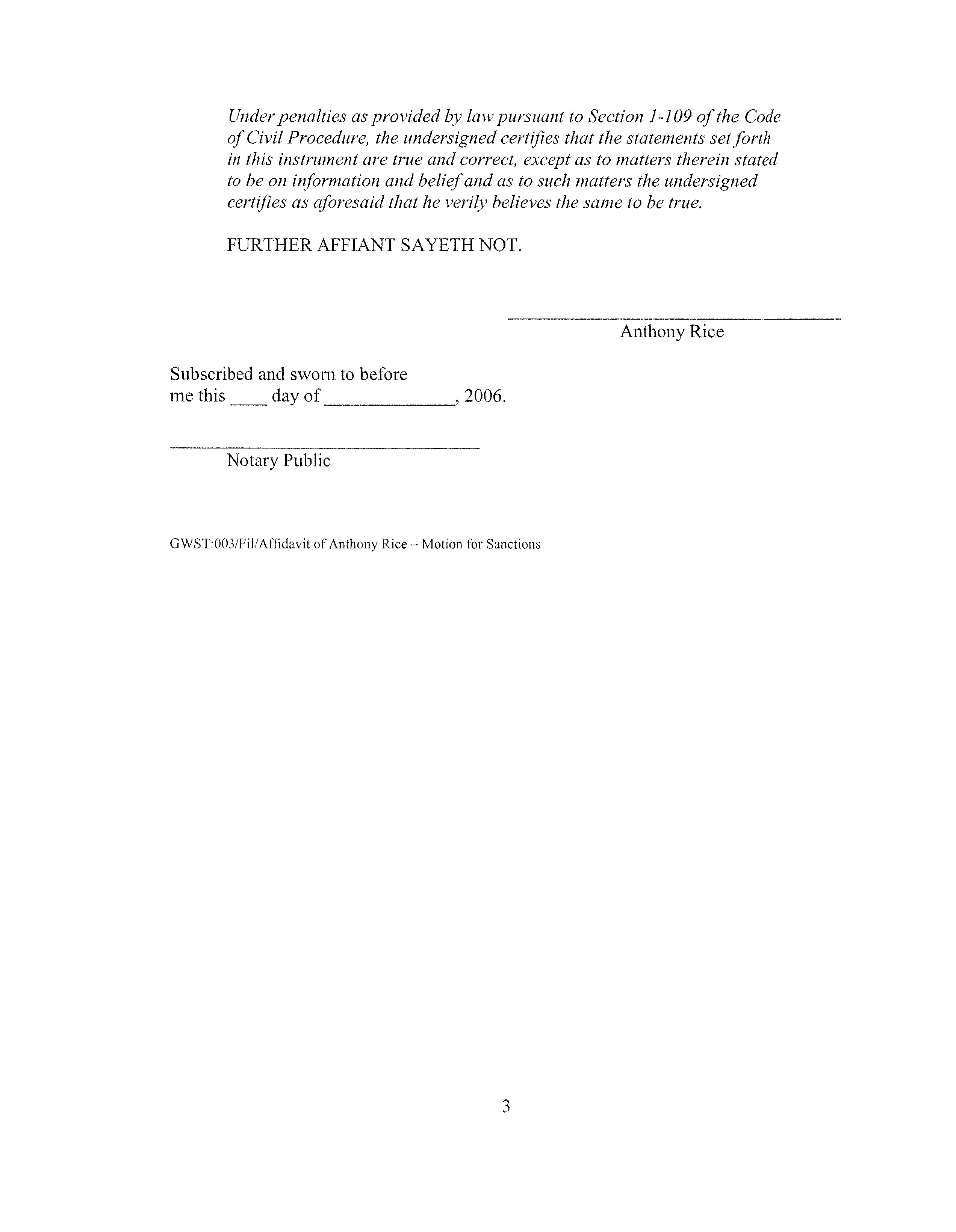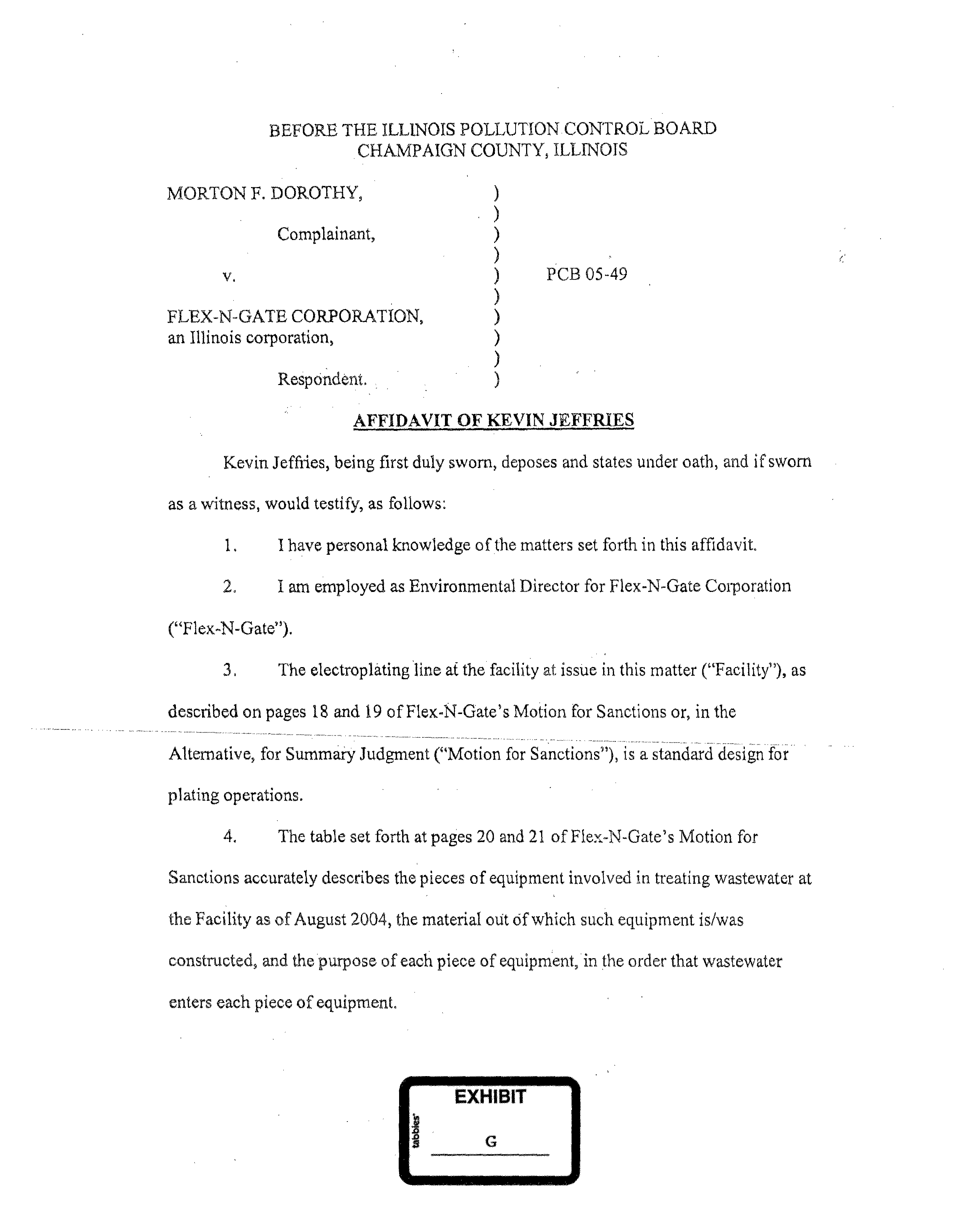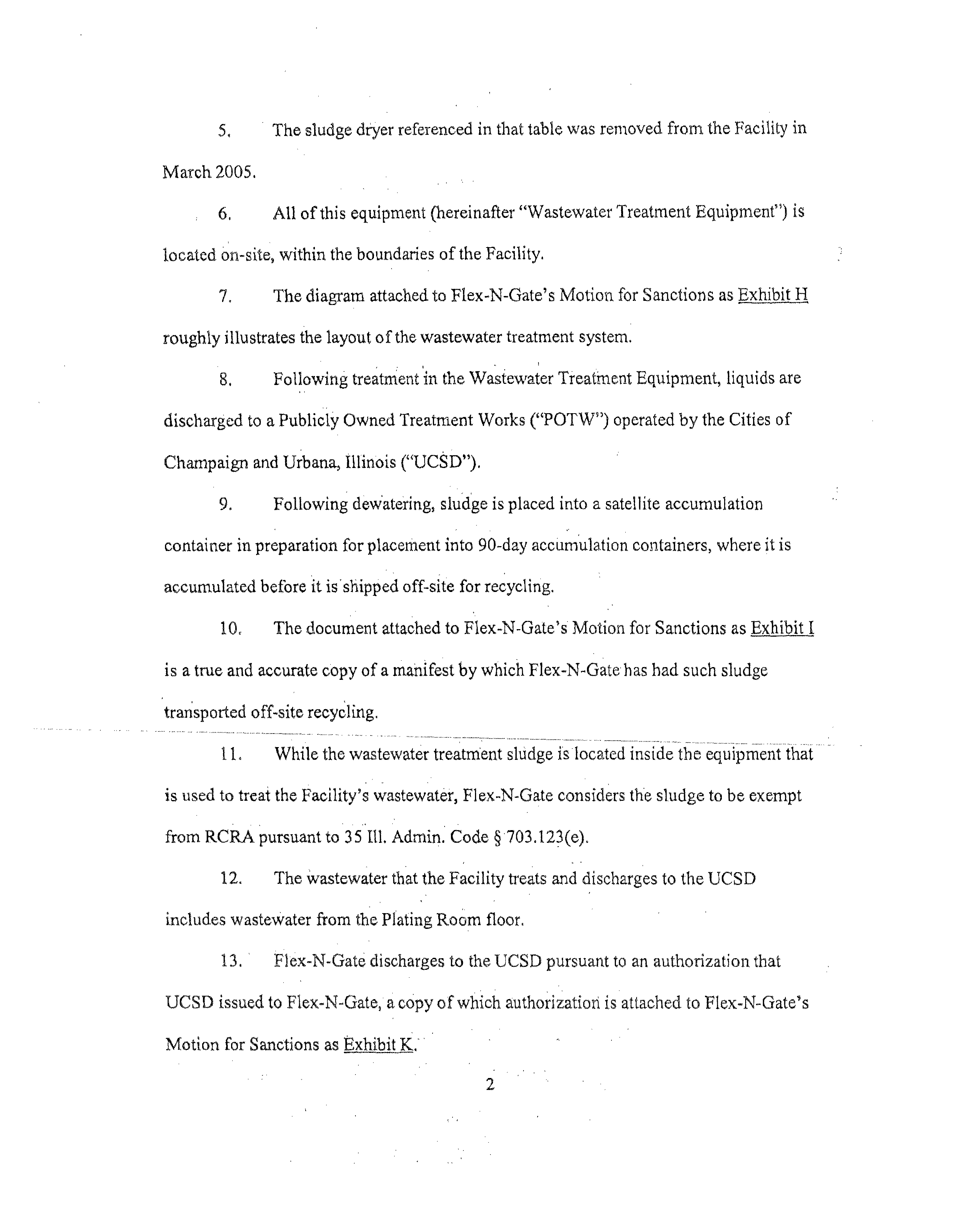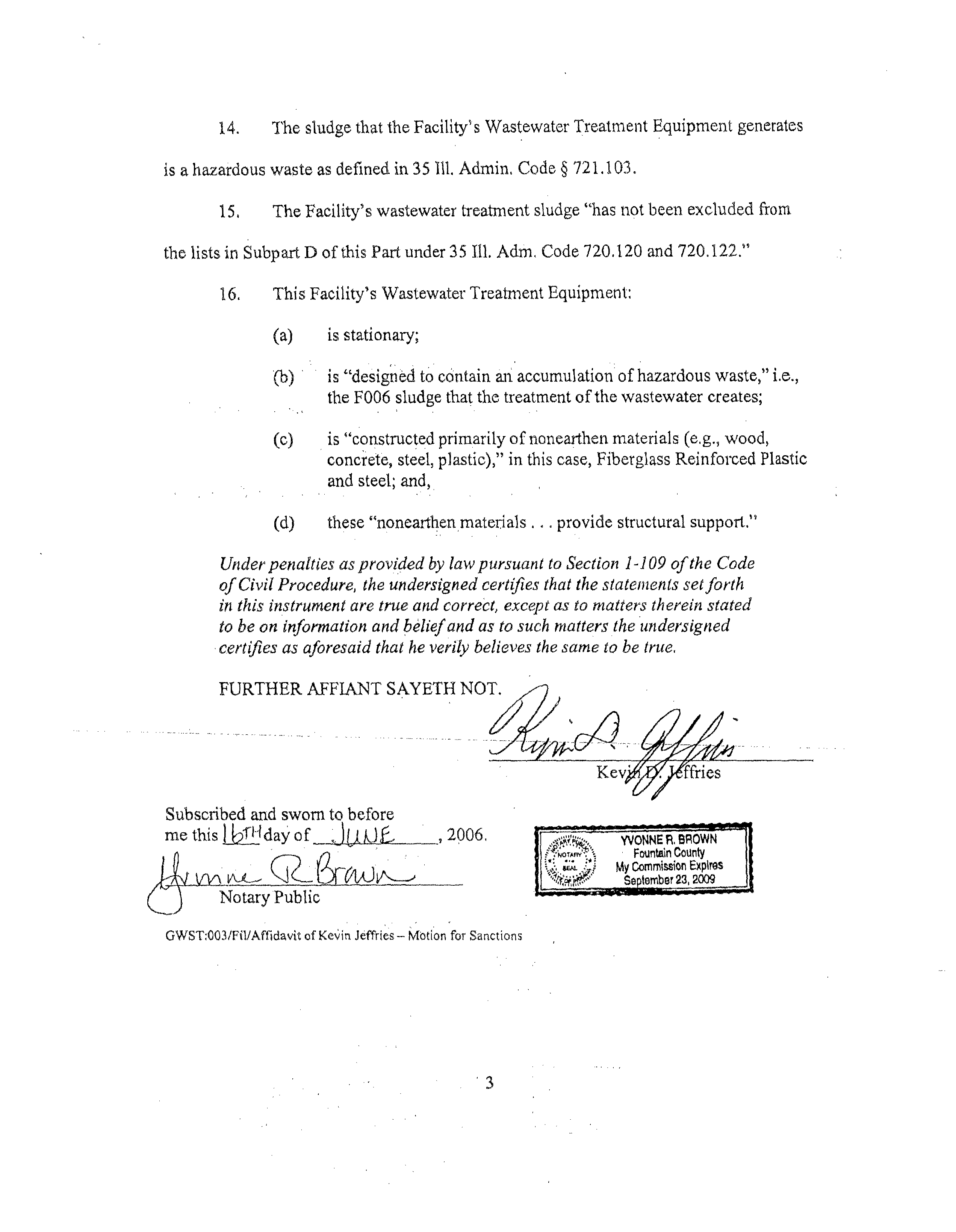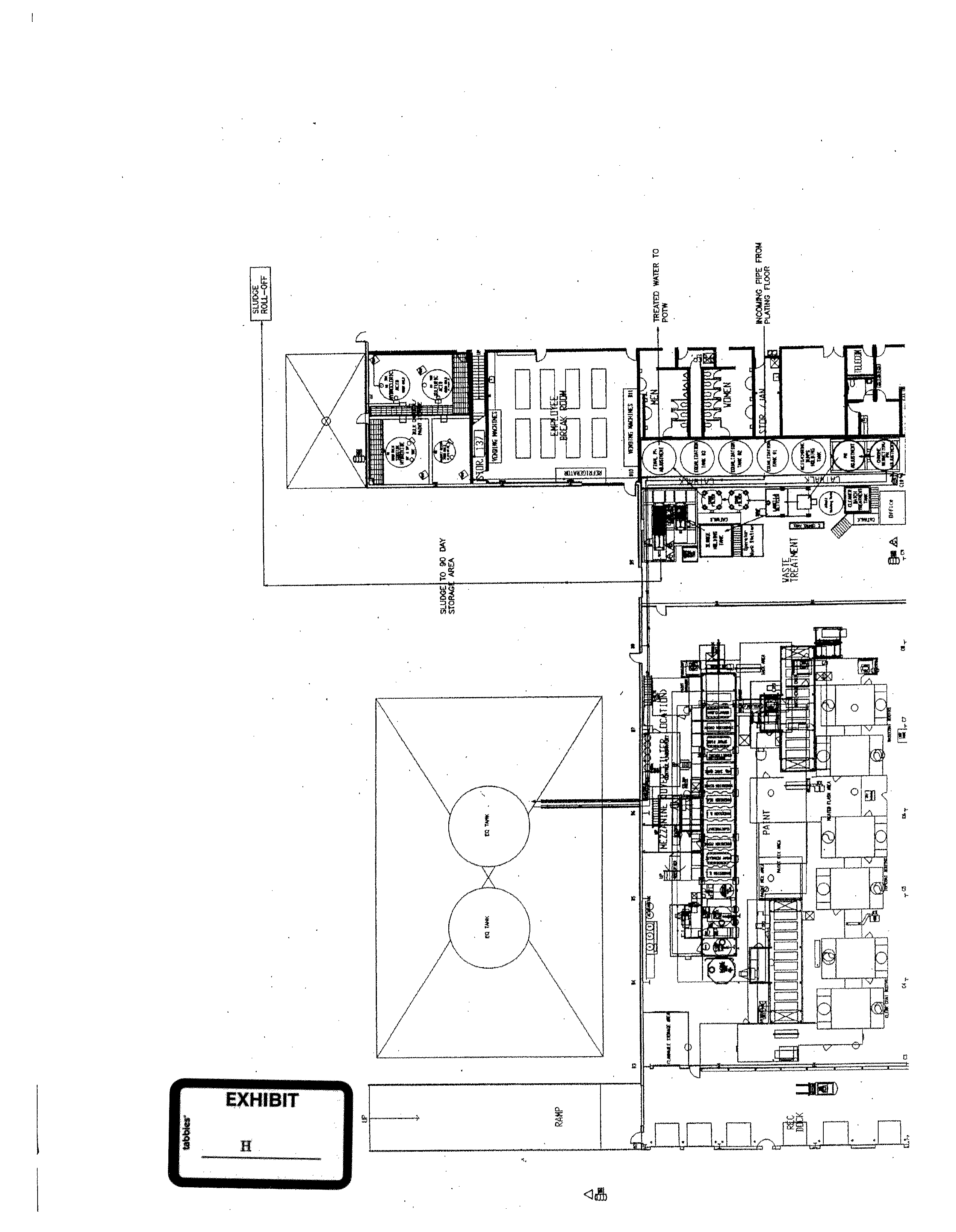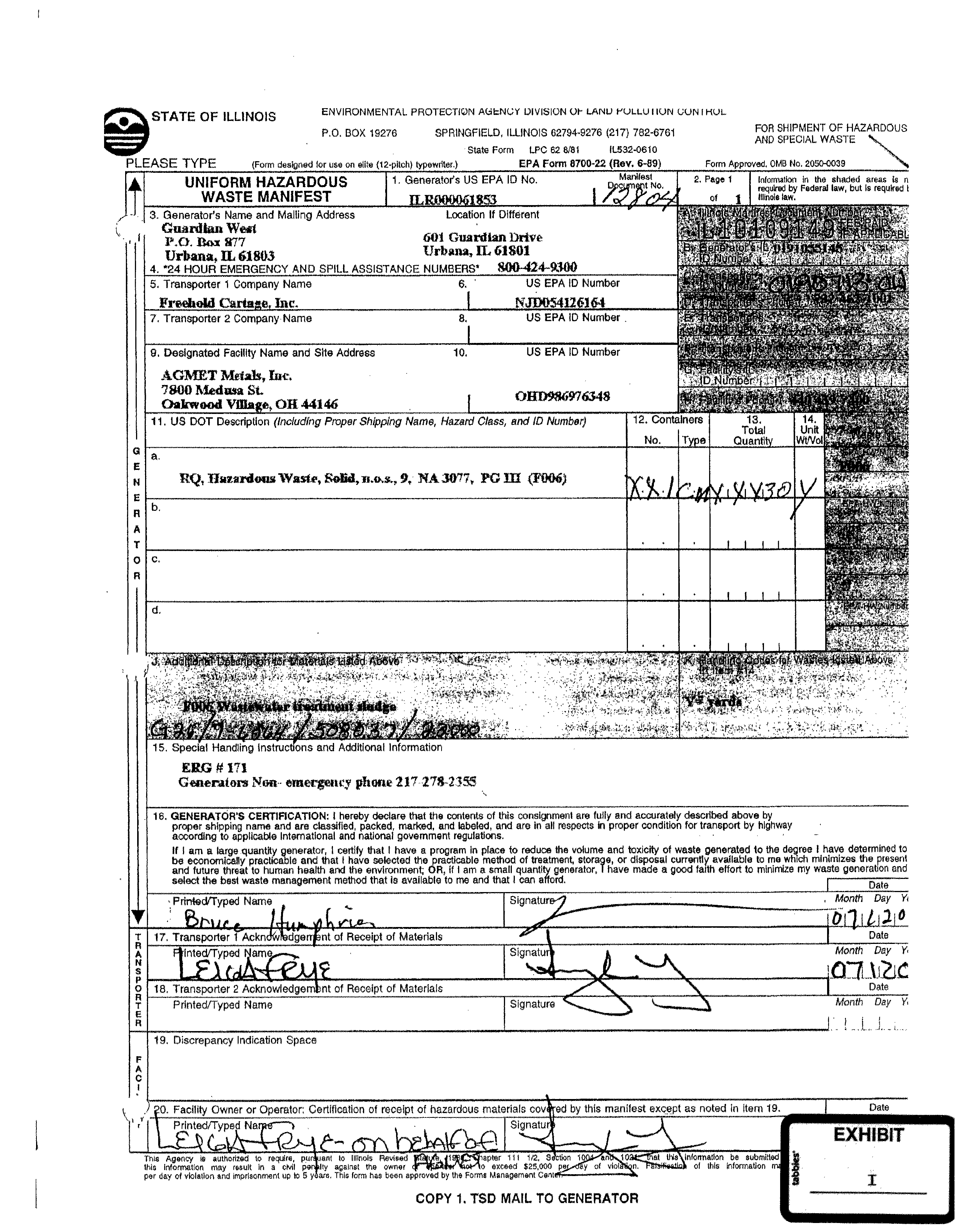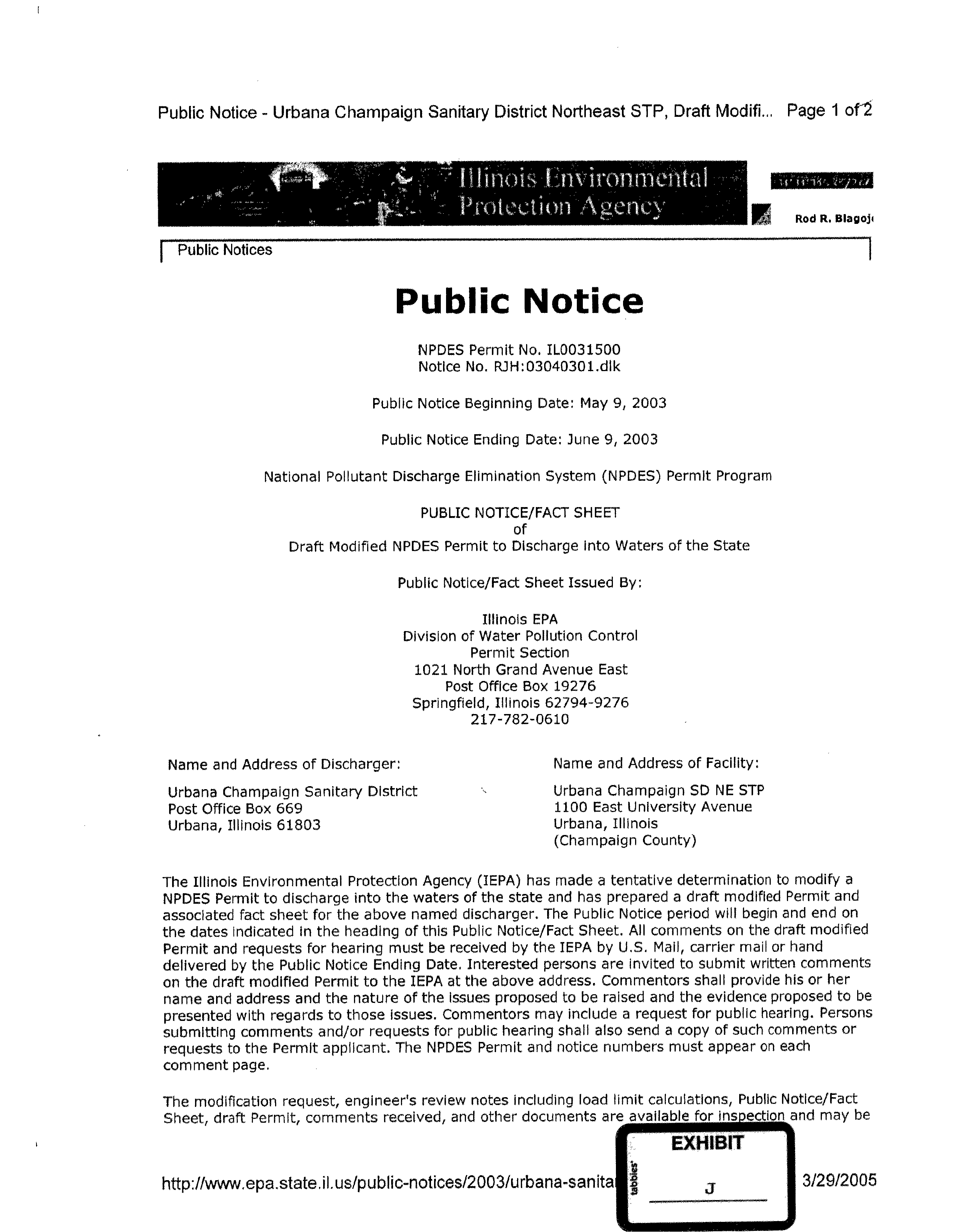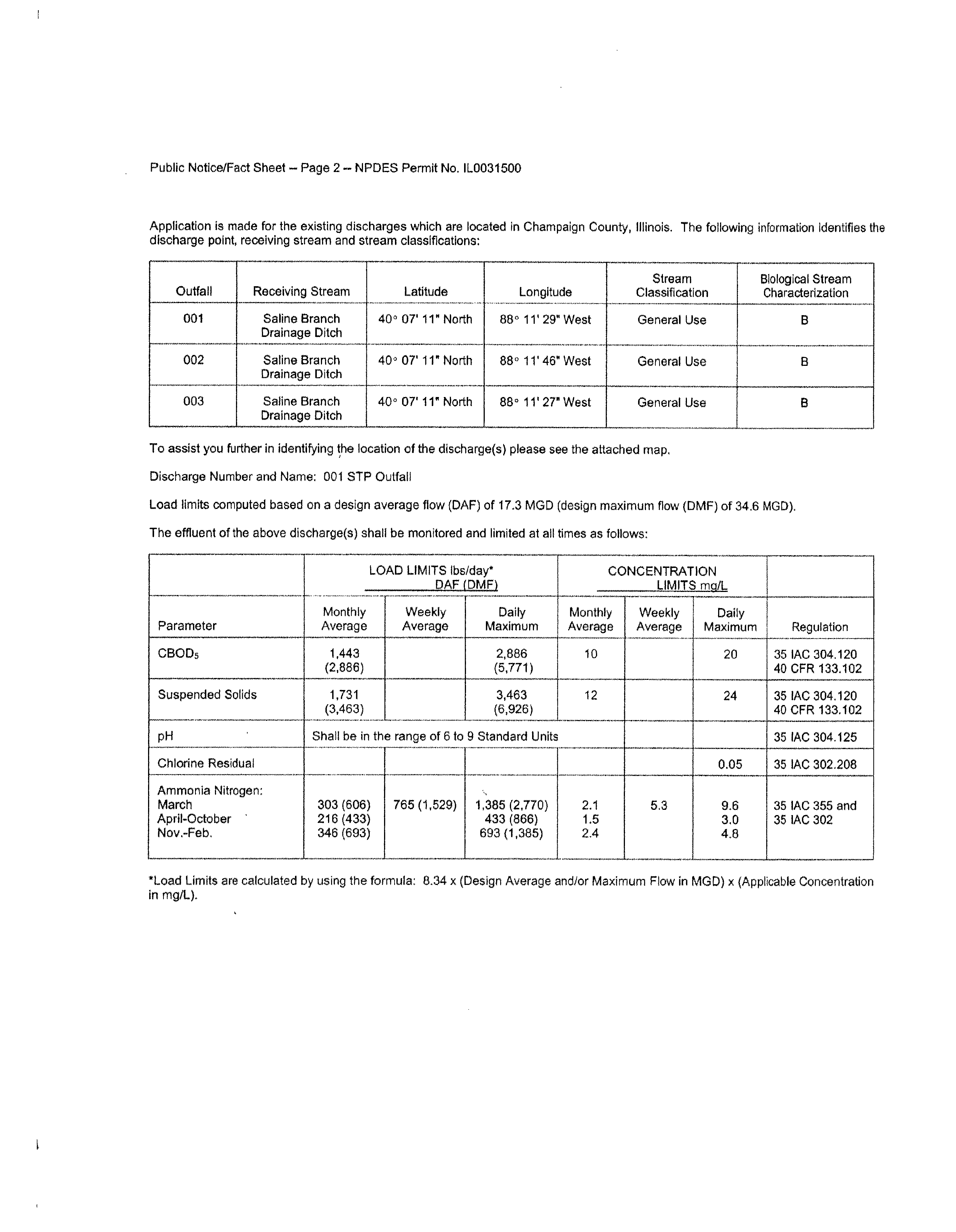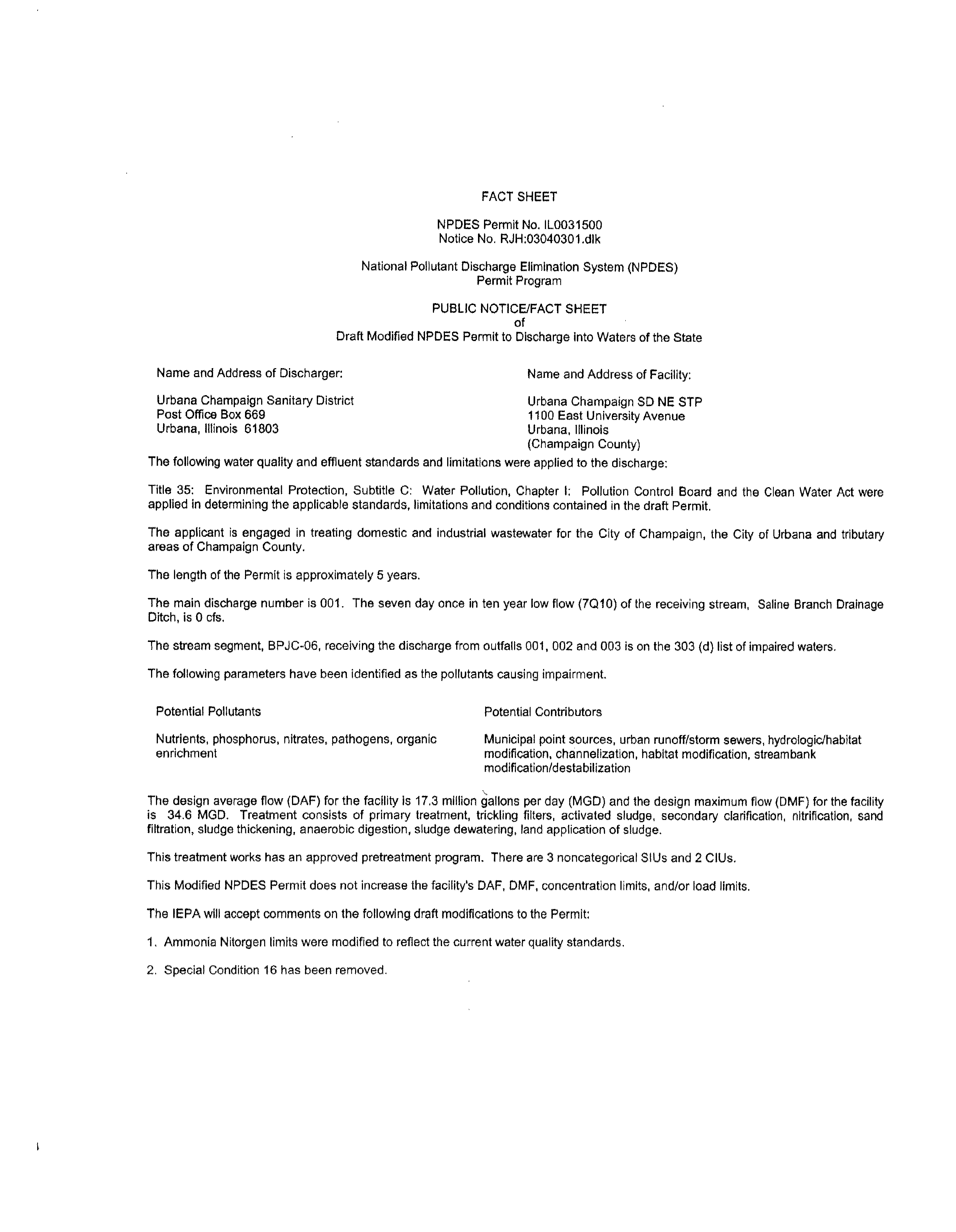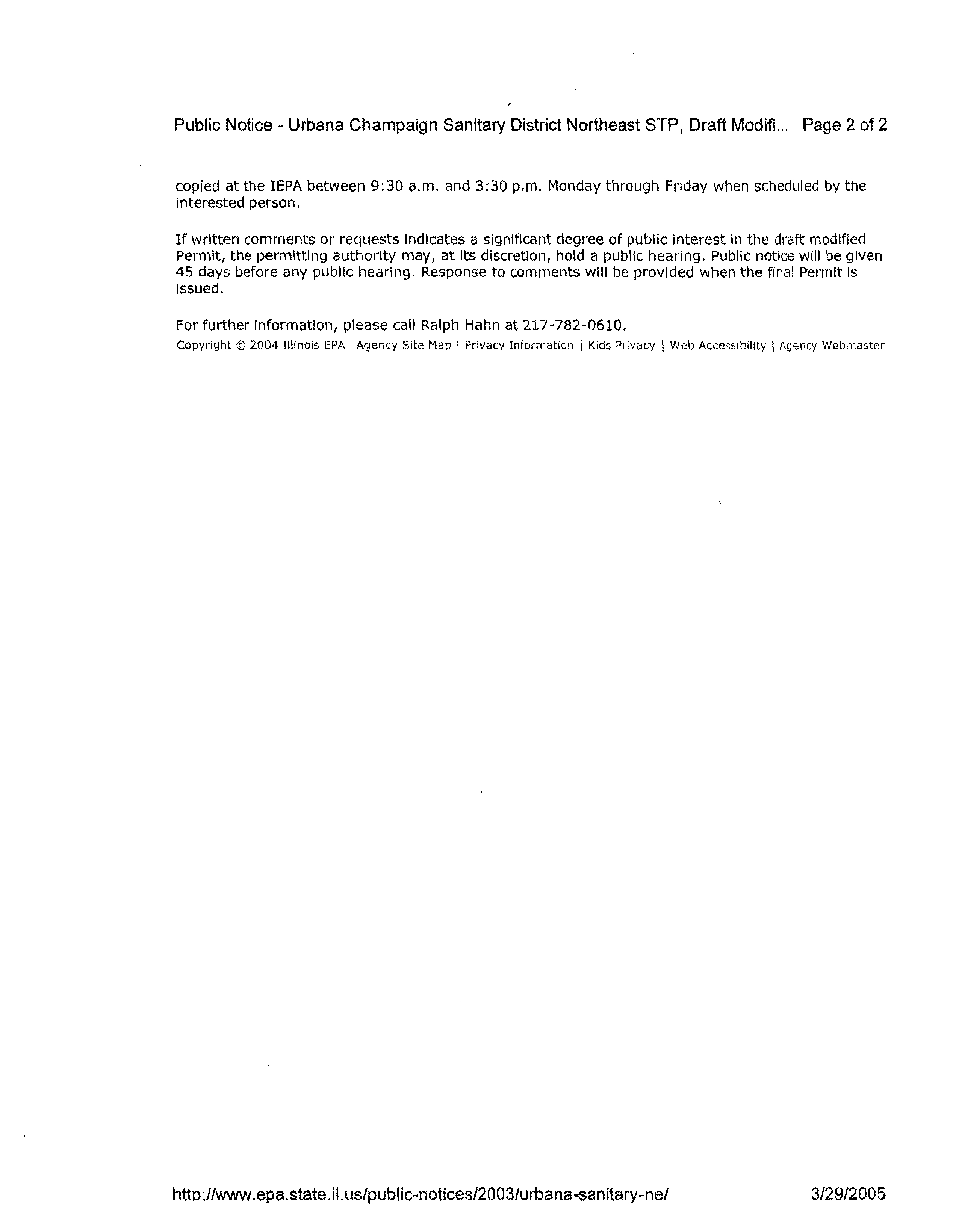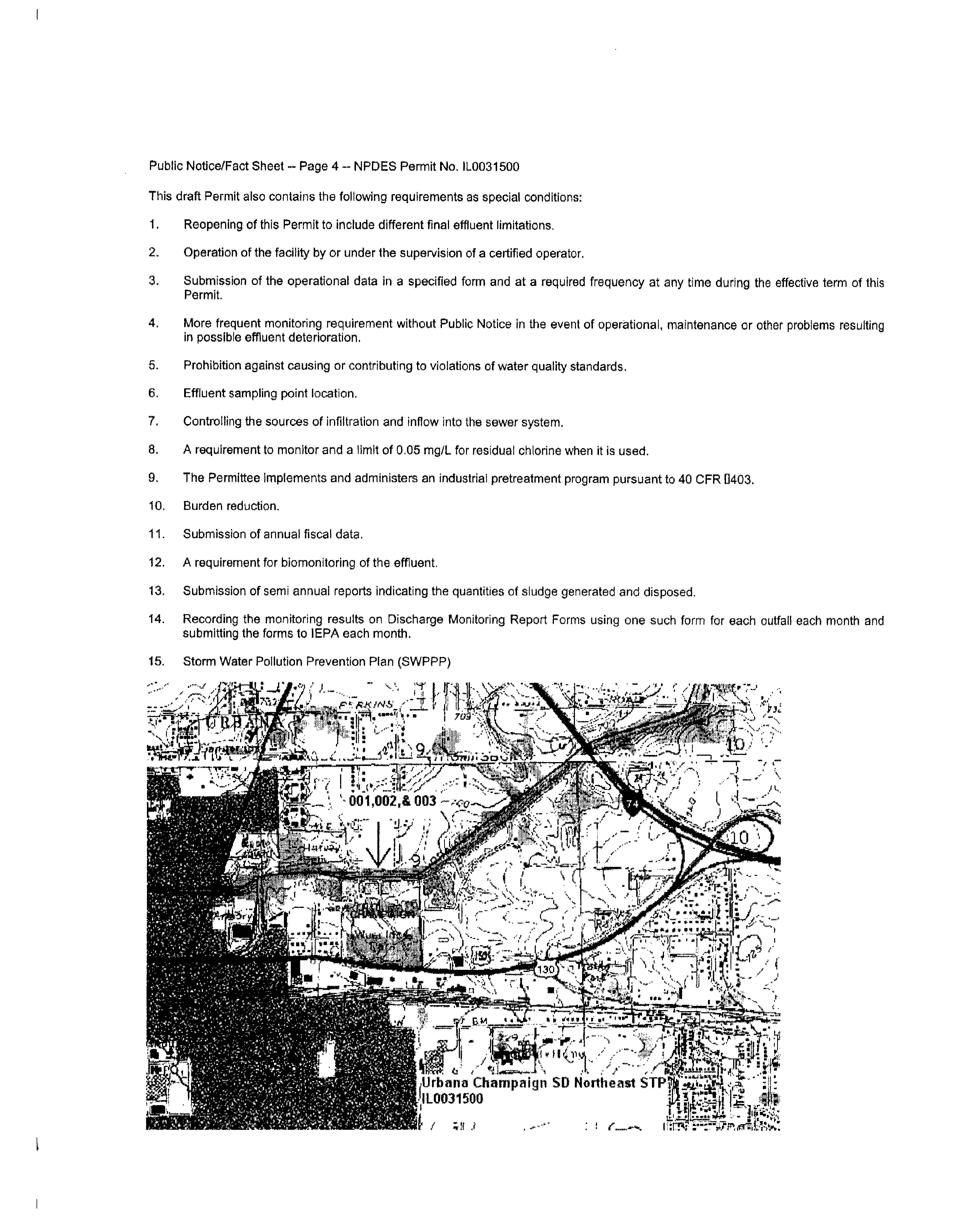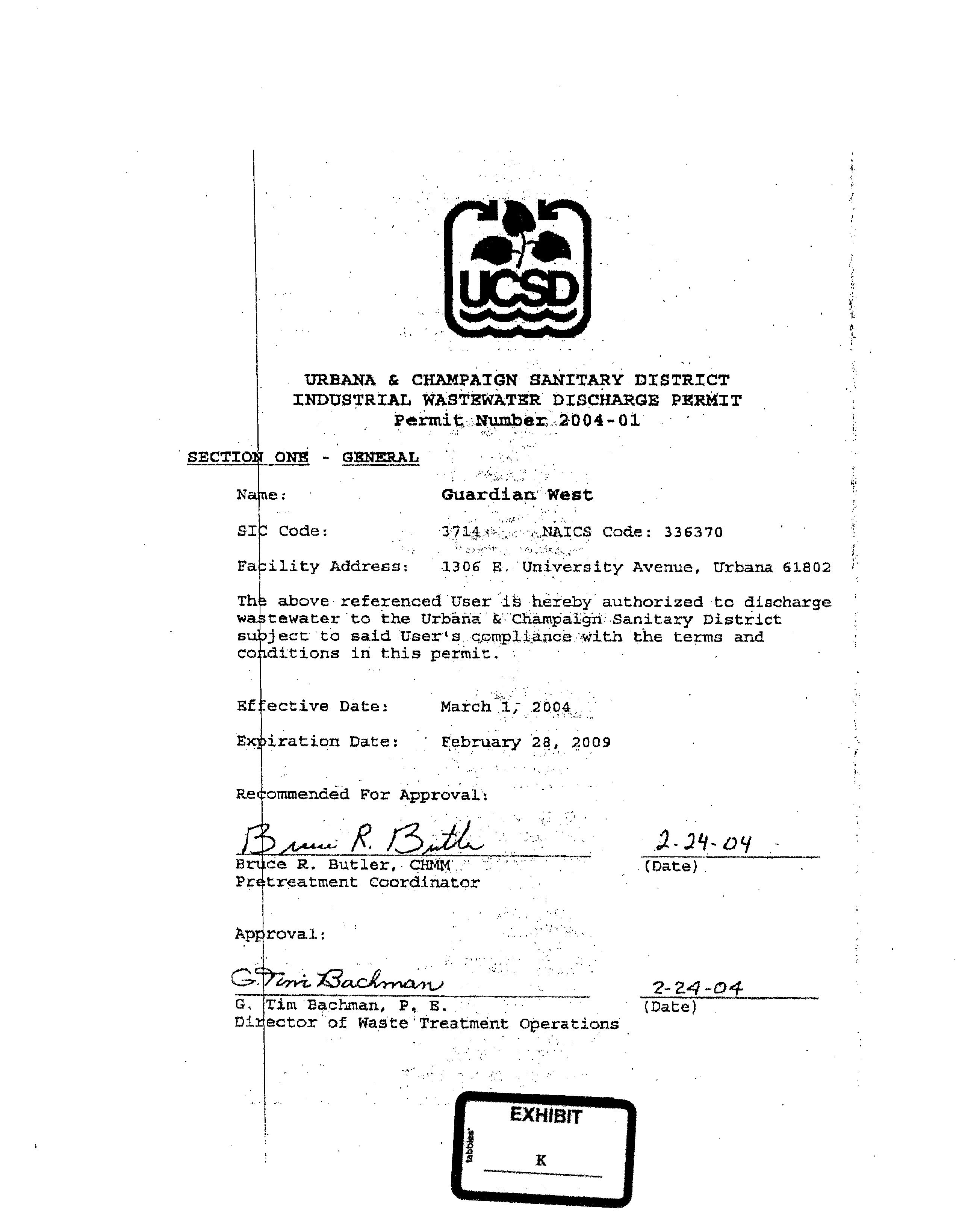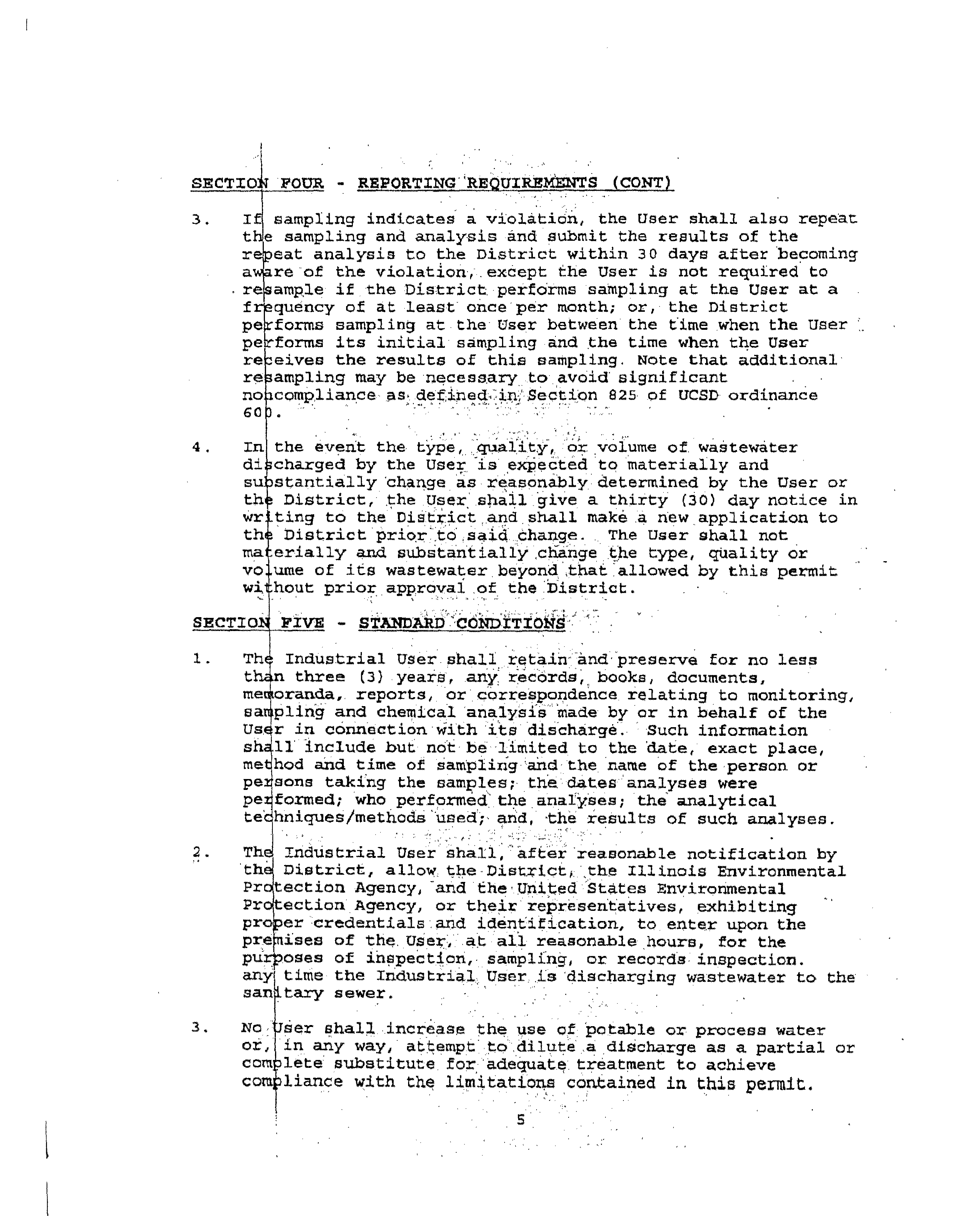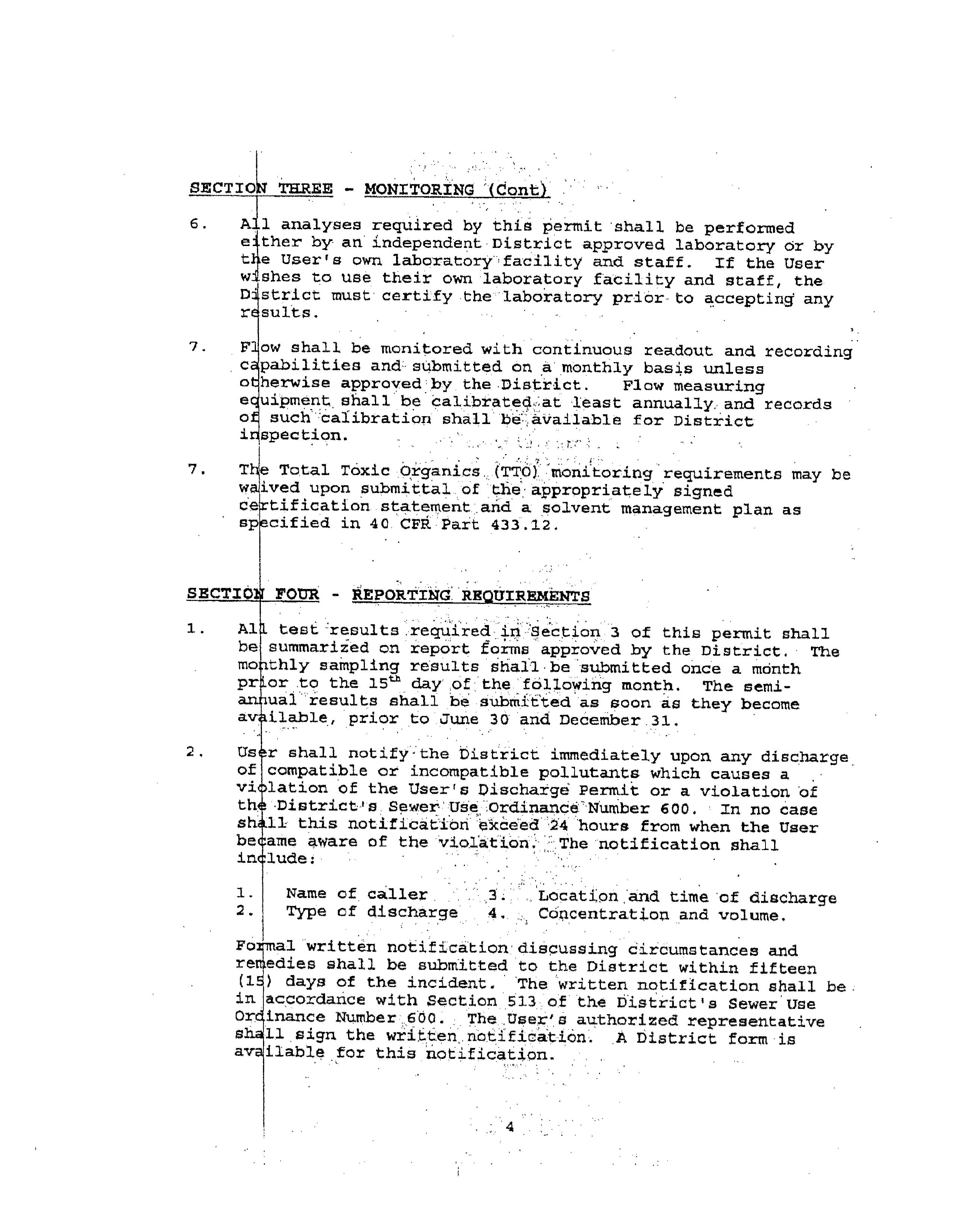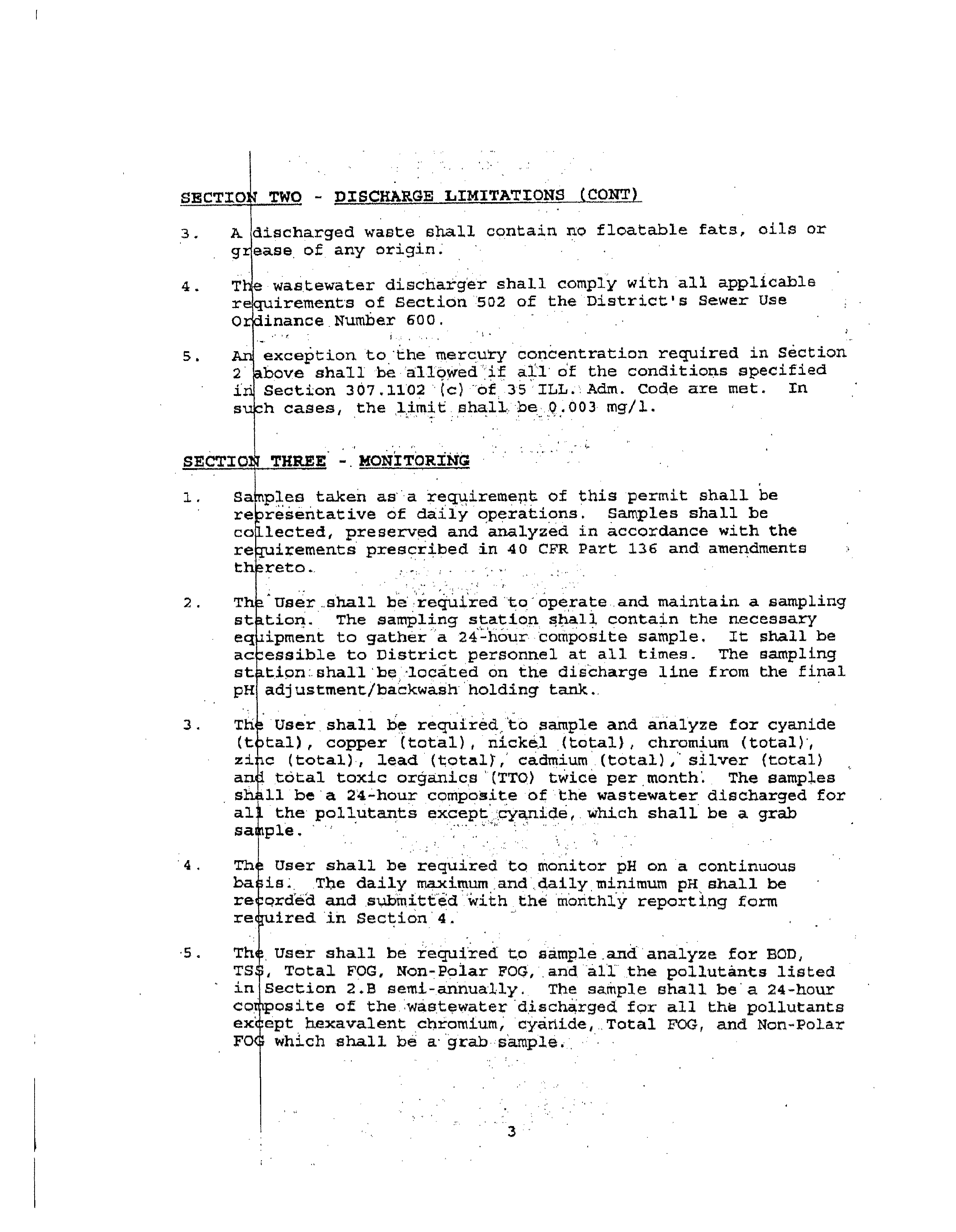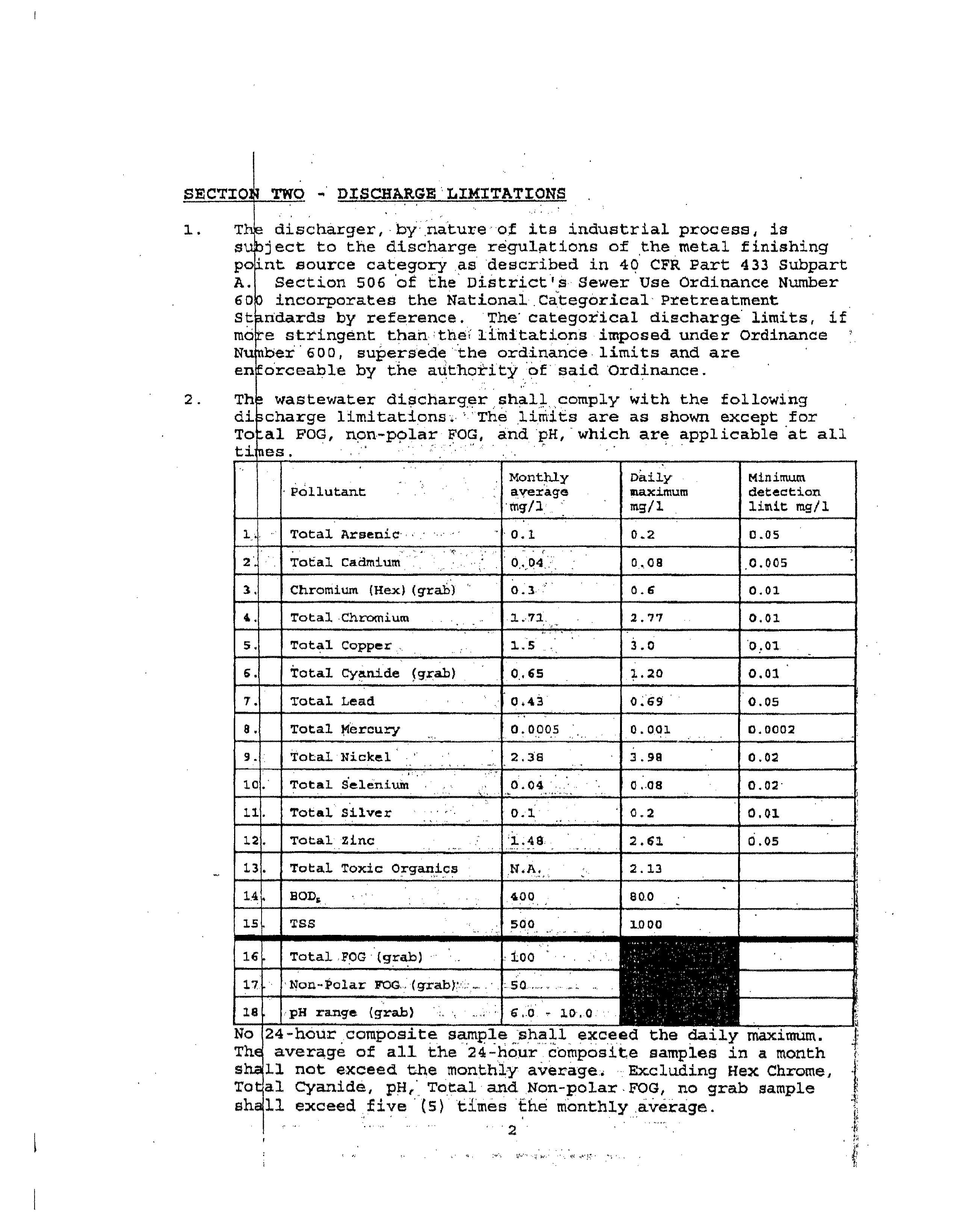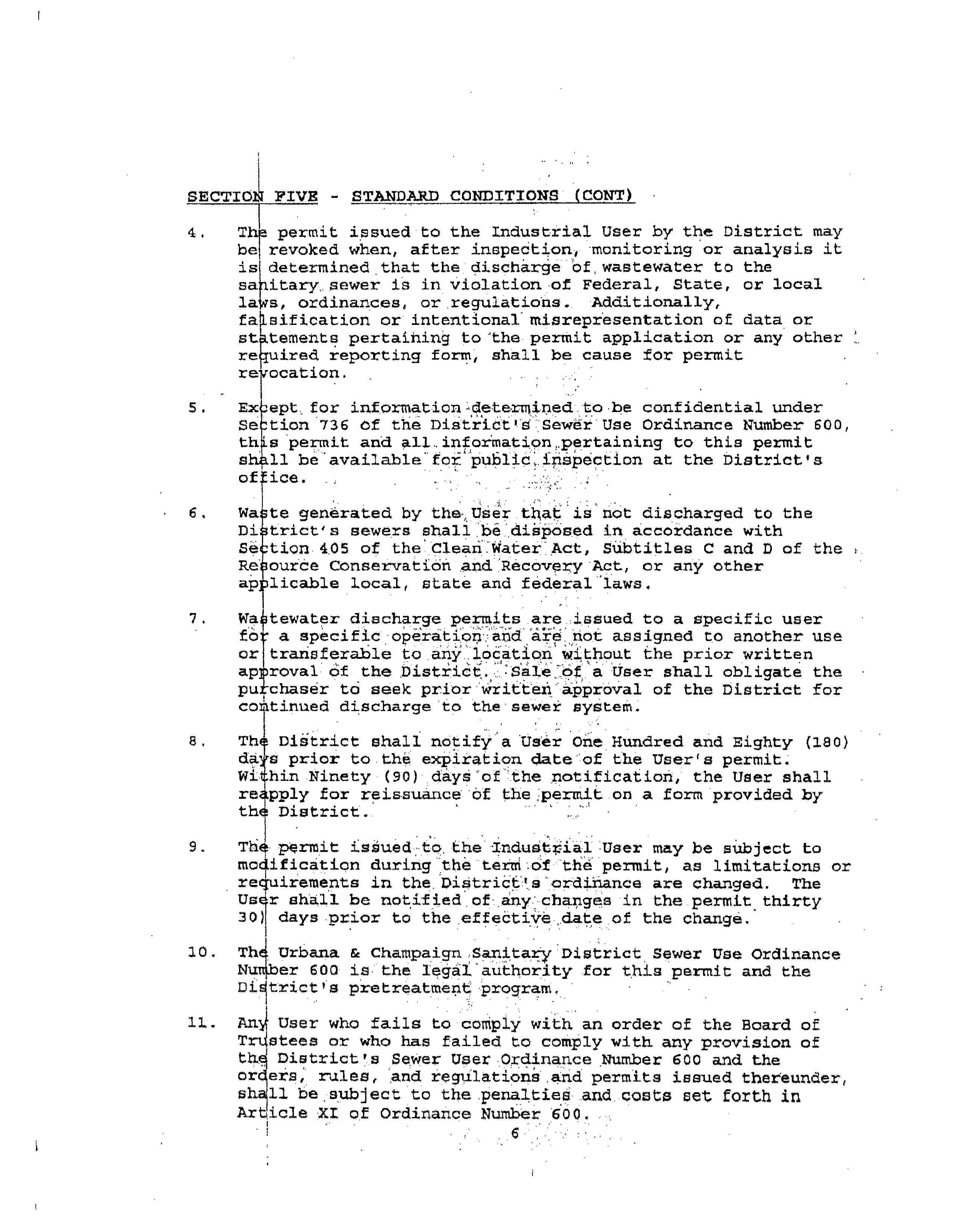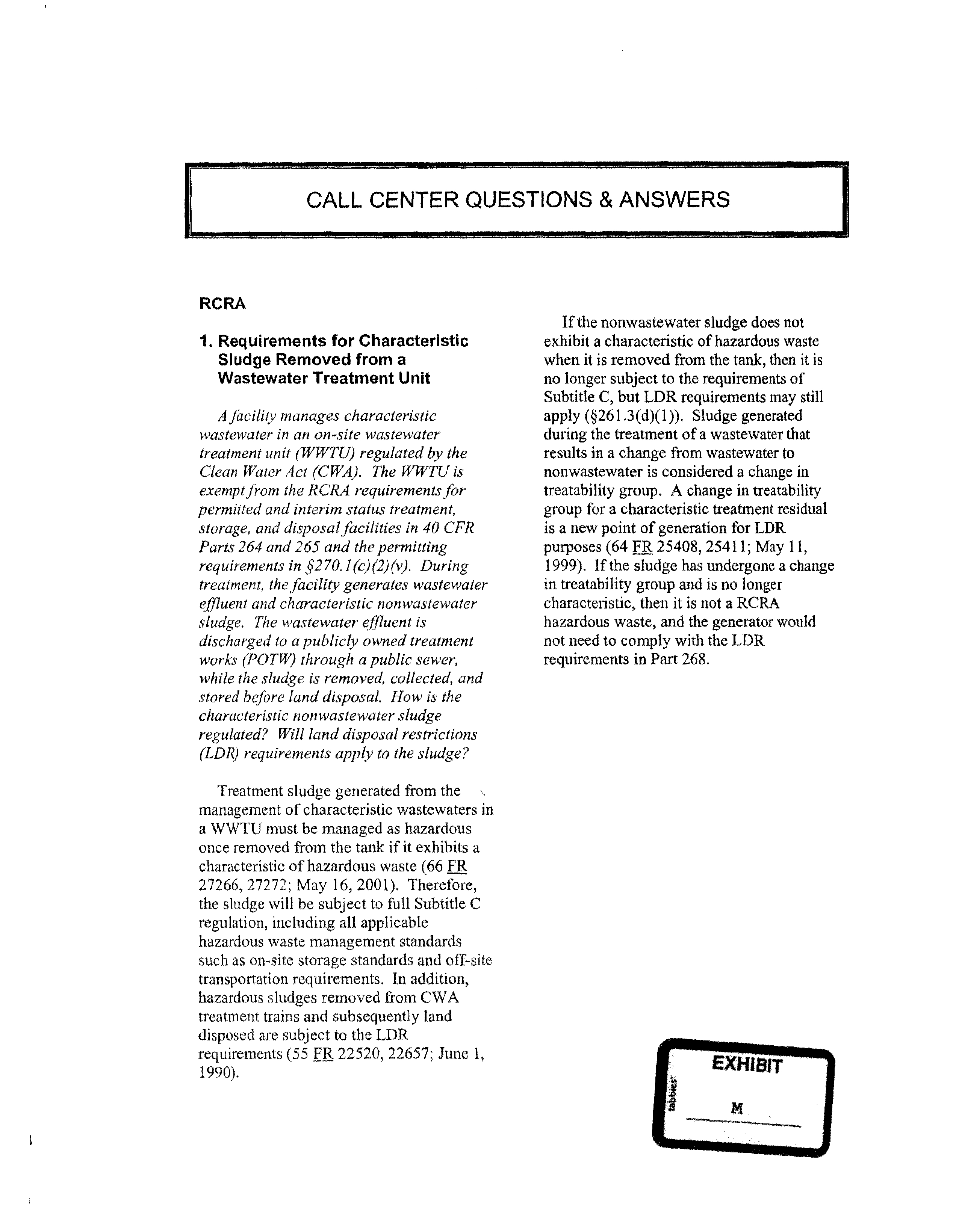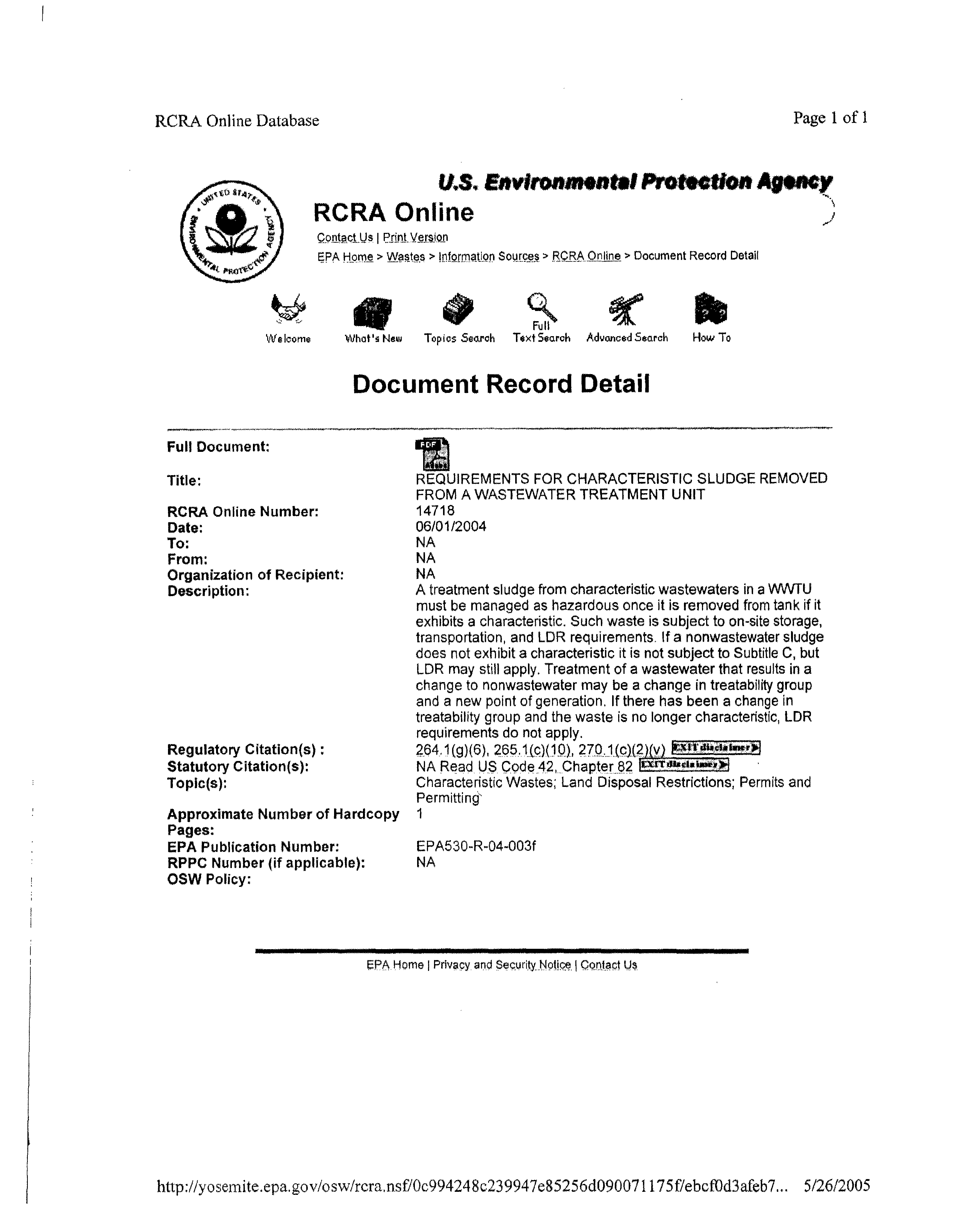THIS FILING SUBMITTED ON RECYCLED PAPER
BEFORE THE ILLINOIS POLLUTION CONTROL BOARD
MORTON F. DOROTHY,
)
)
Complainant,
)
)
v.
)
PCB No. 05-49
)
FLEX-N-GATE CORPORATION,
)
an Illinois corporation,
)
)
Respondent.
)
NOTICE OF FILING
TO:
Ms. Dorothy M. Gunn
Carol Webb, Esq.
Clerk of the Board
Hearing Officer
Illinois Pollution Control Board
Illinois Pollution Control Board
100 West Randolph Street
1021 North Grand Avenue East
Suite 11-500
Post Office Box 19274
Chicago, Illinois 60601
Springfield, Illinois 62794-9274
(VIA ELECTRONIC MAIL)
(VIA ELECTRONIC MAIL)
PLEASE TAKE NOTICE that I have today filed with the Office of the Clerk of
the Illinois Pollution Control Board Flex-N-Gate Corporation’s
MOTION FOR
SANCTIONS OR, IN THE ALTERNATIVE, FOR SUMMARY JUDGMENT,
a
copy of which is herewith served upon you.
Respectfully submitted,
FLEX-N-GATE CORPORATION,
Respondent,
By:/s/ Thomas G. Safley
One of Its Attorneys
Dated: June 19, 2006
Thomas G. Safley
HODGE DWYER ZEMAN
3150 Roland Avenue
Post Office Box 5776
Springfield, Illinois 62705-5776
(217) 523-4900
ELECTRONIC FILING, RECEIVED, CLERK'S OFFICE, JUNE 19, 2006
CERTIFICATE OF SERVICE
I, Thomas G. Safley, the undersigned, certify that I have served the attached
MOTION FOR SANCTIONS OR, IN THE ALTERNATIVE, FOR SUMMARY
JUDGMENT upon:
Ms. Dorothy M. Gunn
Clerk of the Board
Illinois Pollution Control Board
100 West Randolph Street
Suite 11-500
Chicago, Illinois 60601
Carol Webb, Esq.
Hearing Officer
Illinois Pollution Control Board
1021 North Grand Avenue East
Post Office Box 19274
Springfield, Illinois 62794-9274
via electronic mail on June 19, 2006; and upon:
Mr. Morton F. Dorothy
104 West University, SW Suite
Urbana, Illinois 61801
by depositing said documents in the United States Mail in Springfield, Illinois, postage
prepaid, on June 19, 2006
/s/ Thomas G. Safley
Thomas G. Safley
GWST:003/Fil/NOF and COS – Motion for Sanctions
ELECTRONIC FILING, RECEIVED, CLERK'S OFFICE, JUNE 19, 2006
BEFORE THE ILLINOIS POLLUTION CONTROL BOARD
MORTON F. DOROTHY,
)
)
Complainant,
)
)
v.
)
PCB 05-49
)
FLEX-N-GATE CORPORATION,
)
an Illinois corporation,
)
)
Respondent.
)
MOTION FOR SANCTIONS OR,
IN THE ALTERNATIVE, FOR SUMMARY JUDGMENT
NOW COMES Respondent, FLEX-N-GATE CORPORATION (“Flex-N-Gate”),
by and through its attorneys, HODGE DWYER ZEMAN, pursuant to 35 Ill. Admin.
Code §§ 101.500 and 101.800, and for its Motion for Sanctions or, in the Alternative, for
Summary Judgment, states as follows:
I.
INTRODUCTION
As set forth in detail below, following the Illinois Pollution Control Board’s
(“Board”) October 20, 2005 Order (“Board Oct. 20 Order”) in this matter, Flex-N-Gate
filed an Amended Answer asserting as an Affirmative Defense that its management of
hazardous waste was exempt from permitting requirements. Flex-N-Gate also served
discovery on Complainant seeking to discover the basis of any factual disagreement
between the parties with regard to that issue. Complainant failed to validly respond to
that discovery. Flex-N-Gate filed a Motion to Compel. The Hearing Officer granted that
Motion. Complainant, in violation of the Hearing Officer’s Order, continued to fail to
validly respond to Flex-N-Gate’s discovery. In light of these actions, and Complainant’s
ELECTRONIC FILING, RECEIVED, CLERK'S OFFICE, JUNE 19, 2006
2
other actions in this matter, the Board should sanction Complainant by dismissing Count
I of his Complaint.
Alternatively, the Board should grant Flex-N-Gate Summary Judgment on its
Affirmative Defense. Complainant has, through discovery requests that he did answer,
clarified that Count I of his Complaint is “restricted to the issue of whether Respondent
has violated the storage time requirements for hazardous waste under the catwalk.” As is
explained below, any “hazardous waste under the catwalk” at Flex-N-Gate’s facility is
contained within a Wastewater Treatment Unit (“WWTU”). There is no accumulation
time limit for waste contained in a WWTU.
II.
THE BOARD MUST SANCTION COMPLAINANT FOR HIS
DISREGARD OF, AND FAILURE TO COMPLY WITH, THE HEARING
OFFICER’S ORDER COMPELLING HIM TO RESPOND TO
DISCOVERY, AND HIS OTHER ACTIONS.
A.
Background
On May 27, 2005, Flex-N-Gate filed its Motion for Summary Judgment as to All
Counts of Complainant’s Complaint (“Motion for Complete Summary Judgment”). As to
Count I of Complainant’s Complaint, Flex-N-Gate sought summary judgment on the
grounds that its management of hazardous waste is conducted pursuant to exemptions
from permitting requirements, and therefore that no permit is required for Flex-N-Gate’s
facility under the Resource Conservation and Recovery Act (“RCRA”), 42 U.S.C. §
6901,
et seq
. See
Flex-N-Gate’s Motion for Complete Summary Judgment at 19-34.
On October 20, 2005, the Board issued an Order granting Flex-N-Gate summary
judgment as to Counts II through VI of Complainant’s Complaint (pursuant to a separate
Motion for Summary Judgment that Flex-N-Gate also filed on May 27, 2005), but
ELECTRONIC FILING, RECEIVED, CLERK'S OFFICE, JUNE 19, 2006
3
denying Flex-N-Gate’s Motion for Complete Summary Judgment. With regard to Flex-
N-Gate’s argument as to Count I, the Board’s Order stated:
Therefore, under the Act and the Board’s RCRA regulations, the
determination as to whether a facility requires a RCRA permit depends on
site-specific facts related to the facility’s waste generation and handling.
As discussed in more detail below, because the parties disagree on whether
Flex-N-Gate met all of the necessary requirements, the Board finds a
genuine issue of material fact exists.
*
*
*
The Board agrees with complainant Mr. Dorothy that Flex-N-Gate bears
the burden to prove it is exempt from the requirement to obtain a RCRA
permit or interim status.
In seeking to meet that burden, Flex-N-Gate states that one of its
hazardous wastestreams is treated by equipment that meets the definition
of a WWTU and that this wastestream is exempt while it remains within
the WWTU. Flex-N-Gate states the remaining hazardous wastestreams are
exempt under the accumulation exemption because the wastes are
accumulated in containers before being transported off-site for treatment,
storage, or disposal.
Mr. Dorothy claims that Flex-N-Gate does not comply with the all of the
regulations applicable to generators. For example, Mr. Dorothy disputes
that the equipment Flex-N-Gate uses to treat one of its wastestreams
meets the definition of a WWTU. Mr. Dorothy also alleges that Flex-N-
Gate accumulated hazardous waste for longer than the time limits allowed
in Section 722.134.
Board October 20 Order at 14, 16-17.
In its October 20, 2005, Order, the Board also held that the question of whether a
party’s management of hazardous waste is allowed by an exemption to the RCRA permit
requirement must be pled as an affirmative defense, and allowed Flex-N-Gate to amend
its Answer to state such an affirmative defense. Id.
at 19-20. In light of this Order, Flex-
N-Gate on November 15, 2005, filed its Amended Answer, which asserted as an
affirmative defense that Flex-N-Gate is exempt from the RCRA permit requirement, in
ELECTRONIC FILING, RECEIVED, CLERK'S OFFICE, JUNE 19, 2006
4
part under RCRA’s WWTU exemption. See Flex-N-Gate’s Amended Answer at 11-14.
Complainant never filed any response to Flex-N-Gate’s Affirmative Defense.
In addition, in an attempt to understand what issues of material fact might exist
between Flex-N-Gate and Complainant on this issue
?
in order to enable Flex-N-Gate to
prepare for hearing accordingly
?
Flex-N-Gate served discovery requests on
Complainant. Specifically, on January 18, 2006, Flex-N-Gate served its Interrogatories
and Requests for Production on Complainant, copies of which are attached hereto as
Exhibits A
and B.
On February 14, 2006, Complainant provided his “Response” to Flex-N-Gate’s
Interrogatories, a copy of which is attached hereto as Exhibit C
. However, Complainant
refused to answer the majority of Flex-N-Gate’s Interrogatories, in part based on the
assertion that Flex-N-Gate had never raised the WWTU exemption
?
despite Flex-N-
Gate’s Affirmative Defense doing exactly that
?
and in part relying on baseless
objections. See, e.g., Exhibit C at 2, “answer” to Interrogatory No. 5. Furthermore,
Complainant failed to respond at all to Flex-N-Gate’s Requests for Production.
On April 13, 2006, after repeated attempts to secure Complainant’s cooperation,
Flex-N-Gate filed its Motion to Compel. See
Flex-N-Gate’s Motion to Compel and the
communications between Flex-N-Gate’s counsel and Complainant attached thereto as
exhibits. Complainant filed no Response to that Motion, and on May 9, 2006, the
Hearing Officer granted the Motion, ordering Complainant to answer Flex-N-Gate’s
discovery requests.
ELECTRONIC FILING, RECEIVED, CLERK'S OFFICE, JUNE 19, 2006
5
Complainant has since produced documents in response to Flex-N-Gate’s
Requests for Production. These documents, which were due on February 14, 2006, were
ultimately received on May 11, 2006. In addition, on May 11, 2006, Flex-N-Gate
received Complainant’s “Amended Response” to the Interrogatories propounded on
January 18, 2006. See
Amended Response to Interrogatories, a copy of which has been
attached hereto as Exhibit D
.
In his “Amended Response,” Complainant has expressly violated the Hearing
Officer’s Order granting Flex-N-Gate’s Motion to Compel. Specifically, while
Complainant withdraws his contention that Flex-N-Gate had not raised the WWTU
exemption, Complainant continues to refuse to answer the majority of Flex-N-Gate’s
Interrogatories, asserting only the same groundless objections. See, e.g.
, Exhibit D at 2,
“amended answer” to Interrogatory No. 5.
Finally, on March 20, 2006, during a telephonic status conference, Complainant
indicated that he intended to file a Motion for Leave to Amend Complaint and asked the
Hearing Officer for time to do so. See
March 20, 2006, Hearing Officer Order. The
Hearing Officer granted Complainant sixty days, or until May 19, 2006, to file such a
Motion. Complainant never filed his Motion.
ELECTRONIC FILING, RECEIVED, CLERK'S OFFICE, JUNE 19, 2006
6
B.
THE BOARD MUST SANCTION COMPLAINANT FOR HIS
DISREGARD OF AND FAILURE TO COMPLY WITH THE
HEARING OFFICER’S ORDER AND HIS OTHER ACTIONS
.
It is axiomatic that the Board has authority to order sanctions against parties in
matters pending before it. Section 101.800(a) of the Board’s procedural rules provides in
relevant part that “[i]f any person unreasonably fails to comply with any provision of 35
Ill. Adm. Code 101 through 130 or any order entered by the Board or the hearing officer
,
including any subpoena issued by the Board, the Board may order sanctions.” 35 Ill.
Admin. Code § 101.800(a). (Emphasis added.)
Further, the Board’s procedural rules provide criteria for assessing the severity of
the sanction to impose. Specifically,
In deciding what sanction to impose the Board will consider factors
including: the relative severity of the refusal or failure to comply; the past
history of the proceeding; the degree to which the proceeding has been
delayed or prejudiced; and the existence or absence of bad faith on the part
of the offending party or person.
35 Ill. Admin. Code § 101.800(c).
Consideration of these factors makes it clear that the Board must impose a serious
sanction on Complainant.
1.
Complainant’s Actions in these Proceedings are Intolerable
and Demonstrate Bad Faith, Ultimately Prejudicing Flex-N-
Gate in Causing Unreasonable Delay, the Incurrence of
Otherwise Unnecessary Attorney’s Fees, and in Denying Flex-
N-Gate the Ability to Defend Itself.
a.
Complainant’s Refusals to Comply are Severe
.
Complainant’s refusals to comply with the Board’s rules and the Hearing
Officer’s Order are severe. First, for months, Complainant simply ignored Flex-N-Gate’s
ELECTRONIC FILING, RECEIVED, CLERK'S OFFICE, JUNE 19, 2006
7
Requests for Production. The Board’s rules of course require that parties respond to
discovery requests, at least with a valid objection. See, e.g.
, 35 Ill. Admin. Code §§
101.616, 101.620. However, Complainant did not pose any objection or seek any
extension of time with regard to the Requests for Production. He simply ignored them
and did not answer at all, until being compelled to do so.
Second, Complainant’s “response” to Flex-N-Gate’s Interrogatories blatantly
sought to avoid the requirements of the Board’s discovery rules. As discussed above,
when asked questions about Flex-N-Gate’s WWTU,
Complainant responded that Flex-N-
Gate had never argued that it had a WWTU, despite the fact that Flex-N-Gate had just
filed an Amended Answer asserting the WWTU exemption as an affirmative defense
(not
to mention the fact that Flex-N-Gate has raised the WWTU exemption throughout this
litigation). To interpose such a baseless “objection” is sanctionable. Further, as
discussed in Flex-N-Gate’s Motion to Compel, and as the Hearing Officer found by
granting that Motion, Complainant’s other objections were meritless as well.
Third, and most severely, after Flex-N-Gate was forced to file a Motion to
Compel, and the Hearing Officer granted that Motion,
Complainant ignored the Hearing
Officer’s Order and (with one exception) made the same objections to Flex-N-Gate’s
Interrogatories that he had made before
. If the Complainant will simply ignore the
Hearing Officer’s Orders, no other alternative exists but for the Board to sanction him.
ELECTRONIC FILING, RECEIVED, CLERK'S OFFICE, JUNE 19, 2006
8
b.
The Past History of this Proceeding Demonstrates that
Sanctions are Warranted.
The past history of this proceeding also demonstrates that the Board must sanction
Complainant.
As the Board is aware, because of Complainant’s previous actions in this case,
Flex-N-Gate was forced to move the Board:
(1)
to strike multiple improper affidavits filed by Complainant;
(2)
to admonish Complainant to stop filing improper affidavits;
(3)
to admonish Complainant to stop making unsupported allegations of fact,
including unsupported allegations of criminal actions by Flex-N-Gate
employees;
(4)
to admonish Complainant to maintain proper decorum before the Board;
and,
(5)
to admonish Complainant generally to comply with the Board’s rules.
See
Flex-N-Gate’s Motion to Strike Affidavits Filed and Unsupported Statements Made
in Support of Complainant’s Summary Judgment Filings and Motion for Admonishment
of Complainant (“Motion to Strike and Admonish”). (In the interest of brevity, Flex-N-
Gate does not repeat the lengthy list of Complainant’s failures to comply with Board
rules set forth in that Motion, but rather, incorporates that Motion herein, and refers the
Board to pages 21-26 of that Motion.)
On October 20, 2005, the Board granted Flex-N-Gate’s Motion to Strike and
Admonish, found that Complainant had disregarded the Board’s rules, and admonished
the Complainant to begin complying with those rules. See Board October 20 Order at 9.
ELECTRONIC FILING, RECEIVED, CLERK'S OFFICE, JUNE 19, 2006
9
In addition, Complainant served more than 120 interrogatories on Flex-N-Gate,
without seeking or obtaining leave of the Hearing Officer as required by 35 Ill. Admin.
Code § 101.620(a), forcing Flex-N-Gate to file a Motion for Protective Order. See Flex-
N-Gate’s Motion for Protective Order.
Despite the Board’s admonishment, Complainant has continued to ignore the
Board’s rules. Thus, Complainant’s failure to respond at all to Flex-N-Gate’s Requests
for Production until compelled to do so, Complainant’s interposing of baseless objections
to Flex-N-Gate’s Interrogatories, and Complainant’s ignoring of the Hearing Officer’s
Order compelling Complainant to answer those Interrogatories are not isolated lapses, but
only the latest in a series of instances in which Complainant has played games in these
proceedings. This also demonstrates that the Board must sanction Complainant.
c.
Complainant’s Actions have Delayed and Prejudiced this
Proceeding.
Complainant’s lack of cooperation has clearly delayed these proceedings. By
failing to comply with basic discovery rules, and then the Hearing Officer’s Order
compelling him to comply with those rules, these proceedings have been delayed by at
least four months. That is, Complainant’s responses to discovery requests in this matter
were due on February 14, 2006. As of the time of this filing, Flex-N-Gate has yet to
receive adequate responses from the Complainant to all of its Interrogatories.
Complainant’s request to the Hearing Officer for time to file a Motion for Leave
to Amend his Complaint, and then failure to file such a Motion, also has delayed these
proceedings. As discussed above, this essentially put the case on hold for two months,
ELECTRONIC FILING, RECEIVED, CLERK'S OFFICE, JUNE 19, 2006
10
leaving Flex-N-Gate in limbo as to what issues it would need to address in its defense of
this case. At the end of this period, no Motion for Leave to Amend was filed.
Likewise, Complainant’s failure to respond to Flex-N-Gate’s Interrogatories has
further prejudiced Flex-N-Gate because it has deprived Flex-N-Gate of the ability to
understand why Complainant alleges that Flex-N-Gate is in violation of the law, and thus,
to prepare its defense accordingly. Count I of Complainant’s Complaint alleges that
Flex-N-Gate is required to have a RCRA permit, and violated the law by operating
without such a permit. See
Complainant’s Complaint. In light of this allegation, and of
Flex-N-Gate’s Affirmative Defense to this allegation, Flex-N-Gate’s Interrogatories
essentially ask Complainant two things:
First, what do you allege Flex-N-Gate did that required a permit?
Second, why do you think that Flex-N-Gate is not exempt from the permit
requirement?
See
Flex-N-Gate’s Interrogatories, attached hereto as Exhibit A.
As discussed further below in the context of Flex-N-Gate’s alternative Motion for
Summary Judgment, Complainant appears to some extent to answer the first question.
As to the second question, however, Complainant simply objects, even after the Hearing
Officer ordered him to answer. Thus, Flex-N-Gate has no idea why Complainant thinks
that the equipment at Flex-N-Gate’s facility, which Flex-N-Gate considers to be a
WWTU, is not a WWTU. This means that Flex-N-Gate does not know what evidence it
needs to present at Hearing, but rather, will simply have to assume what facts are at issue,
bring witnesses to testify as to those facts, and hope that other facts as to which it does
not have witnesses prepared are not at issue. If such other facts are at issue at Hearing,
ELECTRONIC FILING, RECEIVED, CLERK'S OFFICE, JUNE 19, 2006
11
Flex-N-Gate will have no choice but to move for the Hearing to be rescheduled to allow
it time to prepare its defense, which will result in further delay.
Further, in light of the above, Flex-N-Gate will be forced to produce witnesses at
Hearing to testify about facts which may not be at issue at all. For example, perhaps
Complainant agrees that “wastewater at the Facility is transferred through piping between
. . . various pieces of equipment” identified in Flex-N-Gate’s Interrogatories. See Exhibit
A at 11, Interrogatory No. 16. However, Complainant has refused to answer Flex-N-
Gate’s Interrogatory that seeks to explore this issue, even after the Hearing Officer
ordered him to do so. See
Exhibit D at 3, “response” to Interrogatory No. 16.
Accordingly, Flex-N-Gate has no choice but to produce a witness at hearing to testify
regarding such piping, in case Complainant disagrees with Flex-N-Gate on this factual
issue. This is a waste of the parties’ and the Board’s time and resources, and will only
cause further delay. Additionally, this prejudices Flex-N-Gate by forcing it to spend time
and attorney fees preparing testimony and evidence on questions that may not be at issue,
when such questions could have been resolved if Complainant simply answered Flex-N-
Gate’s Interrogatories.
Finally, of course, Flex-N-Gate has been prejudiced by having to incur attorney’s
fees to file its Motion to Compel and now, this Motion.
d.
Complainant Clearly has Acted in Bad Faith.
Finally, Complainant clearly has acted in bad faith. First, Flex-N-Gate submits
that Complainant’s multiple failures to comply with the Board’s rules, and Complainant’s
multiple unsupported allegations of criminal activity by Flex-N-Gate’s employees, which
ELECTRONIC FILING, RECEIVED, CLERK'S OFFICE, JUNE 19, 2006
12
previously led the Board to admonish Complainant, constituted bad faith. See discussion
above.
Second, as also discussed above, when Complainant initially “responded” to Flex-
N-Gate’s Interrogatories regarding Flex-N-Gate’s WWTU on February 14, 2006, he
“objected” in part on the grounds that the information sought by those interrogatories was
“irrelevant because neither the Complaint nor Answer has alleged that any portion of the
facility is a ‘wastewater treatment unit,’” a “tank,” etc. See Exhibit C. (Emphasis
added.) The WWTU issue had been specifically discussed in the Board’s October 20
Order, however, and, pursuant to that Order, on November 15, 2005 (three months before
Complainant’s initial “responses”) Flex-N-Gate had filed its Amended Answer
specifically asserting the WWTU exemption as an Affirmative Defense
. See Flex-N-
Gate’s Amended Answer. For Complainant to assert this “objection” in the face of the
explicit language of Flex-N-Gate’s Affirmative Defense constitutes bad faith and is
clearly nothing more than an effort to delay this matter and avoid the requirements of the
Board’s discovery rules.
Third, Complainant acted in bad faith with regard to Flex-N-Gate’s Motion to
Compel. Again, Complainant did not file any response to that Motion. Rather, the
Hearing Officer’s May 9, 2006 Order states:
On April 13, 2006, respondent filed a motion to compel complainant to
produce discovery. Complainant advised the hearing officer that he does
not oppose the motion. Accordingly, the motion is granted. Complainant
hopes to mail the requested items today.
See
Hearing Officer May 9, 2006 Order. (Emphasis added.)
ELECTRONIC FILING, RECEIVED, CLERK'S OFFICE, JUNE 19, 2006
13
That is, Complainant told the Hearing Officer that he did not oppose the Motion
to Compel but then continued to refuse to answer Flex-N-Gate’s Interrogatories for the
same reasons he had stated in his initial “response” to those Interrogatories. Cf. Exhibit
C
, Exhibit D. Thus, Complainant clearly did oppose the Motion to Compel, and never
intended to answer the Interrogatories. However, instead of arguing his objections to the
Hearing Officer in a response to the Motion, so that they could be ruled on, Complainant
misled the Hearing Officer into thinking that he intended to answer the Interrogatories,
and then asserted the same objections. This constitutes bad faith and clearly was only
meant to delay this matter further.
Fourth, as also discussed above, during a telephonic status conference on
March 20, 2006, Complainant indicated that he intended to file a Motion for Leave to
Amend Complaint and asked the Hearing Officer for time to do so. See
March 20, 2006,
Hearing Officer Order. The Hearing Officer granted Complainant sixty days, or until
May 19, 2006, to file such a Motion, effectively putting the case on hold and putting
Flex-N-Gate in limbo in preparing its defense. By the end of the sixty day period,
however, Complainant had not filed a Motion for Leave to Amend, and now, almost a
month later, he still has not done so. Thus, Complainant apparently has changed his
mind regarding filing such a Motion. However, Complainant never
filed anything
notifying the Board, the Hearing Officer, or Flex-N-Gate that he had changed his mind
and that this case could move forward on Count I. (Nor, for that matter, did Complainant
move the Board or the Hearing Officer for an extension of the May 19, 2006 deadline to
ELECTRONIC FILING, RECEIVED, CLERK'S OFFICE, JUNE 19, 2006
14
file a Motion for Leave.) This also constitutes bad faith and clearly was meant simply to
delay this matter.
C.
The Board has It within Its Authority to Dismiss Count I of
Complainant’s Complaint as a Sanction for Complainant’s
Disparagement of these Proceedings, and Should Do So
.
Section 101.800(b)(3) of the Board’s rules provides that as a sanction, an
“offending person may be barred from maintaining any particular claim, counterclaim,
third-party complaint, or defense” relating to “any issue to which the refusal or failure [at
issue] relates.” 35 Ill. Admin. Code § 101.800(b)(2), (3). Here, Flex-N-Gate’s discovery
requests, and the Hearing Officer’s Order granting Flex-N-Gate’s Motion to Compel,
relate directly to Count I of Complainant’s Complaint. Thus, as a sanction for
Complainant’s behavior, the Board should bar Complainant from maintaining the claim
set forth in that Count.
The Board has not hesitated to impose the most serious sanctions in cases before
it. In Logsdon v. South Fork Gun Club
, the Board struck from the record the
respondent’s closing brief as a sanction for failing to comply with the hearing officer’s
order. Logsdon v. South Fork Gun Club
, PCB 00-177, 2002 Ill. ENV. LEXIS 692, at *5
(Ill.Pol.Control.Bd. Dec. 19, 2002). Additionally, the Board has dismissed proceedings
entirely for failing to comply with its order and relevant procedural rules. IEPA v. City
of Oregon, PCB 78-37, 1980 Ill. ENV. LEXIS 279, at *2 (Ill.Pol.Control.Bd. Dec. 4,
1980). See
also, IEPA v. Celotex Corp., PCB 79-145, 1986 Ill. ENV. LEXIS 356, at *5
(Ill.Pol.Control.Bd. July 2, 1986) (dismissing one count of the complaint as a sanction).
Further, the Illinois Appellate Court has upheld the Board’s dismissal of a Petition as a
ELECTRONIC FILING, RECEIVED, CLERK'S OFFICE, JUNE 19, 2006
15
sanction. Modine Mfg. Co. v. Pollution Control Bd., 192 Ill. App. 3d 511, 518, 548
N.E.2d 1145, 1150 (2d Dist. 1990).
While the Board has not previously been reticent in imposing sanctions, it has
stated that it will consider the nature and effect of the aberrant actions prior to the
imposition of sanctions:
In determining whether sanctions are warranted, we are to consider
whether a hearing officer or Board order was violated and we also may
consider whether the complained-of actions demonstrate a deliberate and
pronounced disregard for our jurisdiction’s rules.
International Union,
et al.
v. Caterpillar Inc.
, PCB 94-240, 1996 Ill. ENV. LEXIS 579, at
*10 (Ill.Pol.Control.Bd. August 1, 1996). Clearly, as stated above, Complainant’s actions
in this matter amply satisfy this standard. Even after the Board admonished Complainant
to comply with the Board’s rules, Complainant ignored discovery requests and blatantly
violated a hearing officer order. These and other actions by Complainant clearly
“demonstrate a deliberate and pronounced disregard” for the Board and its rules.
As discussed above, the Board is not shy about imposing sanctions where
circumstances warrant. In this case, Complainant has demonstrated an escalating pattern
of disregard for these proceedings. What began as infractions of the procedural rules has
graduated to violation of orders issued by the Hearing Officer and ultimately has
prejudiced Flex-N-Gate as discussed above. Therefore, based upon the foregoing, Flex-
N-Gate requests that the Board exercise its authority and dismiss Count I of the
Complaint as a sanction for Complainant’s actions.
ELECTRONIC FILING, RECEIVED, CLERK'S OFFICE, JUNE 19, 2006
16
III.
ALTERNATIVLY, THE BOARD SHOULD GRANT SUMMARY
JUDGMENT TO FLEX-N-GATE ON ITS AFFIRMATIVE DEFENSE.
In the alternative, if the Board declines to dismiss Count I as a sanction, the Board
should grant summary judgment to Flex-N-Gate on its Affirmative Defense.
On October 20, 2005, the Board issued an Order in this matter addressing, inter
alia
, Flex-N-Gate’s assertion that it was not required to obtain a RCRA permit because of
the operation of the WWTU exemption. The Board found that this issue would be
properly pled as an affirmative defense and granted Flex-N-Gate leave to amend its
Answer accordingly. See
Board Oct. 20 Order at 20.
Pursuant to the Board’s Order, Flex-N-Gate filed its Amended Answer on
November 15, 2005. Part and parcel of Flex-N-Gate’s Amended Answer was the
elucidation of its WWTU argument as an affirmative defense to Count I of the
Complaint. See
Amended Answer at 11.
Complainant filed no response to Flex-N-Gate’s Affirmative Defense. In
response to Flex-N-Gate’s Interrogatories, however, Complainant stated in relevant part
as follows:
INTERROGATORY NO. 20: Please provide the name and address of
each witness who will testify at any hearing in this matter and state the
subject of each witness’s testimony.
ANSWER: As it now stands, the Complaint appears to be restricted to the
issue of whether Respondent has violated the storage time requirements for
hazardous waste under the catwalk. Under these circumstances, the
Complainant will testify . . . .
See
Flex-N-Gate’s Interrogatories and Complainant’s Amended Responses thereto,
attached as Exhibits A
and D. (Emphasis added.)
ELECTRONIC FILING, RECEIVED, CLERK'S OFFICE, JUNE 19, 2006
17
A.
Background
1.
Facts Pled in Flex-N-Gate’s Affirmative Defense.
As just noted, Complainant never responded to Flex-N-Gate’s Affirmative
Defense. Thus, it is Flex-N-Gate’s understanding that Complainant does not dispute the
factual allegations contained therein. Those allegations are as follows:
•
Flex-N-Gate’s Guardian West facility relies in part on th[e] Wastewater
Treatment Unit (“WWTU”) exemption to the RCRA permit requirement.
•
Flex-N-Gate’s Guardian West facility contains tanks and other
associated equipment in which wastewater is treated (the “facility
WWTU”).
•
The facility WWTU treats wastewater generated by various processes at
the Facility, including, but not limited to, wastewater from the “chrome
plating line” (identified in paragraph four of Complainant’s Complaint)
which is the subject of this matter.
•
Flex-N-Gate’s Guardian West facility has been issued authorization to
discharge treated wastewater from the facility WWTU to the Urbana
Champaign Sanitary District pursuant to 35 Ill. Admin. Code § 310.
•
The facility WWTU generates and accumulates a wastewater treatment
sludge.
•
The floor of the room at the Facility in which the plating line is located
(the “Plating Room”) is coated with an epoxy and is sloped towards the
center of the room, where two concrete pits are located.
•
The Plating Room floor is deliberately designed to convey material which
falls from the plating line to the floor into the pits in the center of the floor.
•
The pits are constructed of concrete and are stationary devices.
•
Material that is collected in the pits in the Plating Room floor is conveyed
to tanks for treatment via hard-piping and associated pumps and other
ancillary equipment.
See
Amended Answer at 14-15 (Affirmative Defense ¶¶9, 11-14, 16-19).
ELECTRONIC FILING, RECEIVED, CLERK'S OFFICE, JUNE 19, 2006
18
2.
Additional Facts in Support of Flex-N-Gate’s Motion for
Summary Judgment on its Affirmative Defense.
As noted above, in response to discovery, Complainant stated that his current
Complaint is “restricted to the issue of whether Respondent has violated the storage time
requirements for hazardous waste under the catwalk” at its Facility. See
discussion
above. With this understanding, in addition to the facts set forth in Flex-N-Gate’s
Affirmative Defense
?
which Complainant apparently does not dispute
?
the following
facts support Flex-N-Gate’s Motion for Summary Judgment on its Affirmative Defense.
At the Facility, Flex-N-Gate primarily manufactures bumpers for vehicles.
Complaint at ¶4. The manufacturing process includes a Nickel/Chromium Electroplating
Line (“Electroplating Line”) in which steel bumpers are cleaned, electroplated with
several layers of nickel, electroplated with chromium, and rinsed. Id.
The cleaning,
plating and rinsing operations take place in open-top tanks holding up to 10,000 gallons
of various chemicals in water solution. Id. at ¶5. The tanks are arranged in two rows,
with a catwalk between the rows to access the tops of the tanks. Id. The diagram
attached hereto as Exhibit E
roughly illustrates the layout of the Electroplating Line.
Affidavit of Anthony Rice (“Rice Aff.”), attached hereto as Exhibit F
, at ¶3.
1
The tanks are mounted on concrete piers above a sloped, coated concrete floor.
Rice Aff. at ¶4; Complaint at ¶6. During the process of cleaning, plating, and rinsing, the
bumpers are dipped into the first tank, raised up, moved into position above the next tank,
dipped into that tank, etc. Rice Aff. at ¶5. When a bumper is removed from a tank, some
amount of the solution which that tank contains remains on the bumper. Id.
at ¶6. The
1
Mr. Rice’s executed affidavit will be substituted when it is received.
ELECTRONIC FILING, RECEIVED, CLERK'S OFFICE, JUNE 19, 2006
19
Electroplating Line is engineered so that when bumpers are being moved from tank to
tank, the solution that remains on the bumpers after removal from a tank may fall from
the bumpers and land on the floor of the room in which the Line is located (hereinafter
“Plating Room”). Id.
at ¶7. This process is intentional. Id. at ¶8. This is a standard
design for plating operations. Affidavit of Kevin Jeffries (“Jeffries Aff.”) attached hereto
as Exhibit G
, at ¶3.
The floor of the Plating Room is coated with epoxy and is sloped towards the
center of the room, where two concrete “pits” are located in the floor. Rice Aff. at ¶9.
The purpose of the slope of the floor is to direct the solution which falls from the
bumpers and lands on the floor into the “pits” in the center of the floor. Id. at ¶10. The
purpose of the coating on the floor is to make the floor impervious to the materials that
fall on it so that such materials are directed into the “pits” rather than soaking into the
floor. Id. at ¶11. At least part of the floor is hosed down each shift in order to wash any
material that has fallen onto the floor into the “pits.” Id.
at ¶12.
A pump is located at each “pit,” which pumps are used to transfer solution that
falls onto the floor into piping which leads to equipment in which wastewater from the
Facility is treated (see
further discussion below). Id. at ¶13. These pumps do not run
continuously. Id. at ¶14. Rather, a level indicator in each pit automatically actuates each
pump when the material in the pit reaches a pre-determined level. Id.
at ¶15. This
normally occurs several times each day. Id.
at ¶16. Thus, the longest period of time that
material which falls to the floor would remain in the pit normally would be a few hours.
Id. at ¶17.
ELECTRONIC FILING, RECEIVED, CLERK'S OFFICE, JUNE 19, 2006
20
Again, piping leads from the two “pits” in the center of the Plating Room floor to
numerous pieces equipment in which wastewater from the Facility is treated. Id.
at ¶13.
The pieces of equipment normally involved in August 2004 (the sludge dryer since has
been removed), the material out of which such equipment is constructed, and the purpose
of each piece of equipment, are listed below in the order that wastewater enters each
piece of equipment:
Piece of Equipment
Material Out of Which the
Equipment is Constructed
Purpose of Equipment
Equalization Tank
#1
Fiberglass Reinforced Plastic
(“FRP”)
Serves as a collection point for
wastewater before it is
transferred to the outside
equalization tanks.
Outside EQ Tanks 1
and 2
Mild Steel
These tanks serve as
equalization (mixing) and surge
storage during times when the
WWTP could otherwise be
overwhelmed with too much
flow from the wet processes.
Chrome
Reduction/PH
Adjustment
FRP
PH adjusted and reducing agent
added to reduce hexavalent
chromium to trivalent
chromium in preparation for
hydroxide precipitation.
pH Adjustment
FRP
Caustic or acid is added to
achieve optimum pH for
precipitating dissolved cations.
Reagents are also added here to
begin the process of
coagulation.
Flocculation Tank
Mild Steel
Large charged particles are
added to “floc” smaller
coagulated particles together so
that solids will settle out in the
Lamella.
Lamella
Mild Steel
Designed to physically separate
solids from liquids. From here
liquids flow to the sand filters
and solids are pumped to the
ELECTRONIC FILING, RECEIVED, CLERK'S OFFICE, JUNE 19, 2006
21
sludge holding tank.
from the Lamella, liquids enter:
Sand Filters
Mild Steel
Serve as final “polishing” step
for any lighter solids that may
not settle out in Lamella.
Final pH Adjustment FRP
If necessary, automatically adds
acid or caustic to adjust pH to
permit required limits prior to
discharge to POTW.
from the Lamella, solids enter:
Sludge Holding
Tank
Mild Steel
This Sludge Holding Tank
serves to control the flow of
sludge into the Filter Presses.
Filter Presses
Mild Steel
These Filter Presses dewater
sludge. Liquids removed from
the sludge is recirculated to
equipment discussed above.
Sludge Dryer
2
(prior
to March 2005)
Mild Steel
This Dryer dewatered the
sludge.
Jeffries Aff. at ¶4. (All of the equipment in this table is referred to herein as the Facility’s
“Wastewater Treatment Equipment.”)
All of this equipment is located on-site, within the boundaries of the Facility.
Jeffries Aff. at ¶6. The diagram attached hereto as Exhibit H roughly illustrates the
layout of the wastewater treatment system. Id. at ¶7.
Following treatment in the Wastewater Treatment Equipment, liquids are
discharged to a Publicly Owned Treatment Works (“POTW”) operated by the Cities of
Champaign and Urbana, Illinois. Id.
at ¶8; Complaint at ¶10. The wastewater treatment
equipment also generates wastewater treatment sludge. Jeffries Aff. at ¶¶4,9. While this
2
The Sludge Dryer was removed from the Facility in March 2005. Jeffries Aff., at ¶5.
ELECTRONIC FILING, RECEIVED, CLERK'S OFFICE, JUNE 19, 2006
22
sludge is located in the wastewater treatment equipment, Flex-N-Gate considers the
sludge to be exempt from RCRA regulation. Id.
at ¶11; discussion below. Following
dewatering, sludge is placed into a satellite accumulation container in preparation for
placement into 90-day accumulation containers, where it is accumulated before it is
shipped off-site for recycling. Jeffries Aff. at ¶9. Attached hereto as Exhibit I
is an
example of a manifest by which Flex-N-Gate has had such sludge transported off-site
recycling. Id.
at ¶10.
B.
Standard for Granting Summary Judgment
Summary judgment on an affirmative defense is proper:
[I]f the summary judgment movant is the defendant who has raised an
affirmative defense . . . the materials need only establish the defendant's
factual position on the affirmative defense raised. Once the movant has
carried this burden, the respondent may not rely on the factual issues
raised by the pleadings, but must submit affidavits or refer to depositions
or admissions on file which present a contrary version of the facts. While
parties opposing a summary judgment motion are not required to prove
their case, they are under a duty to present a factual basis which would
arguably entitle them to judgment in their favor, based on the applicable
law.
Soderlund Bros. v. Carrier Corp.
, 278 Ill. App. 3d 606, 615, 663 N.E.2d 1, 7 (1st Dist.
1995) (upholding grant of summary judgment to defendant on affirmative defense).
(Citations omitted.)
Section 101.516(a) of the Board’s procedural rules provides for the filing of
Motions for Summary Judgment. See
35 Ill. Admin. Code § 101.516(a). In cases before
the Board, as in cases before a Court, “[s]ummary judgment is appropriate when the
pleadings, depositions, admissions on file, and affidavits disclose that there is no genuine
issue as to any material fact and the moving party is entitled to judgment as a matter of
ELECTRONIC FILING, RECEIVED, CLERK'S OFFICE, JUNE 19, 2006
23
law.” Cassens and Sons, Inc. v. Illinois EPA, PCB No. 01-102, 2004 Ill. ENV LEXIS
635, at **11-12 (Ill.Pol.Control.Bd. Nov. 18, 2004) (citing Dowd & Dowd, Ltd. v.
Gleason, 181 Ill. 2d 460, 483, 693 N.E.2d 358, 370 (1998)); accord, 35 Ill. Admin. Code
§ 101.516(b).
In Cassens
, the Board stated as follows regarding motions for summary judgment:
In ruling on a motion for summary judgment
,
the Board “must consider
the pleadings, depositions, and affidavits strictly against the movant and in
favor of the opposing party.” Id.
[i.e., Dowd & Dowd, Ltd., cited above]
Summary judgment “is a drastic means of disposing of litigation,” and
therefore it should be granted only when the movant’s right to the relief
“is clear and free from doubt.” Id.
, citing Purtill v. Hess, 111 Ill. 2d 299,
240, 489 N.E.2d 867, 871 (1986). However, a party opposing a motion for
summary judgment may not rest on its pleadings, but must “present a
factual basis which would arguably entitle [it] to a judgment.” Gauthier v.
Westfall, 266 Ill. App. 3d 213, 219, 639 N.E.2d 994, 999 (2nd Dist 1994).
Cassens
, 2004 Ill. ENV LEXIS at 11-12.
The Illinois Supreme Court’s Purtill decision, which the Board cites in Cassens,
further emphasizes that “use of the summary judgment procedure is to be encouraged as
an aid in the expeditious disposition of a lawsuit.” Purtill
, 111 Ill.2d at 240, 489 N.E.2d
at 871 (citations omitted). The Supreme Court goes on as follows:
If a party moving for summary judgment supplies facts which, if not
contradicted, would entitle such party to a judgment as a matter of law, the
opposing party cannot rely on his pleadings alone to raise issues of
material fact. Thus, facts contained in an affidavit in support of a motion
for summary judgment which are not contradicted by counteraffidavit are
admitted and must be taken as true for purposes of the motion.
Id.
(Citations omitted.)
For purposes of a motion for summary judgment, a fact is “material” if it is
“[]related to the essential elements of the cause of action” (Smith v. Neumann, 289 Ill.
ELECTRONIC FILING, RECEIVED, CLERK'S OFFICE, JUNE 19, 2006
24
App. 3d 1056, 1069, 682 N.E.2d 1245, 1254 (2d Dist. 1997) (citations omitted)); that is,
if it will “affect the outcome of a party’s case.” Westbank v. Maurer, et al.
, 276 Ill. App.
3d 553, 562, 658 N.E.2d 1381, 1389 (2d Dist. 1995). Thus, as the Board has held,
“[f]actual issues which are not material to the essential elements of the cause of action or
defense, regardless of how sharply controverted, do not warrant the denial of summary
judgment.” Environmental Site Developers, Inc. v. White & Brewer Trucking, Inc.
, PCB
No. 96-180, 1997 Ill. ENV LEXIS 649, at **27-28 (Ill.Pol.Control.Bd. Nov. 20, 1997).
C.
Argument
Again, Complainant’s claim is that Flex-N-Gate “violated the storage time
requirements for hazardous waste under the catwalk” in the Plating Room at its Facility.
See
discussion above. As its affirmative defense to this claim, Flex-N-Gate has raised the
WWTU exemption to the RCRA permitting requirement. That is, it is Flex-N-Gate’s
position that:
(1)
the floor of the plating room (i.e., in Complainant’s language, the area
where “hazardous waste” is located “under the catwalk”) is part of a
WWTU;
(2)
there are no “storage time requirements” that apply to materials
(hazardous waste or otherwise) contained in a WWTU;
(3)
therefore, Flex-N-Gate could not have violated, and did not violate, any
“storage time requirements for hazardous waste under the catwalk”; and,
(4)
Flex-N-Gate’s management of waste in its WWTU is otherwise proper
and does not require a RCRA permit.
ELECTRONIC FILING, RECEIVED, CLERK'S OFFICE, JUNE 19, 2006
25
1.
The Facility’s Wastewater Treatment System Meets the
Definition of “Wastewater Treatment Unit” under RCRA.
Section 720.110 of the Board’s regulations defines “wastewater treatment unit” as
“a device of which the following is true”:
It is part of a wastewater treatment facility that has an NPDES permit
pursuant to 35 Ill. Adm. Code 309 or a pretreatment permit or
authorization to discharge pursuant to 35 Ill. Adm. Code 310; and
It receives and treats or stores an influent wastewater that is a hazardous
waste as defined in 35 Ill. Adm. Code 721.103, or generates and
accumulates a wastewater treatment sludge which is a hazardous waste as
defined in 35 Ill. Adm. Code 721.103, or treats or stores a wastewater
treatment sludge which is a hazardous waste as defined in 35 Ill. Adm.
Code 721.103; and
It meets the definition of tank or tank system in this Section.
35 Ill. Admin. Code § 720.110.
Thus, the equipment that Flex-N-Gate uses to treat its plating waste is a
“wastewater treatment unit” under RCRA if it satisfies the following three elements:
(1)
It is part of a wastewater treatment facility that has
(a)
an NPDES permit pursuant to 35 Ill. Adm. Code 309 or
(b)
a pretreatment permit or authorization to discharge pursuant to 35
Ill. Adm. Code 310; and
(2)
It
(a)
receives and treats or stores an influent wastewater that is a
hazardous waste as defined in 35 Ill. Adm. Code 721.103, or
(b)
generates and accumulates a wastewater treatment sludge which is
a hazardous waste as defined in 35 Ill. Adm. Code 721.103, or
(c)
treats or stores a wastewater treatment sludge which is a hazardous
waste as defined in 35 Ill. Adm. Code 721.103; and
ELECTRONIC FILING, RECEIVED, CLERK'S OFFICE, JUNE 19, 2006
26
(3)
It meets the definition of tank or tank system.
Id.
Flex-N-Gate’s wastewater treatment system satisfies each of these elements.
a.
The Wastewater Treatment Equipment “is Part of a
Wastewater Treatment Facility that has . . . Authorization
to Discharge Pursuant to 35 Ill. Adm. Code 310.”
Again, the first element of the definition of WWTU is (in relevant part) whether a
device used to treat wastewater “is part of a wastewater treatment facility that has . . .
authorization to discharge pursuant to 35 Ill. Adm. Code [Part] 310.” The equipment that
the Facility uses to treat wastewater satisfies this element.
First, this equipment is “part of a wastewater treatment facility.” For purposes of
the definition of WWTU, the term “facility” means “[a]ll contiguous land and structures,
other appurtenances, and improvements on the land used for treating, storing, or
disposing of hazardous waste.” 35 Ill. Admin. Code § 720.110. As discussed
infra
, the
equipment that makes up the Facility’s wastewater treatment system is all located on-site,
and generates, accumulates and stores a wastewater treatment sludge that is a hazardous
waste. Thus, that equipment is part of a “facility.”
Second, the Facility has an “authorization to discharge pursuant to 35 Ill. Adm.
Code [Part] 310.” Among other things, Part 310 of the Board’s regulations “authorize[s]
POTWs to issue authorizations to discharge to industrial users.” 35 Ill. Admin. Code §
310.103(b). An “[a]uthorization to discharge” is:
ELECTRONIC FILING, RECEIVED, CLERK'S OFFICE, JUNE 19, 2006
27
an authorization issued to an industrial user by a POTW that has an
approved pretreatment program. The authorization may consist of a
permit, license, ordinance or other mechanism as specified in the approved
pretreatment program.
35 Ill. Admin. Code § 310.110.
Complainant admits in his Complaint that the Facility discharges “[t]reated
wastewater . . . to a sanitary sewer owned by the Urbana Champaign Sanitary District
[“UCSD”].” Complaint at 2, ¶10. Accord
, Jeffries Aff. at ¶8. The wastewater that the
Facility treats and discharges to the UCSD includes wastewater from the Plating Room
floor. Id. at ¶12. And, the UCSD is a POTW; that is, it comprises “devices and systems
used in the storage, treatment, recycling, and reclamation of municipal or industrial
wastewater,” which devices and systems are owned by a “unit of local government,” in
this case, the Cities of Urbana and Champaign, Illinois. See
Exhibit J (Illinois EPA
Public Notice and NPDES Fact Sheet regarding UCSD); 35 Ill. Admin. Code § 310.110
(definitions of “POTW,” “treatment works”). Finally, the UCSD has authorized Flex-N-
Gate’s discharge. See UCSD authorization, a copy of which is attached hereto as Exhibit
K. Jeffries Aff. at ¶13.
Thus, the equipment that treats the Facility’s plating waste satisfies the first
element of the definition of WWTU because it “is part of a wastewater treatment facility
that has . . . authorization to discharge pursuant to 35 Ill. Adm. Code [Part] 310.” See
35
Ill. Admin. Code § 720.110 (defining WWTU).
ELECTRONIC FILING, RECEIVED, CLERK'S OFFICE, JUNE 19, 2006
28
b.
The Equipment “Generates and Accumulates a Wastewater
Treatment Sludge Which is a Hazardous Waste as Defined
in 35 Ill. Adm. Code 721.103.”
The second element of the definition of “wastewater treatment unit” is, in relevant
part, whether the equipment “generates and accumulates a wastewater treatment sludge
which is a hazardous waste as defined in 35 Ill. Adm. Code 721.103.” See
35 Ill. Admin.
Code § 720.110. The equipment here also satisfies this element.
As noted above, the Facility’s wastewater treatment processes generate and
accumulate wastewater treatment sludge. Jeffries Aff. at ¶¶4, 9. As discussed below, this
sludge is a hazardous waste as defined in 35 Ill. Adm. Code § 721.103. Id. at ¶14;
accord
, Complaint at 2, ¶10.
Section 721.103(a) provides in relevant part that:
A solid waste, as defined in Section 721.102, is a hazardous waste if the
following is true of the waste:
1)
It is not excluded from regulation as a hazardous waste
under Section 721.104(b); and
2)
It meets any of the following criteria:
*
*
*
B)
It is listed in Subpart D of this Part and has not been
excluded from the lists in Subpart D of this Part
under 35 Ill. Adm. Code 720.120 and 720.122.
35 Ill. Admin. Code § 721.103(a).
The Facility’s wastewater treatment sludge “is not excluded from regulation as a
hazardous waste under Section 721.104(b).” See
35 Ill. Admin. Code § 721.104(b).
ELECTRONIC FILING, RECEIVED, CLERK'S OFFICE, JUNE 19, 2006
29
Further, the Facility’s wastewater treatment sludge “is listed in Subpart D of” Part 721.
Specifically, Section 721.131(a) lists the following as “F006” hazardous waste:
Wastewater treatment sludges from electroplating operations except from
the following processes: (1) sulfuric acid anodizing of aluminum; (2) tin
plating on carbon steel; (3) zinc plating (segregated basis) on carbon steel;
(4) aluminum or zinc-aluminum plating on carbon steel; (5)
cleaning/stripping associated with tin, zinc, and aluminum plating on
carbon steel; and (6) chemical etching and milling of aluminum.
35 Ill. Admin. Code § 721.131(a).
As discussed above, the plating process at issue involves electroplating steel
bumpers with nickel and chromium. Complaint, ¶4. Thus, the Facility’s wastewater
treatment sludge is “from electroplating operations,” and the exceptions in Section
721.121(a) do not apply.
Finally, the Facility’s wastewater treatment sludge “has not been excluded from
the lists in Subpart D of this Part under 35 Ill. Adm. Code 720.120 and 720.122.” Jeffries
Aff. at ¶15. The Board can take official notice that Flex-N-Gate has not applied to the
Board for a site-specific rule or a delisting of this waste under Section 720.120 or Section
720.122. 35 Ill. Admin. Code § 101.630.
Thus, again, the equipment here satisfies the second element of the definition of
“wastewater treatment unit” because it “generates and accumulates a wastewater
treatment sludge which is a hazardous waste as defined in 35 Ill. Adm. Code 721.103.”
c.
The Equipment “Meets the Definition of Tank or Tank
System.”
The third element of the definition of “wastewater treatment unit” is whether the
equipment at issue “meets the definition of tank or tank system in” Section 720.110. 35
ELECTRONIC FILING, RECEIVED, CLERK'S OFFICE, JUNE 19, 2006
30
Ill. Admin. Code § 720.110. The Facility’s Wastewater Treatment Equipment meets
these definitions.
Section 720.110 defines “tank” as:
a stationary device, designed to contain an accumulation of hazardous
waste that is constructed primarily of nonearthen materials (e.g., wood,
concrete, steel, plastic) which provide structural support.
Id.
Section 720.110 defines “tank system” as:
a hazardous waste storage or treatment tank and its associated ancillary
equipment and containment system.
Id.
For purposes of the definition of “tank system,” Section 720.110 defines
“ancillary equipment” as:
any device, including, but not limited to, such devices as piping, fittings,
flanges, valves, and pumps, that is used to distribute, meter, or control the
flow of hazardous waste from its point of generation to storage or treatment
tanks, between hazardous waste storage and treatment tanks to a point of
disposal onsite, or to a point of shipment for disposal off-site.
Id.
As discussed above, the wastewater at the Facility is treated in several pieces of
equipment. Jeffries Aff. at ¶4. This equipment meets the definition of “tank,” because:
(1)
it is stationary;
(2)
it is “designed to contain an accumulation of hazardous waste,” i.e., the
F006 sludge that the treatment of the wastewater creates;
(3)
it is “constructed primarily of nonearthen materials (e.g., wood, concrete,
steel, plastic),” in this case, Fiberglass Reinforced Plastic and steel; and,
ELECTRONIC FILING, RECEIVED, CLERK'S OFFICE, JUNE 19, 2006
31
(4)
these “nonearthen materials . . . provide structural support.”
Id.
at ¶16.
Further, the coated and sloped floor of the plating room, the pit in the center of
that floor, the pump that is contained in that pit, the pipes that lead from the pit to the
Wastewater Treatment Equipment, all piping between the pieces of Wastewater
Treatment Equipment, and the piping from the Wastewater Treatment Equipment to the
connection with the UCSD, meet the definition of “ancillary equipment,” because they all
constitute “device[s] . . . used to distribute, meter, or control the flow of hazardous waste
from its point of generation to storage or treatment tanks, between hazardous waste storage
and treatment tanks to a point of disposal onsite, or to a point of shipment for disposal off-
site.” See
35 Ill. Admin. Code § 720.110 (definition of “ancillary equipment”). Again,
•
the floor of the Plating Room is coated and sloped in order to direct solution
which falls onto the floor during the plating process into the pit in the center
of the floor (i.e., to “control the flow” of this material “from its point of
generation to storage or treatment tanks”);
•
the pit in the center of the Plating Room Floor exists in order to contain
Plating Room floor wastewater until it is pumped into pipes that lead to
the equipment in which the wastewater is treated (again, to “distribute . . .
or control the flow” of the material);
•
the pump located in that pit exists in order to “distribute” material from
the pit into those pipes (the definition of “ancillary equipment”
specifically references “pumps”); and,
•
the piping that leads from the pit to the Wastewater Treatment Equipment,
and between the Wastewater Treatment Equipment, and from the
Wastewater Treatment Equipment to the UCSD “control[s] the flow” of
the material “between hazardous waste storage and treatment tanks . . . to a
point of shipment for disposal off-site.” i.e., to the connection with USCD
(the definition of ancillary equipment specifically references “piping”).
See
Background discussion above.
ELECTRONIC FILING, RECEIVED, CLERK'S OFFICE, JUNE 19, 2006
32
Thus, all of this equipment together meets the definition of “tank system,” i.e., “a
hazardous waste storage or treatment tank” – the Wastewater Treatment Equipment –
“and its associated ancillary equipment” – the plating room floor, the pits, the pumps, and
the piping. Therefore, this equipment satisfies the third element of the definition of
wastewater treatment unit.
d.
The Equipment Constitutes a Wastewater Treatment Unit.
Complainant has not taken a position regarding whether the equipment discussed
above constitutes a WWTU. Rather, Complainant has stated:
so far as complainant is concerned, the spilled acid was contained and
washed down to a treatment unit that was designed to handle this flow. . . .
The complaint does not allege that this is the unit which causes the facility
to be RCRA regulated, nor does the complaint take a position as to
whether the unit might be exempted from regulation as a “wastewater
treatment unit” or “elementary neutralization unit.”
Complainant’s Response to Motion to Dismiss, ¶¶7.a., b.
As discussed above, however, all of this equipment together does constitute a
WWTU for purposes of RCRA.
2.
No “Storage Time Requirements” Apply to Waste Contained
in a WWTU.
RCRA allows generators of hazardous waste to manage that hazardous waste in
numerous ways without triggering RCRA permitting requirements or other RCRA
requirements. For example, Section 703.123(e) lists “[a]n owner or operator of an
elementary neutralization unit or wastewater treatment unit” as a person that is “not
required to obtain a RCRA permit.” 35 Ill. Admin. Code § 703.123(e). And, while Part
725 contains “Interim Status Standards for Owners and Operators of Hazardous Waste
ELECTRONIC FILING, RECEIVED, CLERK'S OFFICE, JUNE 19, 2006
33
Treatment, Storage, and Disposal Facilities,” Section 725.110(c) lists numerous methods
by which hazardous waste can be managed as to which Part 725 “does not apply,”
including management in a WWTU. 35 Ill. Admin. Code § 725.101(c)(10). Accord 35
Ill. Admin. Code § 724.101(g).
Some of the methods by which generators can manage hazardous waste, without
triggering permitting and other requirements, have time limits. Specifically, 35 Ill.
Admin. Code § 722.134 imposes such time limits (e.g., 90 days in some cases) where:
The waste is placed in or on one of the following types of units
, and the
generator complies with the applicable requirements:
A) In containers
, . . . ;
B) In tanks, . . . ;
C) On drip pads, . . . ;or,
D) In containment buildings . . . .
35 Ill. Admin. Code § 722.134(a)(1).
The floor of the Plating Room at Flex-N-Gate’s facility is not a “container,” a
“tank,” a “drip pad,” or a “containment building.” Rather, it is part of a WWTU. See
discussion above; compare 35 Ill. Admin. Code § 720.110 (defining “container,” “tank,”
“drip pad,” “containment building,” and “wastewater treatment unit.”) Thus, no
accumulation times that Section 722.134 imposes on these other methods of managing
hazardous waste apply to the floor of the plating room.
Further, it is axiomatic that no accumulation time limit applies to a WWTU.
USEPA’s Hotline Questions and Answers, February 1995 (attached hereto as Exhibit L)
states:
ELECTRONIC FILING, RECEIVED, CLERK'S OFFICE, JUNE 19, 2006
34
1.
Status of WWTUs/ENUs at Generator Sites
A generator may treat hazardous waste without a permit or interim status
in an on-site accumulation unit that is in compliance with the regulations
in 262.34 (March 24, 1986; 51 FR 10146, 10168). If a generator chooses
to treat hazardous waste in an on-site wastewater treatment unit or in an
on-site elementary neutralization unit, must the generator comply with
262.34 [i.e., 722.134]?
No. A generator treating hazardous waste in an on-site wastewater
treatment unit or in an on-site elementary neutralization unit, need not
comply with 262.34, which is a conditional exemption from permitting
requirements, because these units are already exempt from certain RCRA
requirements. Specifically, wastewater treatment units and elementary
neutralization units, as defined in 260.10, are exempt from RCRA
treatment, storage, and disposal facility (TSDF) standards as well as from
permitting standards (264.1(g)(6), 265.l(c)(10), and 270.l(c)(2)(v)).
Id. (Emphasis added.)
Accord, USEPA Call Center Questions and Answers, June 2004, a copy of which
is attached hereto as Exhibit M (“Treatment sludge generated from the management of
characteristic wastewaters in a WWTU must be managed as hazardous once removed
from the tank if it exhibits a characteristic of hazardous waste.”) (Emphasis added.)
3.
As No “Storage Time Requirements” Apply to any “Waste
under the Catwalk,” Flex-N-Gate Could Not Have Violated
Any Such Requirements.
As just set forth, no “storage time requirements” apply to the Facility’s WWTU,
which WWTU includes, but is not limited to, the floor of the Plating Room “under the
catwalk.” Thus, to the extent that any hazardous waste is present there, as Complainant
alleges, Flex-N-Gate could not have violated, and did not violate, any “storage time
requirements” as to such waste. Accordingly, to the extent that Count I of Complainant’s
Complaint is “restricted to” this issue, Flex-N-Gate has “establish[ed] [Flex-N-Gate’s]
factual position on the affirmative defense raised”; that is, Flex-N-Gate has established
ELECTRONIC FILING, RECEIVED, CLERK'S OFFICE, JUNE 19, 2006
35
the facts necessary to prove that the floor of the Plating Room is part of a WWTU that is
exempt from RCRA permitting requirements. See
Soderlund Bros., 278 Ill. App. 3d at
615, 663 N.E.2d at 7 (setting out the procedure for summary judgment on an affirmative
defense). Further, Flex-N-Gate is entitled to summary judgment as a matter of law,
because no accumulation time limit applies to waste contained in a WWTU. Therefore,
the Board should grant Flex-N-Gate summary judgment on Flex-N-Gate’s Affirmative
Defense.
4.
Flex-N-Gate’s Management of Waste in its WWTU is
Otherwise Proper and Does Not Require a RCRA Permit.
Finally, as discussed above, Complainant has refused to answer Flex-N-Gate’s
discovery requests regarding why he contends that Flex-N-Gate’s wastewater treatment
system does not constitute a WWTU for purposes of RCRA. See
discussion above.
Because of this refusal, Flex-N-Gate does not know what facts are in dispute between the
parties on this issue.
In response to this Motion, Complainant may change tack and take the position
that Count I of his Complaint is not now “restricted to the issue of whether Respondent
has violated the storage time requirements for hazardous waste under the catwalk,” but
somehow is based on some other alleged violation involving the Plating Room floor.
This would conflict with Complainant’s responses to Flex-N-Gates Interrogatories that he
did answer. See
Complainant’s Amended Responses to Interrogatories, attached hereto
as Exhibit D. If he does so, however, Flex-N-Gate still is entitled to summary judgment.
Count I of Complainant’s Complaint asserts that Flex-N-Gate is “operating a
hazardous waste treatment and storage facility without a RCRA permit or interim status,
ELECTRONIC FILING, RECEIVED, CLERK'S OFFICE, JUNE 19, 2006
36
in violation of Section 21(f) of the Act and 35 Ill. Adm. Code § 703.121(a).” Complaint,
Count 1, ¶1; Complainant’s Response to Motion to Dismiss, ¶¶3, 4. However, WWTUs
are exempt from the RCRA permitting requirement. 35 Ill. Admin. Code § 703.123(e).
Accord
, 35 Ill. Admin. Code §§ 724.101(g), 725.101(c). In Flex-N-Gate’s case, its
WWTU includes the floor of the Plating Room. See discussion above. Thus, as set forth
in Flex-N-Gate’s Affirmative Defense, with regard to waste allegedly on that floor, Flex-
N-Gate, by virtue of this exemption, cannot have violated Section 21(f) of the Act or 35
Ill. Admin. Code § 703.121(a) by operating without a RCRA permit, as Complainant
alleges.
IV.
CONCLUSION
WHEREFORE, Respondent FLEX-N-GATE CORPORATION, by its attorneys
HODGE DWYER ZEMAN, moves the Illinois Pollution Control Board to sanction
Complainant by dismissing Count I of his Complaint, or, alternatively, to grant Flex-N-
Gate summary judgment on its Affirmative Defense, and to award FLEX-N-GATE
CORPORATION all other relief just and proper in the premises.
Respectfully submitted,
FLEX-N-GATE CORPORATION,
Respondent,
Dated: June 19, 2006
By: /s/ Thomas G. Safley
One of Its Attorneys
Thomas G. Safley
HODGE DWYER ZEMAN
3150 Roland Avenue
Post Office Box 5776
Springfield, Illinois 62705-5776
(217) 523-4900
GWST:003/Fil/Motion for Sanctions
ELECTRONIC FILING, RECEIVED, CLERK'S OFFICE, JUNE 19, 2006
BEFORE
THE ILLINOIS POLLUTION CONTROL BOARD
MORTON F. DOROTHY,
)
Complainant,
)
v.
)
PCB No. 05-49
FLEX-N-GATE CORPORATION,
)
an Illinois corporation,
)
Respondent.
)
FLEX-N-GATE CORPORATION'S
INTERROGATORIES
TO COMPLAINANT
NOW COMES Respondent FLEX-N-GATE
CORPORATION ("Flex-N-Gate"),
by its attorneys, HODGE
DWYER ZEMAN, and pursuant to 35 Ill. Admin. Code
§
101.620, propounds the following Interrogatories
on Complainant, MORTON F.
DOROTHY (hereinafter "Complainant"),
to be answered in accordance
with the Illinois
Pollution Control
Board's procedural rules within
twenty-eight (28) days of the date
of
service hereof.
INSTRUCTIONS
(a) The
Board's procedural rules require you
to serve your "answers and
objections, if any" to
the following Interrogatories
on the undersigned "[w]ithin 28
days
after" these
Interrogatories are served on you.
See 35 Ill. Admin. Code §
101.620(b).
(b)
The Board's procedural rules also require
that you answer each of the
following
Interrogatories "separately and
fully in writing under oath, unless
it is objected
to." See 35 Ill. Admin. Code
§ 101.620(b).
ELECTRONIC FILING, RECEIVED, CLERK'S OFFICE, JUNE 19, 2006
A verification statement (see 735 ILCS 5/1-109), signature line, and space for
notarizing are
provided
for your use in meeting
the
requirement
of Section 101.620(b)
that Interrogatories be answered "under oath."
(c)
The Board's
procedural
rules
also
require
that you sign
your
answers to
these Interrogatories and sign any objections you make to these Interrogatories.
111. Admin. Code § 101.620(b).
(d)
respect to each Interrogatory, in addition to supplying the
35
information asked for and identifying the specific documents referred to, please identify
all documents to which you referred in preparing your answer thereto.
If any document identified in an answer to an Interrogatory was, but is no
ossession or su
s
(f) If any document or statement
om product
on
hereunder on
the basis of a claim of privilege or otherwise, please identify each such document or
tody or control, or was known to you, but
osition was made of it or what
became
of
which its production is being withheld.
(g) If you are unable or refuse to answer any Interrogatory completely for any
reason, including, but not limited to, because of a claim of privilege, please so state,
answer the Interrogatory
to the extent possible, stating whatever knowledge or
informat
wer,
and set forth the reason for
your inability or refusal to answer more fully.
ELECTRONIC FILING, RECEIVED, CLERK'S OFFICE, JUNE 19, 2006
DEFINITIONS
As used
in
these
Interrogatories,
the terms
listed
below are defined as follows:
(
seq.
(b)
"Act" means the Illinois Environmental Protection Act, 415 ILCS 5/1 et
"Board Regulations" means 35 Illinois
ive Code § § 101 et seq.
(c) "Document" or "documents" means any of the following of which you
have knowledge or which are now or were formerly in your actual or constructive
possession, custody or control: any writing of any kind, including originals and all
non-
iden
different from the originals by reason of any notation made on
such copies or otherwise),
t
lim
ldence, memoranda,
notes, desk calendars, diaries, statistics, checks, invoices, statements, receipts, returns,
warranties, guarantees, summaries, pamphlets, books, prospectuses, inter-office and
intra-
office commun
any sort of conversations, telephone calls,
meetings or other communications, bulletins, magazines,
photographs, co
red matter,
uter printouts, teletypes, telefax, invoices, worksheets and all drafts,
alterations, modifications, changes and amendments to any of the foregoing; any
correspondence, databases, spreadsheets, electronic
mai "e-mail" messages, or other
or other such storage system; and any
audiotapes, videotapes, tape recordings, transcripts,
or graphic or oral records or
representations of any kind.
"Hazardous Waste" means hazardous waste as
defined by Part 721 of the
ELECTRONIC FILING, RECEIVED, CLERK'S OFFICE, JUNE 19, 2006
"Identify," "identity" and "identification,"
when used to refer to any entity
other than a
natural person, mean to state its full name, the present or last known address
of its principal office or place of doing business,
and the type of entity (e.g., corporation,
partnership, unincorporated
association).
(I)
" "identity" and "identification," when
used to refer to a natural
person, mean to state
the following:
1.
The person's full name and present or
last known home address,
home telephone number, business address and business telephone
number;
2.
The person's present title and
employer or other business
affirmation; and
3.
The person's title and employer
at the
(g) "Identify," "identity
of the actions at which
"identification.," when used to refe
document, mean to state the following:
l .
The subject of the document;
2.
The
3.
The type of document (e.g.,
letter, memorandum, telegram, chart);
4.
The date
of the document, or if the specific date thereof is
unknown, the
prepared
or o
6.
other best approximation
of such date;
The identity
of the person or persons who wrote, contributed
to,
uch document; and
stodian of the document.
ELECTRONIC FILING, RECEIVED, CLERK'S OFFICE, JUNE 19, 2006
(h) "Person" means any natural person, firm, corporation, partnership,
proprietorship, joint venture, organization, group of natural persons, or other association
separately identifiable whether or
not such association has a separate juristic existence in
its own right.
(i)
"Possession,
custody or control" includes the joint or several possession,
custody or control not only by the person to whom these Interrogatories
are addressed,
rporting to act on behalf of the person, whether as employee,
attorney,
r several possession, custody
or control by each or any other person
accountant, agent, sponsor, spokesman,
or otherwise.
"Relates t o" means supports, evidences, describes,
m entions, refers to,
c ontradicts or comprises.
(k)
(1)
c ans Complainant Morton F. Dorothy.
"Flex-N-Gate's
Facil
601
Guardian
Drive
"Wastewater T
lli
r operty operated by Flex-N-Gate at
ged in
ment" means the following equipment
located at the Facility that
is used to treat wastewater: equalization tanks,
reduction and
adjustment tanks, flocculation tank, lamella,
sand filters, sludge hol
presses.
g tanks, and filter
(n) "Wastewater Treatment Unit"
means waste water treatment unit as defined
e gulations at 35
Ill. Admin. Code
§
720.110.
that "Respondent
is
rating a hazardous waste treatment and storage
facility...." (Complaint Pg. 4 ý 1)
5
ELECTRONIC FILING, RECEIVED, CLERK'S OFFICE, JUNE 19, 2006
Please identify what
material you are referring to in this statement that you allege
constitutes "hazardous waste" as to which Flex-N-Gate is "operating a hazardous waste
treatment and storage facility," and further state:
the nature of the
material;
(b) the approximate quantity of the
material;
(c) the manner or method by which you allege Flex-N-Gate is storing,
treating, and/or disposing of
the material; and
(d) the approximate location of the material at Flex-N-Gate's
Facility.
ANSWER:
ORY NO. 2: In your Complaint you refer to "...the waste
under
the catwalk...." (Complaint Pg. 4 ý 2.) Please clarify
what status you allege this material
holds (i.e. do you allege that this
material is hazardous waste?) and whether this is the
1 upon which you base your allegatio
Count I of your Complaint that Flex-N-
Gate has violated Section
21(f) of the Act and 35 11. Admin. Code § 703.12
INTERROGATORY
NO. 3: Count I of your Complaint alleges that
Flex-N-
.without a RCRA permit or
interim status, in violation of
Act and 35 Ill. Adm. Code
§ 703 .121(a)." (Complaint Pg. 4 ý
1.)
On
ELECTRONIC FILING, RECEIVED, CLERK'S OFFICE, JUNE 19, 2006
what basis do you allege that Flex-N-Gate's facility is required to operate either with a
permit or under interim status?
RROGATORY NO. 4: In your Complaint
you state, "35 111. Adm. Code
103.400 et seq. Include [sic] procedures under which the Board would supervise
the
issuance of a RCRA permit." (Complaint
Pg. 4 ý 4.) Please state how this allegation
relates, if at all, to the
violation you are alleging under Section 21 (f) of the Act and
under
Code § 703.121 (a) in Count
I
of
your Complaint.
ANSWER:
N-Gate contends that its Wastewater
Treatment Equipment (as
defined above) generates and accumulates a sludge
that
satisfies the definit of "wastewater treatment
sludge
definition of "wastewater
treatment unit" contained i
in
Code
§
720. 110.
Do
you disagree
with this contention, and, if so, please state the
basis upon which you
disagree including the specific portions of
the definition of "sludge" at 35 111. Admin.
Code § 720.110,
and/or the definition of "hazardous waste"
at 35 Ill. Admin. Code §
721.103, which you believe hav
ANSWER:
ELECTRONIC FILING, RECEIVED, CLERK'S OFFICE, JUNE 19, 2006
INTERROGATORY NO. 6: Flex-N-Gate contends that the Wastewater
Treatment Equipment at its Facility meets the defini of "tank" or "tank system" as
defined at 35 111. Admin. Code § 720.110.
Do you disagree with this contention, and, if
so, please state the basis upon which you disagree including the specific portion of the
ion of "tank or tank system" contai
believe has not been satisfied.
ANSWER:
d at 35 111. Admin. Code § 720.110 which you
NO. 7: Flex-N-Gate contends that
the floor of the room in
"chrome plating line" is located at the Facility, as alleged in paragraphs four
through six of your Complaint (hereina
center of the
room, where two concrete
r "Plating
Room Floor"),
?
are located in the floor. Do you disagree
se state
the basis upon
-N-Gate contends
that the purpose of the slope
om
Floor is to direct any solution which
proceeding through
the "chrome
otherwise falls from the "chrome
me,"
r. Do you
ease state the basis upon which you disagree.
8
ELECTRONIC FILING, RECEIVED, CLERK'S OFFICE, JUNE 19, 2006
ANSWER:
R ROGATORY NO. 9:
Flex-N-Gate contends that the Plating Room Floor
m eets the definition of "ancillary equipment" as defined at 35 111. Admin. Code §
720.110.
ee with this contention,
and, if so, please state the basis upon
which you disagree including the specific portion of the definition of "ancillary
satisfied.
contained
at
35
111. Admin.
Code
§ 720.110 which you believe has not been
INTERROGATORY 10: Flex-N-Gate contends that the "pits" located in the
Plating Room Floor hold solution which falls
from the "chrome plating line" until
solution can be transferred to the Wastewater Treatment Equipment, via direct
connection. Do you
tion, and, if so, please state the basis upon
of "ancillary
equip
-N-Gate contends that the "pits" located
sagree.
n. Code § 720.110. Do you disagree with
this contention, and, if so, please state the
ELECTRONIC FILING, RECEIVED, CLERK'S OFFICE, JUNE 19, 2006
basis upon which
you disagree including the specific portion of the definition of
"ancillary equipment" contained at 35111. Admin. Code § 720.110 which you believe
has
not been satisfied.
R:
INTERROGATORY NO. 12:
Flex-N-Gate contends that a pump is located at
the Plating Room Floor, which pumps are used to
transfer solution that falls
onto the floor an subsequently cap
ch pit, via hard-piping, to the Wastewater
Treatment Equipment. Do you
nd, if so, please state the
upon which you disagree.
with this conten
INTERROGATORY
NO. 13: Flex-N-Gate contends that the pump located
at
each "pit" in the
Plating Room Floor meets the definition of "ancillary
equipment" as
defined at 35 111. Admin. Code § 720.110.
Do you disagree with this contention, and,
i
pon which you disagree, including the
specific portion of the
ion at "ancillary equipment" contained
at 35111. Admin. Code § 720.110 which
you believe
has not been satisfied.
ELECTRONIC FILING, RECEIVED, CLERK'S OFFICE, JUNE 19, 2006
OGATORY NO.
14: Flex-N-Gate contends that piping leads from the
'located in the Plating Room Floor to the "Wastewater Treatment
Equipment." Do
you disagree wi
disagree.
R:
INTERROGATORY NO. 15: Flex-N-Gate
contends that the p
at lead from
the pits in the Plating Room Floor to
the Wastewater Treatment Equipment meet the
definition of "ancillary equipment" as defined at 35
Ill.
Admin. Code
§ 720.110. Do you
disagree with t
including the specific
SWER:
111. Admin. Code § 720.110
which you believe has not been satisfied.
contention,
and, if so, please state the basis upon which you
ention,
and, if so, please state the basis upon which you disagree
ion of the definition of
"ancillary equipment" contained at 35
TORY
NO. 16: Flex-N-Gate contends that wastewater
at the
ransferred
through piping between the various pieces of
equipment included in
the definition
of "Wastewater Treatment Equ
contention,
and, if so, please state the bas
ER:
" set forth above. Do you disagree
you
ELECTRONIC FILING, RECEIVED, CLERK'S OFFICE, JUNE 19, 2006
INTERROGATORY NO.
17: Flex-N-Gate contends that all piping through
wastewater at the Facility is transferred between the various pieces of equipment
ded in the definition of "Wastewater
Treatment Equipment" set forth above meets
the
definition
of "ancillary equipment" as defined at 35 111. Admin. Code § 720.110. Do
you disagree with this contention, and, if so, please
state the
basis
upon which you
disagree
including the specific portion of the definition of "ancillary equipment"
ed at 35 111. Admin. Code § 720.110 which you believe
has not
been satisfied.
ANSWER:
OGATORY NO. 18: Flex-N-Gate contends
that
piping
is used to
discharge treated wastewater from the Wastewater Treatment Equipment to the U
Champaign Sanitary
District. Do you
state
i
upon
whic
ee with this contention, and, if so, please
NO. 19: Flex-N-Gate contends that the piping from the
acility's
connection with the Urbana-
ed at
contention, and, if so, please
u disagree including the specific portion of
the definition
12
ELECTRONIC FILING, RECEIVED, CLERK'S OFFICE, JUNE 19, 2006
"ancillary equipment" contained at 35 111. Admin. Code § 720.110 which
you believe has
not been satisfied.
R:
INTERROGATORY
NO. 20: Please provide the name and address of each
witness who will testify at any hearing
witness's testimony.
R:
matter and state the subject
of each
e the name and address of each
witness who will offer any testimony or opinion
on behalf of Complainant, and
state:
The subject matter on which
the opinion witness is expected to
(b)
The conclusions and/or opinions of the opinion
witness and the
herefore, including
reports of the witness, if any;
The qualifications of each opinion witness,
including a curriculum
; and
(d)
its of the op
ness regarding
this
occurrence.
13
ELECTRONIC FILING, RECEIVED, CLERK'S OFFICE, JUNE 19, 2006
INTERROGATORY NO. 22: Please list the names and addresses of all
other
persons (other than yourself and persons
heretofore listed) who purport to have
knowledge, or with whom you have communicated, in writing or otherwise - including,
ed to, representatives
of the United States Environmental Protection Agency,
the
is Environmental Protection Agency, and/or any other governmental body
or
agency other than the
Illinois Pollution Control Board - relating to your contention in
Count
I of your Co
that Flex-N-Gate has via
Environmental Protection
Act an
ANSWER:
ated Section
21(fj
of the
35
111. Admin. Code § 703.121(a).
ORY NO. 23:
Please identify all persons who assisted with the
preparation of
your responses to these Interrogatories,
whom you or
consulted in the preparation of your
responses to these Interrogatories, and/or who
otherwise
provided any information used in the preparation of
your responses to these
Interrogatories, and
e
Interrogatories with which each such person assisted or
consulted or provided
information.
ANSWER:
ELECTRONIC FILING, RECEIVED, CLERK'S OFFICE, JUNE 19, 2006
ERROGATORY NO. 24: Please identify any statements, information
and/or
documents or other evidence
known to you and requested by any of the foregoing
rrogatories or by any Request for Production propounded on
you
by
Respondent
which you claim to be work
product or subject to any common law or statutory pri
and with respect to each Interrogatory or Request
for Production, specify the legal basis
for the claim.
Respectfully
submitted,
FLEX-N-GATE CORPORATION
Dated: January 18, 2006
Thomas G. Safley
HODGE DWYER ZEMAN
3150 Roland Avenue
Post Office Box 5776
Springfield, Illinois 62705-5776
523-4900
GWST:0031Filltntorrogator
ELECTRONIC FILING, RECEIVED, CLERK'S OFFICE, JUNE 19, 2006
BEFORE THE ILLINOIS POLLUTION CONTROL BOARD
MORTON F. DOROTHY,
)
Complainant,
)
v.
)
PCB No. 05-49
FLEX-N-GATE CORPORATION,
)
an Illinois corporation,
)
Respondent.
)
F LEX-N-GATE
CORPORATION'S
REOUESTS FOR PRODUCTION
TO COMPLAINANT
NOW COMES Respondent FLEX-N-GATE CORPORATION ("Flex-N-Gate"),
by its attorneys, HODGE DWYER ZEMAN, and
pursuant to Section 101.616 of the
Illinois
Pollution Control Board's ("Board") procedural rules, 35 Ill. Admin.
Code
§
101.616, propounds the following Requests for Production on
Complainant Morton F.
Dorothy,
to be answered within 28 days after these Requests for Production are served on
Complainant.
INSTRUCTIONS
(a) Please produce all
documents requested herein for copying at the
offices of HODGE DWYER ZEMAN, 3150 Roland Avenue, Springfield, Illinois,
within twenty-eight
(28) days of the date of service of these Requests for
Production, or provide copies of the documents requested herein
to counsel for
Flex-N-Gate by that date.
(b) If any document was previously in your possession or subject to your
custody or control that these Requests for Production would require you to produce, but
is no longer
in your possession or subject to your custody or control, or was known to
ELECTRONIC FILING, RECEIVED, CLERK'S OFFICE, JUNE 19, 2006
you, but is no longer in existence, please state what disposition was made of it or what
became of it.
(e) If any document is
withheld from production hereunder on the basis of
a
claim of privilege or otherwise, please identify each such document and the grounds upon
ch its production is being withheld.
(d) If you are unable or refuse to respond to any Request for Production
completely for any reason, inc
"Document"
so state, answer the Request for Production to the extent possible, stating whatever
knowledge or information you have concerning the portion of the Request for Production
which you do answer, and set forth
the
reason for your inability
or
refusal
to
answer more
fully.
DEFINITIONS
As used in these Requests for Production, the terms
follows:
(a)
have
g, but not limited to, because of a claim o
`documents"
below are defined as
iy
of the
following
of
which you
edge or which are now or were formerly in your actual or constructive
possession, custody or control: any writing of any kind, including originals and all
nonidentical copies (whether different from the originals by reason of any notation made
or
otherwise),
including
without limitation correspondence, memoranda,
notes, desk calendars, diaries, statistics, checks, invoices, statements, receipts, returns,
a
s, pamphlets, books, prospectuses, interoffice and
fice communications, offers, notations of any sort of conversations, telephone
calls, meetings or other communications, bulletins, magazines, publications, printed
ELECTRONIC FILING, RECEIVED, CLERK'S OFFICE, JUNE 19, 2006
matter, photographs, computer printouts, teletypes, telefax, invoices, worksheets and all
drafts, alterations, modifications, changes and amendments to
any of the foregoing; any
spreadsheets,
databases, electronic mail messages, or
nformation of any kind
contained in any computer or other such storage system; and any audiotapes,
videotapes,
tape recordings, transcripts, or graphic or oral
records or representations of any kind.
(b) "Possession, custody or control" includes the
al possession,
custody or control not only by the person to whom these Requests are addressed, but also
the joint or several possession, custody or control by each or any other person acting or
o act on behalf of the person,
whether
as
employee, attorney, accountant,
agent, sponsor, spokesman, or otherwise.
(c) "Relates to" means supports, evidences, describes, mentions,
refers to,
contradicts or comprises.
(d) "You" means Complainant Morton F. Dorothy.
(e) "Flex-N-Gate's
Facility" means the property operated by Flex-N-Gate at
601 Guardian Drive in Urbana, Illinois, as alleged in paragraph three of your Complaint.
REQUESTS FOR PRODUCTION
I.
Please produce all correspondence or other documents of any kind relating
to this matter exchanged between you and any lay witness whom you intend to, or may
call to, testify at any hearing in this matter.
2.
Please produce all correspondence or other documents of any kind relating
to this matter exchanged between you and any independent
expert witness whom you
estify at any hearing
ELECTRONIC FILING, RECEIVED, CLERK'S OFFICE, JUNE 19, 2006
3.
Please produce all correspondence or other
documents of any kind relating
to this matter
exchanged between you and any controlled expert witness whom you
intend to call to testify at any hearing in this matter.
4.
Please produce any and all reports or other documents relating to
this
matter generated by any independent or controlled expert whom
you intend to call to
testify at any hearing in this matter.
S.
Please produce a current resume and curriculum vitae for each
independent or controlled expert whom
you intend to call to testify at any hearing in this
matter.
6.
Please produce copies of all correspondence,
email messages, or other
documents of any kind exchanged
between you and the United States Environmental
Protection Agency relating to this matter.
7.
Please produce
copies of all correspondence, e-mail messages,
or other
documents of any kind exchanged between you and the
Illinois Environmental Protection
Agency relating to this matter.
S.
Please produce copies of all correspondence, e-mail
messages, or other
ed between you and
any other governmental body or
agency, other than the
ois Pollution Control Board, relating to this matter.
9.
Please produce any and all other docu
any way to your allegation that Flex-N-Gate
has violated Section 21 (f) of the Act and/or
35 111. Admin. Code
§
703.1? l. (a), as alleged in Count I of your Complaint.
10. Please produce all exhibits
which you intend to, or may seek to, enter into
ative exhibit at any hearing in this
matter.
4
ELECTRONIC FILING, RECEIVED, CLERK'S OFFICE, JUNE 19, 2006
11. Please produce any photographs, motion pictures, videotapes, maps,
drawings, or other visual or pictorial representations of any kind of the Flex-N-Gate
Facility at issue in this matter or otherwise relating in any way to the allegations
contained
in your
Complaint.
12. Please produce all documents, other than those produced in response to the
Requests for Production set forth above, which you identified
in response
to
Flex-N-
Gate's Interrogatories.
13. Please produce all documents or other items of any kind, other than those
produced in response to the Requests for Production set forth above, which you consulted
or to which you referred in preparing your responses to Flex-N-Gate's Interrogatories to
you or your responses to these
ests for Production.
Respectfully submitted,
FLEX-N-GATE CORPORATION
Respondent,
Dated: January 18, 2006
Thomas G. Safley
ZEMAN
3150 Roland Avenue
Post Office Box 5776
ingfield, Illinois 62705-5776
(217) 523-4900
G WST:003/Fil/Requests for Production
ELECTRONIC FILING, RECEIVED, CLERK'S OFFICE, JUNE 19, 2006
BEFORE THE ILLINOIS POLLUTION CONTROL BOARD
CHAMPAIGN COUNTY,
ILLINOIS
MORTON
F. DOROTHY,
)
Complainant,
)
VS.
)
No. PCB 05-049
FLEX-N-GATE CORPORATION,
)
an
Illinois
Corporation,
)
Respondent.
)
RESPONSE TO
INTERROGATORIES
Complainant Morton F. Dorothy makes the following response
to Interrogatories
propounded by Respondent on January 18, 2006.
1.
Complainant
does not have detailed information to respond to this question,
apart from the documents produced by Respondent in discovery, which are
in
Respondent's possession, and which are too voluminous to fully summarize.
Evidence that Respondent is treating and storing hazardous waste includes the
following:
a.
Respondent has
produced a "Contingency Plan" which represents that it
was prepared to meet the Board's regulations governing hazardous waste
management facilities in 35111. Adm. Code 725. (Response to Request for
Production No.
1, p.
6-12)
b.
On January 19, 2001, The
Illinois Environmental Protection Agency
conducted a RCRA inspection which found numerous violations of the
Board's rules governing hazardous waste
management, including rules
governing the storage
of hazardous waste, and violations of the
contingency
planning requirements. The Agency contended that,
because
of the violations, the facility failed to
qualify for exemption from the RCRA
permit requirement.
On
May
3, 2001, Respondent answered the Agency
with a detailed letter promising
to come into compliance with the
regulations,
without raising any arguments to the
effect
that the
facility
was
not conducting hazardous
waste management operations. (Response
to
Request for Production No. 13)
c.
Respondent has produced manifests
showing large quantities of
hazardous
waste shipped
out of
the
facility. (Response to Request
for
Production
No. 9)
ELECTRONIC FILING, RECEIVED, CLERK'S OFFICE, JUNE 19, 2006
In the course of job training, Complainant was told by Respondent's
agent's, in the course of business, that the facility was treating and storing
hazardous waste.
e.
Ken Keigley and Holly Hirchert of the Illinois Environmental
Protection
Agency have told the Complainant that the facility was conducting
hazardous waste treatment and storage operations pursuant to a claim of
exemption as a
large
quantity generator of hazardous waste.
Prior to
taking her position with the Agency, Holly Hirchert was
the
environmental
engineer for the Guardian West facility, with responsibility over many of
these hazardous waste management operations.
Complainant
was required to
segregate certain
wastes for separate
disposal as hazardous waste, including chromic acid contaminated
wastes from the area under the catwalk, and from the chromic acid
recovery operation,
which
wastes
were placed
in
containers
labeled
"hazardous waste'", with storage times noted, by the Environmental
Manager at Guardian West.
2.
The Complaint speaks for itself as to the
allegation.
The question calls for a legal
conclusion, and/or requests Complainant's work product. Complainant contends
that the material under the catwalk, including liquids, debris and sludge, is
hazardous waste. At a minimum, this is chromic acid contaminated waste.
Pursuant to
a
Freedom
of Information Act request, Illinois Environmental
Protection Agency
has told the Complainant that the facility does not have a
RCRA permit or interim status. Ken Keigley and Holly Hirchert of the Illinois
Environmental Protection Agency have told the Complainant the
same thi
Respondent has failed to produce
a RCRA permit or interim status notification in
very requests. See also the Response to
Question
1. The
of the question calls for a legal conclusion,
and/or requests
Complainant
4.
Objection. The question calls
for a legal conclusion, and/or requests
Complainant's
work
product.
a
C omplainant's work product.
Moreover, this
Complaint nor Answer
has alleged that any portion
of the facility is a "wastewater
treatment unit".
Objection.
The question calls for
a legal conclusion, and/or requests
Complainant's work product.
Moreover, this is irrelevant
because neither the
Complaint nor Answer
has alleged that any portion
of the facility is a "tank"
or
ELECTRONIC FILING, RECEIVED, CLERK'S OFFICE, JUNE 19, 2006
"tank system" (other than the tanks involved in the production process).
7.
Complainant generally agrees with this statement. However, Complainant does
not know exactly where the pits are located with respect to the center of the
room. Moreover, the pits are actually located to the east and west of the
approximate
center of the room, and the
floor
under the tanks appears to be
sloped
toward the line
between the pits, rather than
the
apparent
central point.
Complainant agrees that this is a part of the purpose of the slope of the floor.
Objection. The question
calls for a
legal
conclusion, and/or
requests
Complainant's work product. Moreover, this is irrelevant because neither the
Complaint nor Answer has alleged that any portion of the facility is "ancillary
equipment".
10. Complainant generally agrees with this statement. However, the pits were not
designed to "hold" the liquid for a significant period of time, but rather to pump
the liquid immediately as it accumulated. By agreeing as to details concerning
the
physical appearance and design of the equipment, Complainant is not
agreeing as to any regulatory interpretation hidden in Respondent's question.
11. Objection. The question
calls for a
legal
conclusion,
and/or requests
Complainant's work
product. Moreover, this is irrelevant because neither the
Complaint nor
Answer has alleged that any portion of the facility is "ancillary
equipment'".
12. Complainant agrees
with
this
statement. By agreeing as to details concerning the
I appearance and design of the equipment, Complainant is not agreeing
gulatory interpretation hidden in Respondent's question
13. Objection. The question calls for
a
legal
conclusion, and/or requests
Complainant's work
product. Moreover, this is irrelevant because neither the
Complaint
nor Answer has alleged that any portion
of
the
facility is "ancillary
equipment".
14. Complainant
agrees with this statement. By agreeing as to
details concerning the
physical appearance and design of the
equipment, Complainant is not agreeing
as to any regulatory interpretation hidden
in Respondent's question
15.
Objection. The question
calls for a legal conclusion,
and/or requests
Complainant's
work product. Moreover, this
is irrelevant because neither the
Complaint nor Answer has
alleged that any portion of the facility is
"ancillary
equipment".
10. Objection. The
question calls for a legal
conclusion, and/or requests
ELECTRONIC FILING, RECEIVED, CLERK'S OFFICE, JUNE 19, 2006
Complainant's work product.
17. Objection. The
question calls
for
a legal conclusion, and/or requests
Complainant's work product.
Moreover,
this
is irrelevant because
neither the
Complaint nor Answer has alleged that
any
portion of the facility is "ancillary
equipment".
18. Complainant agrees with this statement. By agreeing as to details concerning the
physical appearance and design
of
the
equipment, Complainant
is not agreeing
as to any regulatory interpretation hidden
in Respondent's question
19. Objection. The question calls for a legal conclusion, and/or requests
Complainant's work product. Moreover, this is irrelevant because neither the
Complaint nor Answer has alleged that any portion of the
facility is
"ancillary
equipment".
20. As it now stands, the
Complaint appears to be restricted to the issue of whether
Respondent has violated the storage time requirements for hazardous waste
under the catwalk. Under these circumstances, the Complainant will testify as to
the properties of the material under the catwalk, and as to the length of storage.
In the event Respondent intends to
offer
testimony to the effect that the
area
is
periodically cleaned, or that the material is not hazardous waste, Complainant
will request subpoenas to obtain testimony of employees and former employees,
including Larry Kelly, Afiba Martin and Holly Hirchert.
21.
Complainant has no funds with which to employ outside expert witnesses.
Complainant sees no need at this time for expert testimony. Complainant is,
however, an expert on much of the factual material
at
issue, and will, if
necessary, testify
as an
expert
witness. In a citizen enforcement action, the
Complainant has a right to testify about relevant matters at a public hearing
regardless of qualification as an expert Any objections would go to the weight of
the evidence. Complainant's relevant
qualifications include:
Bachelor
of Science in Chemistry, with high honors and distinction in the
curriculum, University of Illinois,
Urbana,
Illinois, 1970.
Juris
Doctor, 1976.
Between 1980 and 1993,
Complainant drafted the Illinois versions of most
of the
regulations involved in this case.
plainant handled public questions
the State of Illinois.
Complainant attended numerous conferences
and
hearings
concerning
ardous waste
management, both as an attendee and
speaker.
ELECTRONIC FILING, RECEIVED, CLERK'S OFFICE, JUNE 19, 2006
Complainant drafted numerous documents and reports concerning
hazardous waste, including theAnnual Reports to the Governor of the
Illinois Hazardous Waste Advisory Council.
C omplainant
is a
certified "HAZWOPER"
first responder for
hazardous
waste emergencies.
C
omplainant
did process and quality
control
chemistry for the subject
plating line for nearly two
years, during which
time he was regularly
ulted by management concerning the operation and control of the
plating process.
22.
Other persons:
Tanvir Ali, Plant Manager,
Guardian
West,
601
Guardian Drive, Urbana IL
61802
Ken
Keigley, Illinois Environmental Protection Agency, 2125 South First
Champaign IL
Holly Hirchert, Illinois Environmental Protection Agency, 2125 South First
Champaign
IL
d.
Bill Keller, Champaign County Emerg
Agency,
1905 East Main Urbana IL 61802
ervices
and
Disaster
Unknown person, Urbana Fire Department, 400
S.
Vine, Urbana, IL
61801
Peggy A. Zweber, Area Director, U.S. Dept. of Labor, Occupational Safety
and Health Administration,
2918 Willows Knolls Rd, Peoria IL 61614.
r, U.S. Dept. of Labor, Occupa
Safety and Health Administration, 2918 Willows Knolls
Rd, Peoria
IL
61614.
Sue Ellen DeManche,
U.S.
Dept.
of Labor, Occupational Safety and
Health
Administration, 2918 Willows Knolls Rd, Peoria IL 61614.
Mr. Thomas V. Skinner, Re
Jackson Blvd.,
Chicago, IL 60604
Gary Westefer,
US EPA Region 5, 77 W. Jackson Blvd., Chicago, IL
60604
ELECTRONIC FILING, RECEIVED, CLERK'S OFFICE, JUNE 19, 2006
23. No persons
have assisted Complainant.
24. Complainant has claimed privilege in response to several of the above
questions.
Morton F. Dorothy, Compla
Morton
F. Dorothy
104 W. University
Southwest Suite
Urbana IL
61801
217/384-1010
ELECTRONIC FILING, RECEIVED, CLERK'S OFFICE, JUNE 19, 2006
BEFORE THE ILLINOIS POLLUTION CONTROL BOARD
CHAMPAIGN COUNTY, ILLINOIS
MORTON
F.
DOROTHY,
)
Complainant,
)
vs.
)
No. PCB 05-049
FLEX-N-GATE CORPORATION,
)
an
Illinois Corporation,
)
Respondent.
)
A MENDED RESPONSE TO INTERROGATORIES
In response to Respondent's Motion to Compel dated April 13, 2006,
Complainant Morton F. Dorothy makes
the
following
amended
response
to
Interrogatories propounded
by Respondent on January 18, 2006.
1.
Complainant does not have detailed information to respond to this
question,
apart from the documents produced by Respondent in discovery, which are in
Respondent's possession,
and
which are too voluminous to fully
summarize.
Evidence that Respondent is treating
and storing hazardous waste includes the
following:
a. Respondent has produced a "Contingency Plan" which represents that
it
was prepared to
meet
the Board's regulations
governing hazardous waste
management facilities in
35
III.
Adm. Code 725. (Response to Request for
Production
No. 1, p. 6-12)
b. On January 19, 2001, The Illinois Environmental Protection
Agency
conducted
a RCRA inspection which found numerous violations of the
Board's rules governing hazardous waste management, including rules
governing the storage of hazardous waste, and violations
of
the
contingency
planning requirements. The Agency contended that, because
of the violations, the facility failed to qualify for exemption
from the RCRA
permit
requirement.
On May 3, 2001, Respondent answered the
Agency
with a detailed letter promising to come into
compliance with the
regulations,
without raising any arguments to the effect that the facility
was not conducting
hazardous waste management operations. (Response
to
Request for
Production
No. 13)
c.
Respondent has produced manifests showing large
quantities of
hazardous waste
shipped out of the facility. (Response to Request for
ELECTRONIC FILING, RECEIVED, CLERK'S OFFICE, JUNE 19, 2006
Production No. 9)
In the course of job training, Complainant was told by Respondent's
agent's, in the course of business, that the facility was treating and storing
hazardous waste.
engineer for the Guardian West facility, with responsibility
over many of
these hazardous waste management
operations,
ng her position with the Agency, Holly Hirchert was
the
environmental
Ken Keigley and Holly Hirchert
of
the Illinois
Environmental Protection
Agency have told the Complainant that the facility was conducting
hazardous waste treatment and
storage
operations
pursuant to a claim of
exemption as a large quantity generator of hazardous waste. Prior to
"hazardous waste",
with
storage times no
Manager at Guardian West.
recovery operation, which wastes
e, including chromic acid contaminated
equired to segregate certain wastes for separate
ram the chromic acid
ced in
containers
labeled
ed, by the Environmental
The
Complaint speaks for itself as to the allegation. The question calls for a legal
conclusion, and/or requests Complainant's work product. Complainant
contends
that the material
under
the
catwalk, including liquids, debris and sludge, is
hazardous
waste.
At a minimum, this is chromic acid contaminated waste.
Pursuant to a Freedom of Information Act request,
Illinois Environmental
Protection Agency has told the Complainant that the facility
does not have a
RCRA permit
or interim status. Ken Keigley and Holly Hirchert of the Illinois
Environmental Protection Agency have told the Complainant the same thing.
Respondent has failed to produce a RCRA permit or interim status notificati
response to discovery requests. See also the Response to Question
1. The
remainder of the question calls for a legal conclusion,
and/or requests
work product.
Objection. The question
calls for a legal conclusion, and/or requests
Complainant's work product.
Complai
ion,
and/or requests
Complainant generally agrees with this statement. Ho
n
in
plainant
does
ELECTRONIC FILING, RECEIVED, CLERK'S OFFICE, JUNE 19, 2006
not know exactly where the pits
are located with
respect to the
center of the
room.
Moreover, the pits are
actually located to the east and west of the
approximate center of the room, and the floor under the tanks appears to be
sloped toward the line between the pits, rather than the apparent central point.
Complainant agrees that this is a part of the purpose of the slope
of
the floor.
ction. The question calls for a legal conclusion, and/or requests
plainant's work product.
10. Complainant generally agrees with this statement. However, the
pits were not
ned to "hold" the liquid for a significant period
of
time,
but rather
to
pump
the
liquid immediately as it accumulated.
By agreeing as to details concerning
the physical appearance and design of the equipment, Complainant is not
agreeing as to any regulatory interpretation hidden in Respondent's question.
11. Objection.
Compl
question calls for a legal conclusion, and/or reques
rk product.
12. Complainant agrees with this statement. By agreeing as to details
concerning
the
physical appearance and
design of the equipment, Complainant is not agreeing
as to any regulatory interpretation hidden in Respondent's question
13. Objection. The question calls for a legal conclusion, and/or requests
Complainant's work product.
14. Complainant agrees with this statement. By agreeing as to details concerning the
physical
appearance and design of the equipment, Complainant is not agreeing
as to any regulatory interpretation hidden in Respondent's question
15. Objection.
Complainan
I conclusion, and/or requests
16. Objection. The question calls for a legal conclusion, and/or requests
Complainant's
work product.
17. Objection.
The
question calls for a legal conclusion, and/or requests
Complainant's work product.
18.
eing as to details concerning the
equipment, Complainant
is not agreeing
ulatory interpretation hidden in Respondent's question
19.
Objection. The
question
calls
for
a legal
conclusion, and/or
requests
Complainant's work product.
ELECTRONIC FILING, RECEIVED, CLERK'S OFFICE, JUNE 19, 2006
20. As it now stands, the Complaint appears to be restricted to the issue of whether
Respondent has violated the storage time requirements for hazardous waste
under the catwalk. Under these circumstances, the Complainant will
testify as to
the
properties
of
the material
under the catwalk,
and as
to
the length of storage.
In the event Respondent intends to offer testimony to the effect that the area is
periodically cleaned, or that the material is not hazardous waste, Complainant
will request subpoenas to obtain testimony of employees and former employees,
including Larry
Kelly, Afiba Martin and Holly Hirehert.
21. Complainant has no funds with which to employ
outside expert witnesses.
Complainant sees no need at
this time
for expert testimony. Complainant is,
however,
an
expert on much of the factual material at issue, and will, if
necessary, testify as an expert witness. In a citizen enforcement action, the
Complainant has a right to testify about relevant matters at a public hearing
regardless of qualification as an expert Any objections would go to
the
weight
of
the
evidence.
Complainant's relevant
qualifications
include:
Bachelor of Science in Chemistry, with high honors and distinction in the
curriculum, University
of
Illinois,
Urbana,
Illinois, 1970.
Juris Doctor, 1976.
Between 1980 and 1993, Complainant drafted the Illinois versions
of most
of the regulations involved in this case.
Between 1980 and 1993, Complainant handled
public
questions
concerning these regulations for the
State of Illinois.
Complainant attended numerous conferences and hearings concerning
the subject of hazardous waste management, both as an attendee
and
speaker.
Complainant drafted
numerous documents and reports concerning
hazardous waste, including theAnnual Reports to the Governor of
the
Illinois Hazardous Waste Advisory Council.
Complainant is a certified °HAZWOPER° first responder
for
hazardous
waste
emergencies.
did
process and quality control chemistry for the subject
or neariv two
vears,
during which time he was regularl
ning the operation
and control of the
plating process.
22. Other persons:
ELECTRONIC FILING, RECEIVED, CLERK'S OFFICE, JUNE 19, 2006
Tanvir Ali, Plant Manager, Guardian West, 601 Guardian Drive, Urbana IL
61802
Ken Keigley, Holly Hirchert, Bill Child, Illinois Environmental Protection
Agency, 2125 South First Champaign IL
Bill Keller, Champaign County Emergency Services and Disaster
Agency, 1905 East Main Urbana IL 61802
Unknown person, Urbana Fire Department, 400 S. Vine, Urbana, IL 61801
Mr. Thomas V. Skinner, Gary Westefer, US EPA Region 5, 771 N.
Jackson Blvd., Chicago, IL 60604
Matt Dunn, Chris Perzan, Illinois Attorney General, 500 S. 2"d, Springfield,
I L 62706
23. No persons have assisted Complainant.
24. Complainant has claimed privilege in response to several of the above
questions.
Morton F. Dorothy,
Complainant
VERIFICATION
STATE OF ILLINOIS
}
}
SS
COUNTY OF CHAMPAIGN )
Morton F. Dorothy, being first
duly sworn on oath, deposes and states, under
provided
by law
pursuant
to Section 1-109 of the Code of Civil Procedure, that
nts set forth above in response to Respondent's Interrogatories are true and
correct, except as to matters herein stated to be on information and belief,
and as to
such matters, the undersigned certifies as aforesaid that he verily believes the same to
be true.
Morton F. Dorothy, Complainant
Morton F. Dorothy
144 W. University
Southwest Suite
Urbana IL 61801
2171384-1010
A-1
r+-/t
L
TRAVIS M.
YOUMANS
b lic, State of Illinois
S
6115109
ELECTRONIC FILING, RECEIVED, CLERK'S OFFICE, JUNE 19, 2006
321
32t
9
ELECTRONIC FILING, RECEIVED, CLERK'S OFFICE, JUNE 19, 2006
BEFORE
CHAMPAIGN COUNTY, ILLINOIS
MORTON F. DOROTHY,
)
Complainant,
)
as
E ILLINOIS POLLUTION CONTROL BOARD
duly sworn,
deposes and states under oath,
ould testify, as follows:
I have personal knowledge
of the matters set forth in
oyed by Flex-N-Gate Corporation ("Flex-N-Gate") as Plating
Manager
at the facility at issue in the above-captioned matter.
3.
The diagram attached to Flex-N-Gate's Motion for Sanctions or, in the
ive,
for Summary Judgment ("Motion for Sanctions"), as
-GATE CORPORATION,
is corporation,
PCB 05-49
AFFIDAVIT OF ANTHONY RICE
)
)
}
}
Respondent.
}
Anthony
illustrates the layout of the Electrop
4.
The tanks that make
piers above a sloped, coated
concrete
floor.
t the Faci
oplating
etc
g , plating, and rinsing, the bumpers are
moved into
position above the next tank. diaaed into
that tank, etc.
w hi
Z oved
from a tank, some amount of the solution
emains on the bumper.
ELECTRONIC FILING, RECEIVED, CLERK'S OFFICE, JUNE 19, 2006
7.
moved
from tank to tank, the solution that remains on the bumpers after removal from a
tank may fall from the bumpers and land on the floor of the room in which the
located (hereinafter "Plating
Room").
S.
This process is intentional.
e is
9.
The floor of the Plating Room is coated with epoxy and is sloped towards
the center of the room, where two concrete "pits" are located in the floor.
1 0.
erials that fall on it so that such
from the bumpers and lar
1
soaking into the floor.
12.
aterials are directed into the "pits" rather than
art of the floor is hosed down each shift in order to wash any
erial that has fallen onto the floor into the
13. A pump is located at each
that falls onto the floor into piping w
the Facility is treated.
14.
))
' which pumps are used
to
transfer
so
ads to equipment in
taps do not run continuously.
from
15. Rather, a level indicator
in each pit automatically actuates each pump
aches a pre-dete
16.
17.
ectroplating Line is engineered so that when bumpers are being
The purpose of the slope of the floor is to direct
the solution
which falls
to the `
in the center of the floor.
1. The purpose of
the
coating on
o
make
the
floor impervious
to
el.
ally occurs several times each day.
longest period of time that materi
falls to the
would
remain
in
the pit normally would be a few hours.
ELECTRONIC FILING, RECEIVED, CLERK'S OFFICE, JUNE 19, 2006
Under penalties
as
provided
bylaw
pursuant
to Section 1-109 of the Code
of Civil Procedure, the undersigned certifies that the statements set forth
in this instrument are true and correct, except as to matters therein stated
to be on
information and belief and as to such matters the undersigned
aid that he verily believes the same to be true.
FURTHER AFFIANT SAYETH NOT.
hony Rice
Subscribed and sworn to before
me this
day of
, 2006.
Notary Public
G
WST:003/Fi]/Affidavit
of Anthony Rice-- Motion for Sanctions
ELECTRONIC FILING, RECEIVED, CLERK'S OFFICE, JUNE 19, 2006
BEFORE
THE ILLINOIS POLLUTION CONTROL
BOARD
CHAMPAIGN
COUNTY, ILLINOIS
MORTON F. DOROTHY,
Complainant,
PCB
OS-49
FLEX-ht-GATE
CORPORATION,
an Illinois corporation,
AFFIDAVIT OF KEVIN
JEFFRRIES
Kevin Jeffries, being first duly sworn,
deposes
and
states under oath, and i
as a
would testify, as
follows:
personal
knowledge
of
the
matters set fortl-i in this affidavit.
lex-N-Gate Corporation
("Flex-N-Gate").
3,
The electroplating line at the facility at issue in this matter ("Facility"), as
d escribed on pages 18 and 19 of Flex-Iii-Gate's Motion for Sanctions or, in the
Alternative, for Summary Judgment ("Motion for Sanctions"), is a standard design
4.
ely describes
I of Flex-N-Gate's Mo
al out of which such equipment is/was
of equipment involved
in
tre
enters
each
piece of e
ELECTRONIC FILING, RECEIVED, CLERK'S OFFICE, JUNE 19, 2006
March 2005.
All
of this equipment (hereinafter "Wastewater
Treatment Equipment") i
oundaries
of the Facility.
The diagram attached to Flex-N-Gate's Motion for Sanctions a
strates
the layout
of the
wastewater treatment system.
hibit
H
Following treatment in the Wastewater Treatment Equipment, liquids
are
discharged to a Publicly Owned
Treatment
Works
("POTW") operated by the Cities of
Champaign and Urbana,
Illinois ("UCSD").
9.
Following
g, sludge
atellite accumulation
ner in preparation for
placement into
90-day
accumulation containers,
where
it is
accumulated before it is's
10.
ed off-site for recycling.
o£
a manifest
by
which Flex-N-Gate has had such
sludge
ed to Flex-N-Gate's Motion
for
Sanctions
as
Exhibit 1
11< While the wastewater treatment sludge is located inside the equipment that
is used to treat th
e considers the sludge to be exempt
r
12.
703.123(
astewater that
the
Facility treats and discharges
to
the
UCSD
floor.
UCSD
issued
to Flex-N-Gate, a copy of which autho
Motion
ELECTRONIC FILING, RECEIVED, CLERK'S OFFICE, JUNE 19, 2006
14. The sludge
that the Facility's Wastewater
is a hazardous
waste
as
defined in 35111. Admin, Code
§ `121.10.3.
15, The Facility's wastewater treatment
16. This Facility's Wastewater
Treatment Equipment:
(a)
nt Equipment generates
s not been excluded from
720.120 and 720.122.'°
elation of hazardous waste," i.e.,
the F006 slu
reatment of the wastewater
creates;
is "design
is "constructed
primarily of nonearthen materials (e,g., wood,
concrete, steel, plastic),"
in
this
case, Fiberglass Reinforced Plastic
and
steel; and,
(d) these "none
ials.
. . prov
tructural
support."
Under penalties
as
provided
by law pursuant to Section 1-109 of the Code
of Civil Procedure, the
undersigned
certifies that
the
statements set
forth
in this instrument are true and correct, except as to matters therein stated
ilief and as to such matters the undersigned
certifies as aforesaid that he verily believes
the same to be true.
GWSUQRFil/Affidavit of Kovin Jeffries- Motion for Sanctions
ELECTRONIC FILING, RECEIVED, CLERK'S OFFICE, JUNE 19, 2006
ti
w
lt!aW
C OC
7r
e
E, IB1'C
r
e
0
F
F
s
d8
ELECTRONIC FILING, RECEIVED, CLERK'S OFFICE, JUNE 19, 2006
STATE OF ILLINOIS
P LEASE TYPE
(Form designed for use on elite (12-pitch) typewriter.)
EPA Form 8700-22 (ReY. 8-89)
WASTE MANIFEST
__[ ELROODMOS
S. Generators Name
. GnardiaaWest
ý
'r r i
I P.O. D=277
601 Gueidtm Drive
Urý*
IL 61$03
Urbuna, IL 61801
4 . '24 HOUR EMERGENCY AND SPILL ASSISTANCE NUMBERS' 800.42400
5. Transporter 1 Company Name
8. '
US EPA ID Number
F
re&edd
G'`atWe, lRC.
KiDOS41Z61
1 5.
E
NVIRONMENTAL PROTECTION
A(dtNOY DIVISION OF LAND YULLU I IUN OUN I KUL
P .O. BOX 19278
SPRINGFIELD, ILLINOIS 82794.9278 (217) 782-8781
State Form LPC 82 9/81
IL532-0610
ores and Additional Information
ERA N 171
Generates Nss- etinfeetlpency plains 217-2711.2;135
1 8. GENERATORS CERTIFICATION:
I hereby declare
that
the contents of this consignment are fully and accurately described above by
proper shipping name and aim tleseified, packed, marked, and labeled, and are in all respects
in proper condition for
transport by
highway
aooording m
applicable Intsmational
and national government regulations.
If I am a
ý 4ýe and that
certify
have selected
I have
the
program
In
place
reduce
en storage,
and
o
r dtoxicity
currently
of waste generated
aiable to r
the degree
miniýmiz
determined to
be
and
economically
future
practicable
pý
ded this
threat
man
health
emeM method
mare
environment;
available
OR,
to me
if II
aamýadsmall
lttuar%generator, t have made a good f&M effort to minimal
my waste
generation and
en
ffo rd.
r- Date
5
igna
U NIFORM HAZARDOUS
1. Generators US EPA ID No.
D iscrepancy Indication Space
n .
1 9.
I
Den
~ (Ty'\
This Agency is authodxsd to r*Wrm. pu mt to Illlnols fbNsid
spur ill 12. 9ek5on
Ihia Infortnatlon
may result
In s civil
ry
against the owner ý''' f
1o exceed $25.000 p
oar day of violation and knodaonment uo to 6 v888pro. Thle form has been approved by the Form Manaoanam
ContO
Month Day Y
Date
Month
Day Y
ý ý I-C
Month Day Y
1.'.
1 - L I _ i....
o f vbt
st Do
FOR SHIPMENT OF HAZARDOUS
AND SPECIAL WASTE
Form Approved. OMB
No.
20500099
2. Page 1 I
Infomutlon in
the shaded areas
Is n
nrquYad
bY
Federal law, Iwt Is requited t
o f
I I
a lnois law.
Infomudon be submiftsd
of We Information mss.
COPY 1. TSD MAIL
TO GENERATOR
ELECTRONIC FILING, RECEIVED, CLERK'S OFFICE, JUNE 19, 2006
Public Notice - Urbana Champaign Sanitary District
Northeast STP, Draft Modifi... Page
1 o
cýýri>týýýýN
Rod R.
Blagoji
Public
Not
ce
N PDES Permit No. IL0031500
Notice No. RJH:03040301.dik
Public Notice Beginn
9, 2003
Public Notice
Ending Date: June 9, 2003
N ational Pollutant Discharge Elimination System
(NPDES) Permit
Program
PUBLIC NOTICE/FACT SHEET
of
D raft Modified NPDES
Permit
to
Discharge Into Waters of the State
Public Notice/Fact Sheet Issued By:
I llinois EPA
Division of Water Pollution Control
Permit Section
1021 North Grand Avenue
East
Post Office Box 19276
Springfield, Illinois
62794-9276
217-782-0610
Name and Address of Discharger:
Name and Address of Facility:
Urbana Champaign Sanitary
District
Urbana Champaign SD
NE
STP
Post Office
Box 669
1100 East University Avenue
Urbana, Illinois 61803
Urbana, Illinois
(Champaign County)
The Illinois Environmental
Protection Agency (IEPA) has made a tentative determination to
modify a
NPDES Permit to
discharge into the waters of the state and has prepared a draft modified
Permit and
associated
fact sheet for the above named discharger. The
Public Notice period will begin and end on
the dates Indicated In the heading
of
this
Public Notice/Fact Sheet. All comments on the draft
modified
Permit and requests
for hearing must be received by the IEPA by U.S. Mall, carrier
mail or hand
delivered
by the
Public Notice Ending Date. Interested persons
are Invited to submit written comments
on the draft modified Permit to the IEPA at the above
address. Commentors shall provide his or
her
name and address and the
nature of the Issues proposed to be raised and the evidence
proposed to be
presented with
regards to those issues. Commentors
may include a request for public hearing. Persons
submitting comments and/or
requests for public hearing shall also send a copy
of such comments or
requests to
the Permit applicant. The NPDES Permit and notice numbers
must appear on each
comment page.
The modification
request, engineer's review
notes including load lim
Sheet, draft Permit, comments
received, and other documents are
h ttp:i/www.epa.state.il.us/public-notices/2003/urbana-sanit
ELECTRONIC FILING, RECEIVED, CLERK'S OFFICE, JUNE 19, 2006
Public Notice/Fact Sheet -- Page 3 -- NPDES Permit No. IL0031500
This Permit contains an authorization to treat and discharge excess flow
as follows:
Discharge Number and Name: 002 Excess Flow Outfall
CONCENTRATION
LIMITS ma/L
Parameter
Dally Maximum
Monthly Average
Regulation
BOD5
'
40 CFR 133.102
Suspended Solids
7F
'
40
CFR 133.102
Fecal Coliform
Shall not exceed
a geometric mean of 200 per 100 mL nor shall more than 10% of
35 IAC 304.121
the samples during the month exceed 400
per
100 mL
pH
Shall be in the range of 6 to 9 Standard
Units
35 IAC
304.125
Chlorine Residual
.ý__ý_,ým____.._M._..___
_._...._.__...._.__..
_
_..
3.0
..._.........,..._..._._..._`..,.._._..._
_ ýý... _.._4_.._.__._.._.__._._.._.
35 IAC 302.208
r_.____.ý__...Y _ _.____ __.__..
`Concentration Limits (L) shall be determined as follows:
L = -15t23(D)
+
49.565
r of days of discharge per month
ge effluent limitation in mg/L
Discharge Number and Name: 003 Flood Protect
when
the receiving stream
is
above elevation 700.50)
d on a design average flow (DAF) of 17.3 MGD
(design
maximum
flow (DMF) of 34,6,
The effluent of the above discharge(s) shall be monitored and limited
at all times as follows:
LOAD LIMITS lbslday'
CONCENTRATION
_
._._.._...._,_
_
D AF (,DMF)
__.,_........,. ._
._........___.
___..._..,._......._......a
.....___._
.
LIMITS mg&
Monthly
Weekly
Daily
_ _,. .._.._..
Monthly
._.e_.____.___
Weekly
___.__
Daily
Parameter
Average
Average
Maximum
Average Average Maximum
Regulation
CBOD5
1,443
2,886
10
20
35 IAC 304.120
(2,886)
,, (5,771)
40 CFR133.102
Suspended Solids
1,731
3,463
12
24
35 IAC 304.120
(3,463)
(6,926)
40 CFR133102
pH
Shall be in the range of
6
to 9 Standard Units
35 IAC 304.125
Chlorine Residual
0.05
35 IAC
302.208
Ammonia Nitrogen:
March
303 (606)
765 (1,529) 1,385 (2,770)
2.1
5.3
9.6
35 IAC 355 and
-O bober
216
433
15
35 IAC 302
Nov.
346
(693)
693 ( 38 )
2.4
4.8
ELECTRONIC FILING, RECEIVED, CLERK'S OFFICE, JUNE 19, 2006
Public Notice/Fact Sheet - Page 2 -- NPDES Permit
No. IL0031500
Application is
made
for
the existing discharges which are located in Champ
discharge point, receiving stream and stream classifications:
y, Illinois. The following
information identifies the
Stream
Biological
Stream
O utfall
Receiving Stream
Latitude
Longitude
Classification
Characterization
001
Saline Branch
40° 07' 11" North 88° 11' 29" West
General Use
B
Drainage Ditch
002
Saline Branch
40° 07'
11" North 88° 11' 46" West
General Use
B
Drainage Ditch
003
Saline Branch
40° 07' 11" North 88° 11' 27" West
General
Use
B
Drainage Ditch
tifying the location of the discharge(s) please see the attached
map,
Discharge Number
and Name: 001 STP Outfall
Load limits
computed based on a design average flow (DAF) of 17.3 MGD (design maxi
The effluent
of the above discharge(s) shall be monitored and limited at all times as follows:
(DMF) of
34.6
MGD).
LOAD
LIMITS lbs/day"
CONCENTRATION
DAF (DMFt
LIMITS
mo/L
Monthly
Weekly
Daily
Monthly
Weekly
Daily
Parameter
Average
Average
Maximum Average Average Maximum
Regulation
CBOD5
1,443
2,886
10
20
35 IAC 304.120
(2,886)
(5,771)
40
CFR
133.102
Suspended Solids
1,731
3,463
12
24
35 IAC 304.120
(3,463)
(6,926)
40 CFR 133.102
pH
Shall be
in the
range of 6 to 9 Standard Units
35 IAC 304.125
Chlorine Residual
0.05
35 IAC 302.208
Ammonia Nitrogen:
March
303 (606) 765 (1,529) 1,385
(2,770)
2.1
5.3
9.6
35 IAC 355 and
April-October '
216 (433)
433
(866)
1.5
3.0
35 IAC 302
Nov. Feb.
346 (693)
693 (1,385)
2.4
4,8
ELECTRONIC FILING, RECEIVED, CLERK'S OFFICE, JUNE 19, 2006
FACT SHEET
Name and Address of Discharger:
Urbana Champaign Sanitary District
Post Office Box 669
Urbana, Illinois 61843
Name and Address
of
Facility:
Urbana Champaign
1100 East University
Urbana, Illinois
(Champaign County)
The following water quality
and
effluent standards and limitations
were applied to the discharge:
Title 35: Environmental Protection, Subtitle
C: Water Pollution, Chapter I: Pollution Control Board
and the Clean
applied In determining the applicable
standards, limitations and conditions contained in the draft Permit.
The applicant is engaged in trea
areas of Champaign
County,
The length
of the
Permit
NPDES Permit No. IL0031500
Notice No. RJH:03040301.dlk
National Pollutant
Discharge Elimination System (NPDES)
Permit Program
PUBLIC NOTICE/FACT
SHEET
of
Draft Modified NPDES Permit to Discharge
Into Waters of the State
domesti
and
industri
W ater Act were
f or the City of Champaign, the
City of Urbana and tributary
The main discharge
number
is 001.
The seven day once in ten year low flow (7Q10) of the receiving stream,
Ditch, is
4 cis,
The
stream segment, BPJC-06, receiving
the discharge from
outfalls 001, 002 and 003 is on the 303 (d) list of
The following parameters
have been identified as
the
pollutants causing imp
Potential Pollutants
Potential Contributors
Nutrients, phosphorus, nitrates, pathogens, organic
enrichment
Saline Branch Drainage
mpaired waters.
pal point
sources, urban
runoff/storm
sewers, hydrologicthabitat
modification, channelization, habitat modification, streambank
modification/destabilizati
The design average flow (DAF) for the facility Is 17.3 million gallons per day (MGD) and the design maximum flow (DMF) for the facility
is 34.6 MGD. Treatment consists of primary treatment, trickling filters, activated sludge, secondary clarification,
nitrification, sand
filtration, sludge thickening, anaerobic digestion, sludge dewatering, land application of sludge.
This treatment works has an approved pretreatment program. There are 3 noncategorical SlUs and 2
CIUs.
This Modified NPDES Permit does not increase the facility's DAF, DMF, concentration limits, and/or load limits.
The [EPA will accept comments on the following draft modifications to the Permit:
1. Ammonia Nitorgen limits were modified to reflect the current water quality standards.
2. Special Condition 16 has been removed.
ELECTRONIC FILING, RECEIVED, CLERK'S OFFICE, JUNE 19, 2006
Public Notice - Urbana Champaign Sanitary District Northeast STP, Draft Modif,..
copied at the
IEPA between
9:30 a.
m.
and
3:30
p.m.
Monday through
Friday when scheduled by
the
interested person.
If written comments or requests
indicates
a significant degree of public interest In the draft modi
2
Permit, the permitting authority may, at Its discretion, hold a public hearing. Public notice will be given
45 days before any public hearing. Response to
comments
will be provided
when the final
Permit
is
issued.
For further information, please call Ralph Hahn at 217-782-0610.
Copyright {r7
2004 Illinois EPA Agency Site Map I Privacy Information I Kids Privacy I
Web Accessibility I Agency
Webrnaster
htto://www.epa.state.il.us/public-notices/2003/urbana-sanitary-ne/
3/29/2005
ELECTRONIC FILING, RECEIVED, CLERK'S OFFICE, JUNE 19, 2006
Public Notice/Fact Sheet - Page 4 -- NPDES Permit No. IL0031500
This
draft
Permit
also contai
in possible
effluent deterioration,
ing requirements as special conditions:
1.
Reopening of this Permit to include different final effluent limitations.
2. Operation of the facility
by or
under the
supervision of a certified operator.
3. Submission of the
operational data in a specified form and at a required frequency at
any time during the effective term of this
Permit.
4.
More frequent monitoring requirement without Public Notice in the event
of
operational,
maintenance or other problems resulting
5.
Prohibition against
causing or contributing to viola
of water quality standards.
6.
Effluent sampling point location.
7. Controlling the sources
of
infiltration
and inflow into the sewer system.
8. A requirement to
monitor and a
limit
of
0.05
mg/L for residual chlorine when it is used.
9. The Permittee
Implements
and administers
an
industrial
pretreatment program pursuant to 40
CFR 0403.
10. Burden reduction.
11. Submission of annual fiscal data.
12.
13.
14.
A
requirement
for
b
Submi
f
itoring
of the effluent.
al reports indicating the quantities of sludge generated and disposed.
Recording the monitoring
results
on Discharge Monitoring Report Forms using one such
form
for
each outfall each month and
submitting the forms to IEPA each month.
15. Storm Water Pollu
ELECTRONIC FILING, RECEIVED, CLERK'S OFFICE, JUNE 19, 2006
.
SECT14 ONE - .GAL '
URBANA & CHAMPAIGN'SANITARY.DISTRICT
INDUSTRIAL WKSýýTBR DISCHARGE PERMIT
PermiirNumbe "1604-O1
Name :
Guaardiaxt"'Went
Fa ility Addreas: 1306 S .'University Avenue,
LTrbaMa
61802
SI Code:
Code: 336370
Th above. referenced User `lb hereby'
authorized -to discharge
w tewater 'to the
Urbaiia
' V. "Champaign' -Sanitary
District
jact-to said User'.s_:gqmpl
a.nc.e.-"Vith the terms and
co itions ih this
pei4nit.
8f active Date:
March .'1;
.2004
,.
E
,
iration Date: : Eebruary .28, 2009
Re+ommended
For Approval
Pr treatment
coordinator
Wop
B de R . BUtleZ. 4ýu-
Apl$roval:
ý 'ý'M
G .
Diz
2 24 -04
Tim 'Bachman,
P,. B.
: . .
(Date)
ector"of
Waste'Treatment
..
. (Date) .
ELECTRONIC FILING, RECEIVED, CLERK'S OFFICE, JUNE 19, 2006
a violation, the User shall also repeat
is and submit the results of the
ict within 30 days after becoming
ie User is not required to
rms
sampling
at
the
User
at a
4ncy of at least-once'per month:
or,
the District
rms sampling at the User between the time when the User
forms
its initial
sampling and the time when
the User
ives
the results
of this sampling. Note
that
additional
ampling
may be necessary.to
liance asý.
defined,-44-,'Section
825 ref UCED ordinance
ors, any, records, books,
s, .or correspondeince rel
ical
analysis
made by ox
n -With its discharge.
E
not. be limited
to the
"c
s onable
:ication, to enter upon
the
or records.
ischarging
itoring,
the
ch information
exact place,
the-person or
notification by
is Environmental
Environmental
Lives, exhibiting
scharge as a part
reatment to
achieve
in this
permit.
ELECTRONIC FILING, RECEIVED, CLERK'S OFFICE, JUNE 19, 2006
SECTION
TBRPE
"
MONITORING"(Contý
t
6. A 1 analyses
required by this permit'shall
be performed
ether by
an independent-District
approved laboratory
or by
w
D
re
e User's
own laboxatory-ýfacility
and staff.
If the User
shes to use their
own laboratory
facility and staff,
the
strict
must certify .the ýlaboiratory
prior..
to
accepting
any
sulto.
..
7.
Flow shall
be monitored with continuous.
readout and
recording
capabilities
and-- submitted on
*monthly
basis
unless
otherwise
approved:by.theMistrict.
Flow
measuring
e
uiPment, shall be calibratec
;;,at ];east
annually: and records
o such'ýcalibratio '
shall` be--,available for
District
i spection.
r.,:
}
. .
7 .
Total
Toxic.Organi.cs....(TTO).:
'monitoring.. requirements
may be
ived
upon submittal..
iif lie; apgrQpriately
signed
tification..statement.;axid
a
solvent management plan
as
cified in
40.'CPRPart 433.12.
SECTI4
FOVri - 1(EF.ORTIDTG-R SQUIRRDIENT
1
Al test =results
:required..,ii..Section:
3 of this
permit shall
be summarized
on report
forms approved by the
District.-
The
mo
thly sampling results
shall.be-submitted
once a month
pr or .to the 15t°
day'; of ;'the.ýfollowing month.
The
semi-
uai"results
shall be -subcii3:tted
as soon as they
become
Available,
,prior
to
.June 30' and December.31.
2. Us r shall notify':.the
District immediately
upon any
discharge
of compatible
at incompatible pollutants
which
causes a
vi lation
of the User's
Discharge Permit or
a violation'of ,
th
Mistrict-l s. Sexýteri'
IIse :OrdinancltýN'umber
600.
,
In
no
case
s 1 this
notification '+ýxceed`44
'hours from when
the User
be me
aware of the violation
ý.The"notification
shall
is
lude:
2. Type of discharge
1.1 Name of caller.
..Location
,'acrd
time 'of
discharge
Coiacentratton.and volume.
1 "written
notification.-diapussing
circumstances
and
edies
shall
be submitted to the
District within
fifteen
days of the
incident. 'The
'written notification
shall
be:
accordaxice
with
Section.,513-. o:f the District's
Sewer
Use
inance
Number
..680. The...Userý, a authorized
representative
l
sign
the wri,ýten,. no.t1f eat-icin.
.A
District
form is
ýilable
for this
notification.
ELECTRONIC FILING, RECEIVED, CLERK'S OFFICE, JUNE 19, 2006
-- DISCHARGE LIMITATIONS
(CONT)
barged waste shall,
contain no floatable
fats, ails or
ease,
of any origin.
shall comply
with all applicable
D2 of the District's
Sewer Use
ntration requ
A ,6f the conditions specified
ILL.
':Adm. Code are met. in
be Q.003 mg/l.
:quiremept of this
permit shall be
ily operations.
Samples shall be
and analyzed in accordance with the
in
40 CFR Part l36 and amendments
It shall be
The
sampling
from the final
t
otal}, chromium ( total)ý,
ium (total)
,..
silver (total)
twice per.month'. The samples
site oaf the
wastewater
discharged far
except, ',cyajiide, . which shall be a grab
to sample,anci analyze for SOD,
acid all
the pollutants listed
s hall beta 24-hour
ged for all tho- pollutants
Total FOG, and Non-Polar
ELECTRONIC FILING, RECEIVED, CLERK'S OFFICE, JUNE 19, 2006
SECTIO
TWO
A
RGE`LIMITATIONS
ingent than the' Iimitatio
00, supersede the ordinance
r ceable by
the
authority, of' said' Ordinance.
wastewater discharger;shall comply with the fo
limitations-." ° The limits are as shown ex
and pH, which are applic
Pollutant
i
Chromium (Hex) (gr
1-21-
13T
is TGS
L4Tsatal
FOG (grab)-
)ý.
T._
LPH
range (grab)
h.
.vexage
cng/1,'
.
.9, is
the metal .finishing
40 CFR Part 433 Subpart
Use Ordinance Number
maximum
/1
0 .6
cept
able at all
exceed the daily
maximum.
composite samples
in a month
ge: Excluding Hex Chrome,
polarýFOG, no grab sample
ELECTRONIC FILING, RECEIVED, CLERK'S OFFICE, JUNE 19, 2006
4.
4e `of, wastewater to the
saýitary-sewer is
in violation of Federal, State, or local
laws, ordinances, or.regulatiobs. Additionally,
5
f ication or intentional misrepresentation of data.or
s pertaihing to""the permit application or any other
form, shall be cause
for
permit
3.0. Th4. Urbana a Champai
er 600
is' the
13,
c
mitations or
changed.
The
ification, the User shall
he,"permit on a form provided by
er One.
Hundred and Eighty {180}
to of the User's permit.
of the bistrict,-:"'Sale,mo a User shall obligate the
ser to seek prior %'Iritteh"approval of the District for
zmation' deterntined.to b e confidential under
the District's" ;Sewer Use Ordinance Number 6130,
inf,ormation,,pertaining to this permit
discharge perm
1
User by the District may
n opection, monitoring or analysis it
publicjrispectjon at the District's
User float
is
riot discharged
to
the
be.dispciaed in accordance with
any other
a specific
,o
peration.,and are: iiot assigned to another use
o rjtransferajale
to any..location
without the prior
written
d ischarge
failed to comply with
any prow
rmit thirty
Uaer,Ordinance
Number 600 and the
tlations,and permits
issued
thereunder,
ict
itles C and D of the 4
is
to
comly with an orde
set forth
in
ELECTRONIC FILING, RECEIVED, CLERK'S OFFICE, JUNE 19, 2006
9432.1995(01)
I-lothne Quest
February 1995
and Answers
/ENUs at Generator Sites
A generator may treat hazardous waste
without
a permit or
interim
status
in
(March 24, 1
ulation unit that is
in
compliance with
the regulations in 262.34
86;
51
FR 10146,10168). If a generator chooses to treat hazardous
-site wastewater
treatment
unit or
in an
on-site
ele
neutralization unit, must the generator comply with 262.34?
for treating hazardous waste in an on-site wastewater treatment
or in an on-site elementary neutralization unit, need not comply with 262.34,
is a conditional exemption from permitting requirements, because these
already exempt from certain RCRA requirements. Specifically,
wastewater treatment
units
and elementary
neutralization, units, as defined in
standards as well a
storage, and disposal facility (TSDF)
permitting standards (264.1(8)(6), 265.1(c)(10), and
RO 13727
ELECTRONIC FILING, RECEIVED, CLERK'S OFFICE, JUNE 19, 2006
CALL CENTER QUESTIONS & ANSWERS
RCRA
1. Requirements far Characteristic
Sludge Removed from a
Wastewater Treatment Unit
ty manages characteristic
ite wastewater
treatment unit (WWTU) regulated
by
the
Clean Water Act (CWA). The WWTU is
exempt. from the RCRA requirements
(c) (2) (y). Dur
nd disposal foci
and 265 and the permitting
g enerates wastewater
works (POTU') through a public sewer,
while the sludge is removed, collected, and
stored before land disposal. How is the
characteristic nonwastewater sludge
regulated? Will land disposal restrict
(LDR) requ
Treatment sludge generated from the
ent of characteristic wastewaters in
FR
the tank if it exhibits a
7272; May 16, 2001). Therefore,
n onwastewater
n
e
u blicly owned treatment
be managed as hazardous
sludge will
be
subject to full Subtitle
C
uirements. In addition,
storage výtandards and off-site
ný«;eýncut standards
all applicable
s sludges removed from CWA
treatment trains and subsequently land
iect to the LDR
1990).
22520, 22657; June l,
If the nonwastewater sludge does not
exhibit a characteristic of hazardous waste
when it is removed from the tank, then i
no longer subject to the requirements of
Subtitle C, but
LDR requirements
may
still
apply (§261.3(d)(1)). Sludge generated
during the treatment of a wastewater that
results in a change from wastewater to
ge in
treatability group. A change in treatability
group for a characteristic treatment residual
is a new point of generation for LDR
purposes (64 FR 25408, 25411; May 11,
1999). If the sludge has undergone a change
is
ELECTRONIC FILING, RECEIVED, CLERK'S OFFICE, JUNE 19, 2006
RCRA
Online Database
P age 1 of 1
C on_tactUs
I
Print.ýBysiSZn
Home > Wastes > lnf_o_rr_matipn SouU_e_s > RQRA.Online
> Document Record Detail
W elcome
What's New
Full
Text Search Advanced
Search
How To
D ocument Record Detail
F ull Document:
Title:
RCRA Online
Number:
Date:
To:
From:
Organization of Recip
Description:
TS
FOR CHARACTERISTIC SLUDGE
REMOVED
F ROM A WASTEWATER
TREATMENT UNIT
14718
06/01/2004
NA
NA
NA
A
treatment
sludge from characteristic wastewaters in
must be managed as
hazardous once it is
removed
from tank if it
exhibits a characteristic. Such waste
is subject to
on-
transportation, and LDR requirements. If a nonwastewater sl
does not exhibit a characteristic it is not subject to Subtitle C, but
LDR may still apply. Treatment of a wastewater that results I
change to nonwastewater may be a change in treatability group
and
a new point of generation, If
there
has been
a
change in
treatability group and the waste is no longer characteristic,
LDR
Regulatory
Citation(s)
Statutory
Citation(s):
Toplc(s):
Approximate Number of
Hardcopy
Pages:
EPA Publication Num
RPPC Number (if applicable):
OSW
Policy:
requirements do
not
apply.
2
.641
(g)(6), 265.1_(q)(10)ý
270..1.(021 v
x rrui,CIAIýr
N A Read US Code 42,_Chapter,82
cxrr'rr.d.s..ýy>ý
Characteristic
Wastes; Land Disposal Restrictions; Permits and
Permittin
1
EPA530-R-04-003f
NA
EPA Home
I Privacy and SecurityN gii
htip:f/yosemite.epa.gov/osw/rcra.nsf/Oc994248c239947e85256dO9OO7t l75f/ebcfOd3afeb7... 5/26/2005
ELECTRONIC FILING, RECEIVED, CLERK'S OFFICE, JUNE 19, 2006


